Manufacturers catalogues of Wilhelm Klauer
Auteur:
Don Duco
Original Title:
Catalogi van Wilhelm Klauer
Année de publication:
2012
Éditeur:
Pijpenkabinet Foundation
Description :
Two pipe catalogs of the Wilhelm Klauer firm of Baumbach, Westerwald compared and the models and decorations discussed and placed in time.
Preface
In the second half of the nineteenth century pipe makers in the German Westerwald region experience a rapid growth. Increasing sales, especially to the United States, give some factories the chance to win extensive export orders. In that period the pipe catalogue comes into circulation to stimulate the sales. The oldest copies of this printed material did not survive. Most of the pipe catalogues still in existence date from the end of the nineteenth and early twentieth century. This article features two remarkable catalogues of Wilhelm Klauer Söhne from Baumbach. They are catalogues with a content that is representative for the pipe production in the Westerwald in the first quarter of the twentieth century. Careful study of both Klauer's catalogues provides a clear picture of the development of pipe shapes and decorations in the Westerwald.
The appearance of the catalogues
The two catalogues discussed here are both undated and must have been printed with a number of years interval. They are closely related. Both catalogues have a large size, well wider than A4 to which we are accustomed nowadays; they measure 31 by 24 centimetres. They are put in a sturdy printed cover, the oldest printed on red paper (Fig. 1), the later in green (Fig. 2). On the front of the cover they show the same page-filling illustration. The focus is on a sailor seen frontal, leaning against the shipboard, dressed in a sailor suit with a brimmed hat. He holds a short clay pipe in his hand, in fact too big in relation to the person. Very appropriately, the bowl of this pipe is decorated with an anchor with rope. On the top we read "PFEIFEN-CATALOG", changed to "PFEIFEN-KATALOG" at the next print. A stylized heraldic shield shows as trademark a bird's claw with "FABRIK MARKE W.K.B.". The claw refers to the surname of the manufacturer, the letters stand for Wilhelm Klauer in Baumbach. Next to this shield a simple text frame has been placed with "EXPORT.". On the ship deck left and right of the sailor packages are clearly marked with the same initials "W.K”, as was customary in those days.
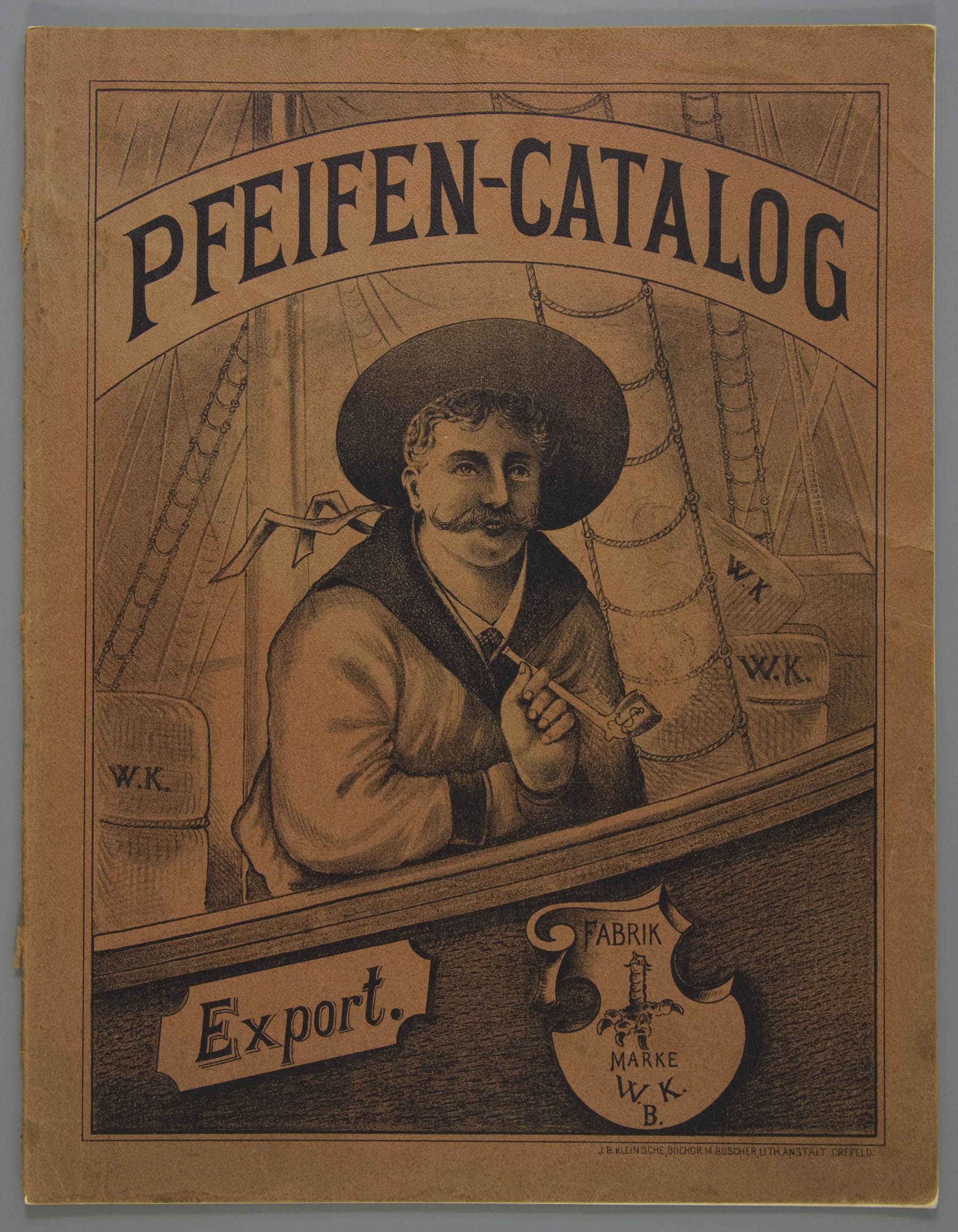

Some information has been added in thin block letters along the bottom edge of the cover. In the oldest version we read "J.B.KLEIN'SCHE, BUCHDR.MM BUSCHER, LITH.ANSTALT, CREFELD". To indicate who the printer was and where the printing plates were made. In the second edition the lithographer is no longer mentioned, only the name of the printer. More prominent is along the bottom edge: "NACHDRUCK VERBOTEN." (copying prohibited). In this way the manufacturer indicates that he owned the rights for publication and that the competitor could not simply copy his catalogue. Such a listing is rarely seen in catalogues, because the copyright on printed matter was not yet properly regulated by law.
With this cover a lot of effort has been made to achieve a graphically attractive image, but the result is still uninspired and amateurish. Reason is the limited realism of the drawing. For example, the sailor is of undetermined age, besides, he does not have a real sailor's head but looks more like a city person. Around the central figure the image is muddled by unclear masts and rope work of the ship next to the stacked packaged of merchandise. Powerful is the shield with the trademark of the bird's claw that is beautifully displayed with its asymmetrical curled scroll in the upper left corner. The typography is also strong in execution. The cover lacks realism and a strong three-dimensionality because it has insufficient contrast. At the oldest print, the sailor, together with the factory mark and the texts, is still dark against the light background. By copying the litho, this contrast is faded at the next printing, so that the illustration loses its expression even more. The sailor has grown thicker and with his soft face he is almost in the background. However, the boring cover design of the manufacturer's catalogue fits well with its content. Considering that the cover for each edition was drawn on litho stones again, it is surprising to see that the old and new version differ only in details. Apparently, the picture satisfied.
The printer from Krefeld is a known one. J.B. Klein'sche Druckerei supplied catalogues and other advertising material for countless companies. The advertisement on the front cover was suitable for their company. It gave the competitor the stimulus to have his catalogue printed there as well. In addition to printing, they were also publishers and even ran a bookstore. That meant they belonged to those larger companies that served all facets of the branch. They cooperated with other specialized companies for supply such as lithographs.
The contents of the catalogues
It is remarkable that the catalogue does not have any introduction. The first page starts with the illustrations of the pipes that can be ordered. Ever since 1830 it was customary throughout Europe that the first page after the cover mentioned the name, location and marks of the manufacturer. The French pipe makers in particular give in addition a full page with their so-called Avis. In this message to the gentlemen retailers the manufacturer guarantees the quality of the goods and promises to give vigilant care to every order. Often this letter is confirmed with the signature of the director or owner. If not this German catalogue. It is merely a picture book, nothing more and nothing less. Klauer may have taken into account that his catalogue was used all over the world. From Germany to West Africa, from Poland to North America. Many of his customers would not read the text anyway, unless it was written in their own language.
The content of both catalogues is printed on luxurious, rolled paper that is slightly shiny which we would now designate with art paper. The first print contains 17 pages, with the second printing increasing to 24 sheets. In both cases, the pages are printed on one side following the same regular arrangement of pipe models in contour. The illustrations are framed in a tight frame with the page number in the upper right corner. The reverse of the pages is left unprinted so that no annoying print through is visible. Then the separate pages are bundled with three or four staples, after which the booklet is glued into the sturdy cover. The booklets were then cut along the edges to browse pleasantly. This resulted in a traditional shape book, characterized by clean drawings, arranged in a well-considered layout. The result was well-cared for but deadly boring.
The style of drawing of both catalogues is identical. The lithographer worked in a robust, strongly linear way, certainly not aiming at the enhancement of the pipe shape. The lines are extremely straight giving away that they are drawn mechanically. Moreover, the thickness of the lines is heavy. Some depth effect is obtained by displaying the bottom line of each pipe thicker than the top line. The position of the pipes also suggests depth because you are looking into the bowl, shading in the bowl refer to a drop shadow. By never deviating from this method, there is a recognizable style that is anything but exciting.
178 objects are recorded in the first edition, of which 162 are clay pipes with a stem. Exceptions are nine pipe bowls for separate stems and seven shooting figures used at fairground attractions. The second edition is considerably expanded and illustrates 262 objects, of which the pipes with clay stem are in the majority with 222 copies. The pipe bowls for separate stems have grown to 24 pieces while the group of shooting figures has remained the same. Added are nine additional articles including eight whistles and a miniature cup. The two different prints compared show us that nine pages are identical (red: 2, 4, 6, 7, 8, 10, 11, 12 and 13 against green: 4, 5, 7, 8, 9, 11, 12, 13 and 14) . Also the page with the shooting figures is unchanged. When pages are changed, this usually does not involve major differences. Sometimes only one pipe has been added or a pipe model has been changed.
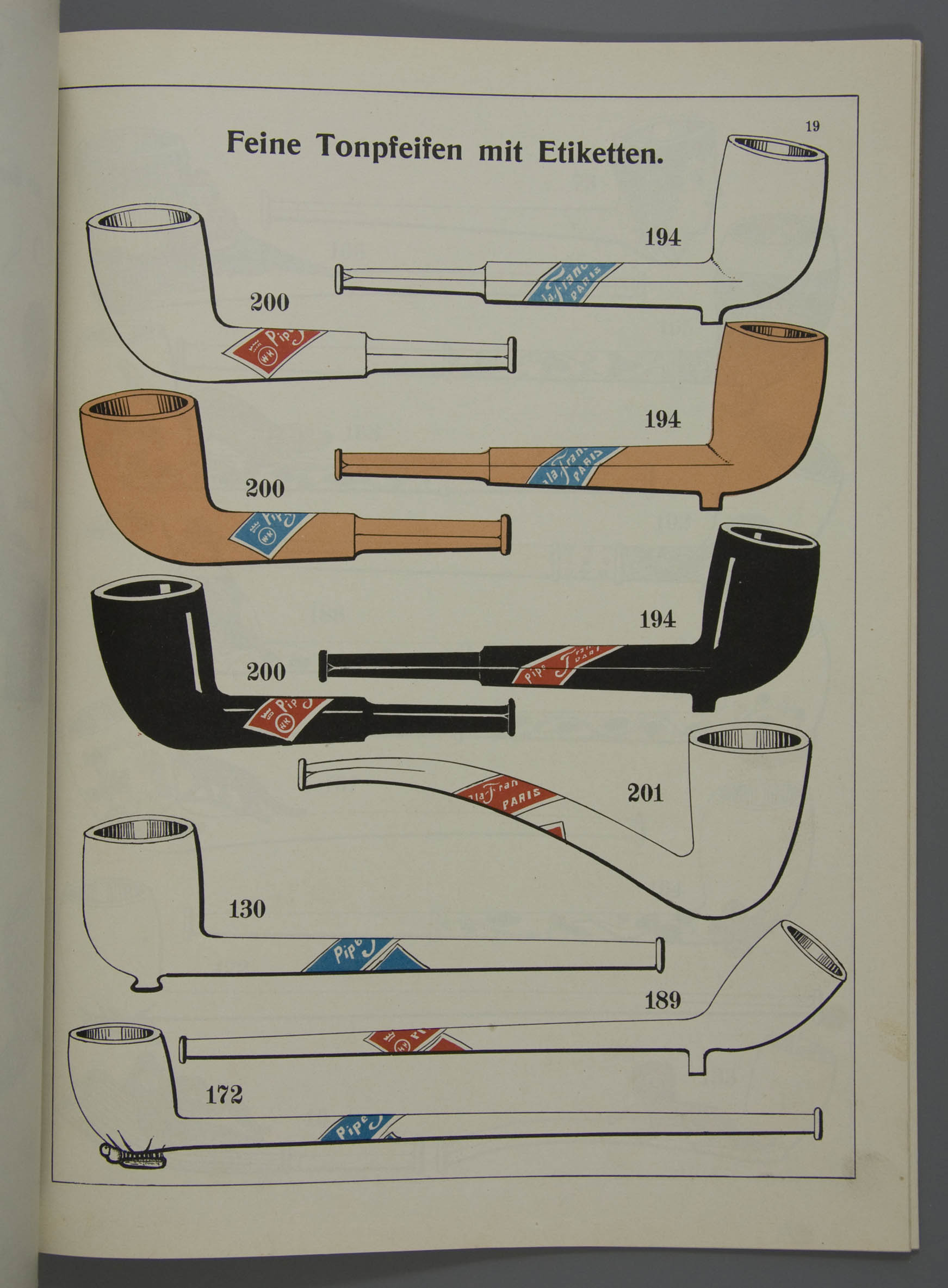
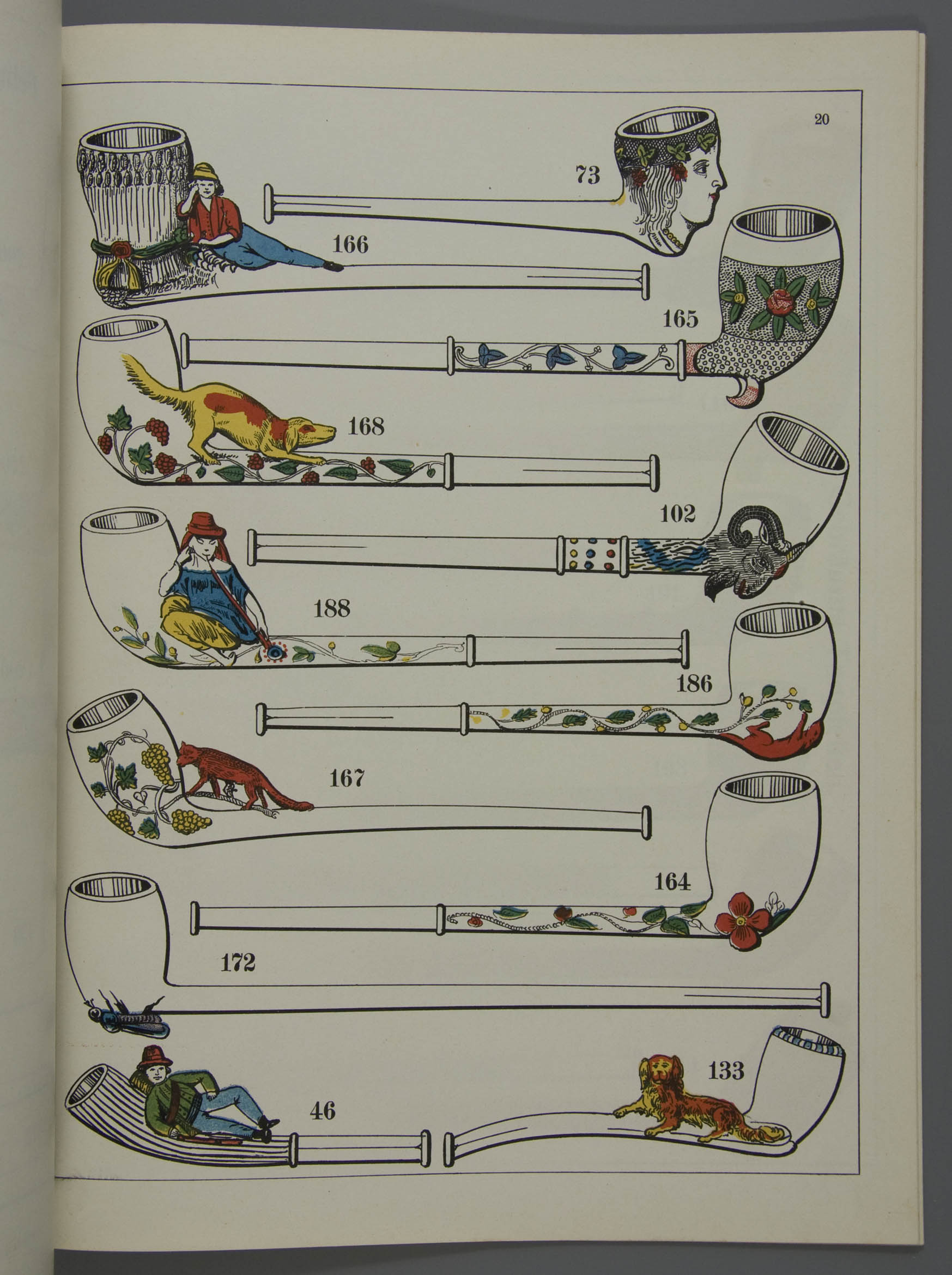
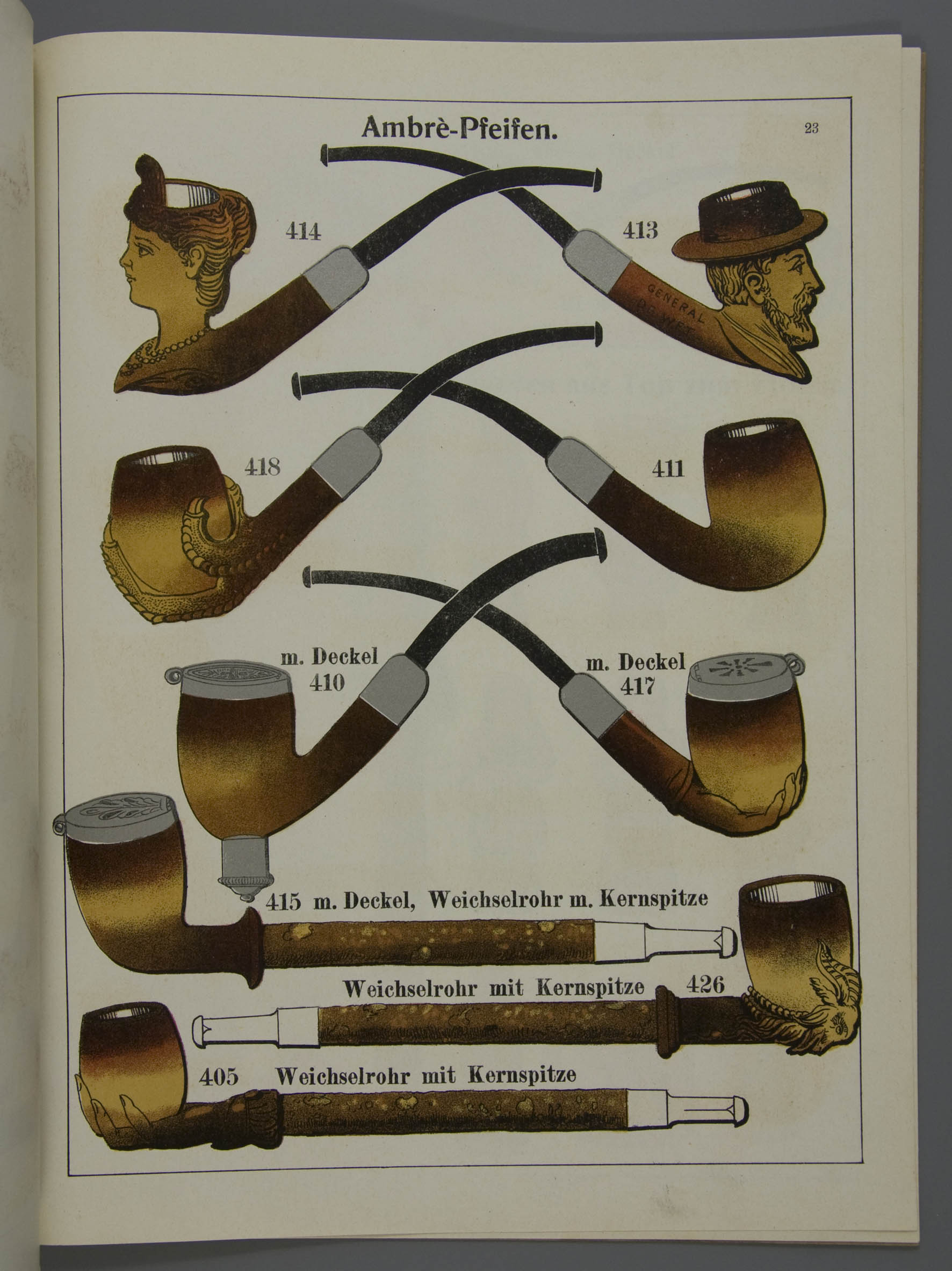
A distinction is furthermore that the additional shape numbers in the second print are larger and fatter, as if they are printed in lead typesetting. This heavy typeface makes the numbers more intense. That it did not always work well when making the lithographs proves page 3 of the second edition. There the numbers of two undecorated clay pipes, 156 and 171 were interchanged. This error has been corrected by pasting these numbers with a small piece of paper on which the correct shape number is printed. Such a cumbersome way to repair a mistake proves once more the importance of the shape number for the manufacturer. Shape numbers were the reference in correspondence about orders and should never lead to any confusion.
The shape number was used as standard reference in trade and the factory was therefore extremely diligent about it. The stemmed clay pipes have numbers from shape number 1 to just over 200. The pipe bowls are placed in the four hundred series, so with almost 200 shape numbers vacant to allow later expansion of the assortment in stemmed clay pipes. The series of stub stemmed pipes has been kept relatively limited, these were too luxurious for the type of customer of Wilhelm Klauer & Sons. It is remarkable that the shooting articles and figurines are not provided with a shape number. This gives the impression that they were sold assorted.
The most important addition to the old printing is a colour section. Six colour pages were added in the second edition that show the different finishes of the clay pipes. At the beginning of the twentieth century, colour printing was still a big luxury with limited use. Colour printing was strongly cost-increasing and commercially hard to reimburse, although this did have a high attention value. With this catalogue the colour is very functionally, namely to show the different finishes. In the first colour page (page 19), the black and white changes very subtly when two red pipes are displayed together with two solid black printed examples (Fig. 3). On the same page we see coloured stem labels on other pipes. The colours red and blue alternate. In a subtle way, with a few colour accents, the black and white changes into colour.
The second colour page shows twelve brightly painted embossed clay pipes (Fig. 4). The manufacturer refers to French fashion both in terms of shape and use of enamel. Incidentally, the three pipe shapes are identical to clay pipes that are also depicted elsewhere in the catalogue. These colourful pipes are recorded without any comment, they apparently spoke for themselves at the time. The next page, page 21, shows Glasierte Tonpfeifen und Gebräunte Tönpfeifen, each with six pieces (Fig. 5). The colouring of pipes was a specialism of Wilhelm Klauer. Especially the tinted lead glaze pipes show a special luxury that we know from very few other companies (Fig. 6). Their bright, radiant colours are even now a joy for the eyes. The plain, tanned pipes in brown, internationally known as torrified clays, are less specific to Klauer. In view of the simpler finish, they were also a lot cheaper. Klauer experienced great competition from other companies.
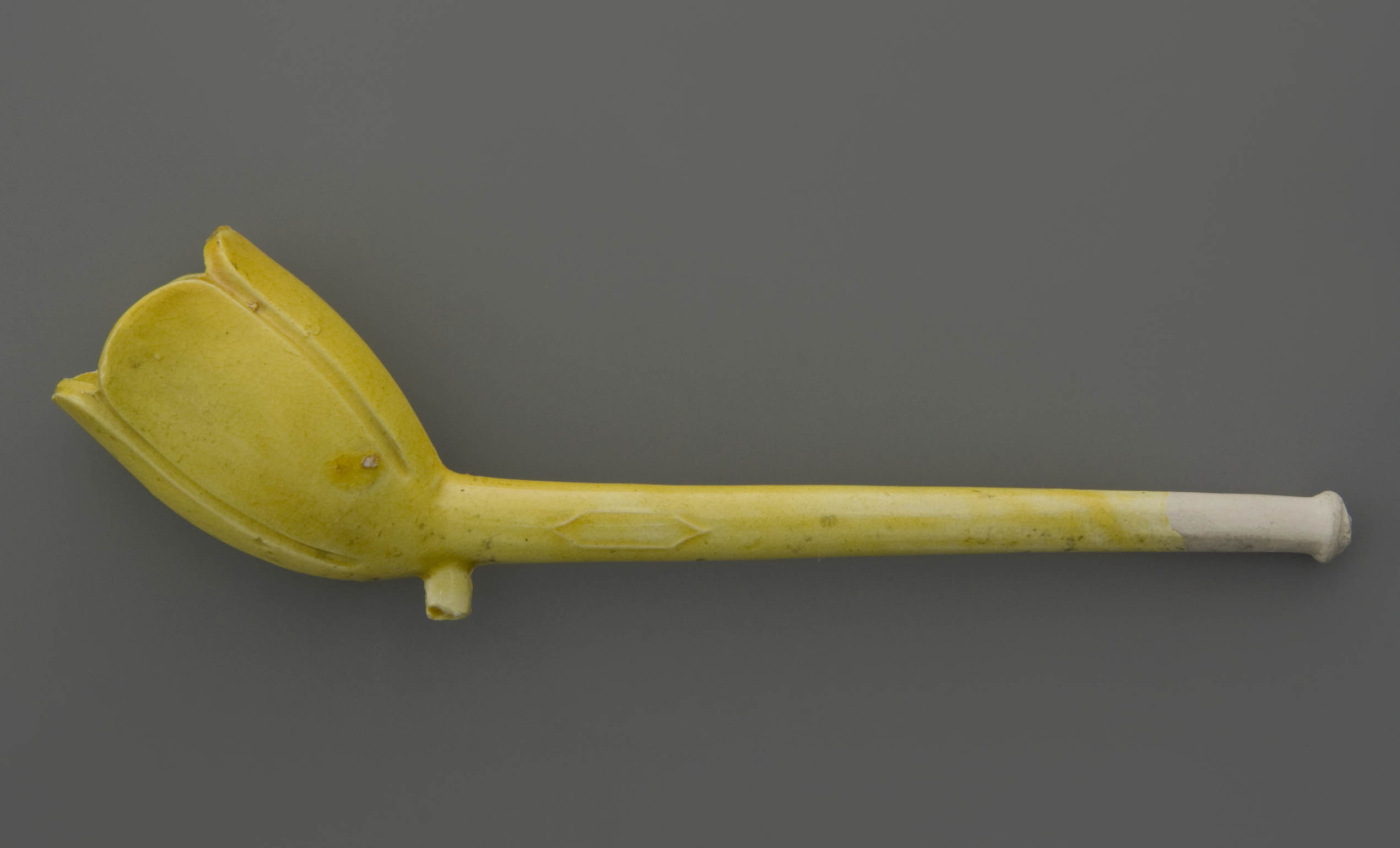
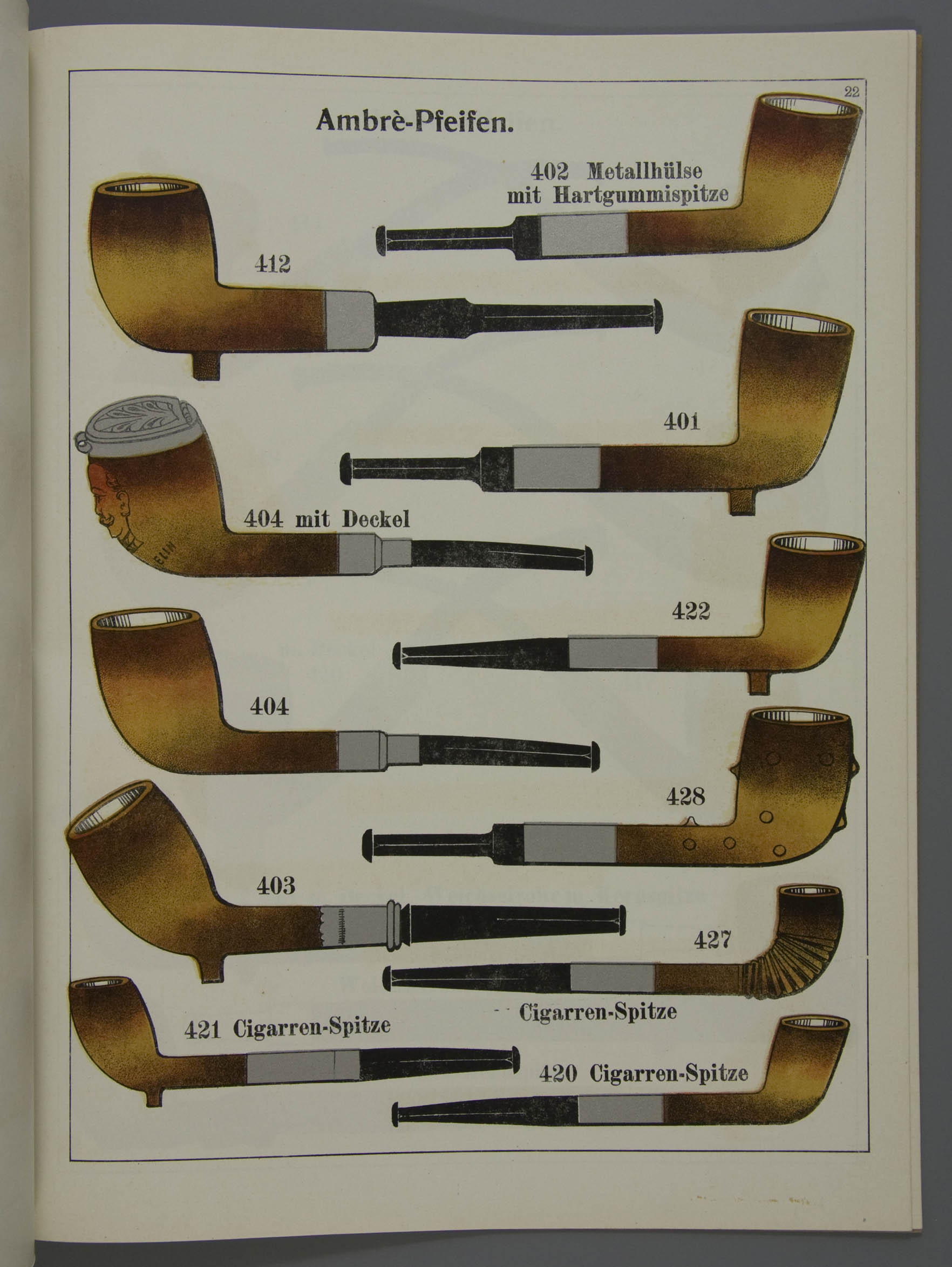
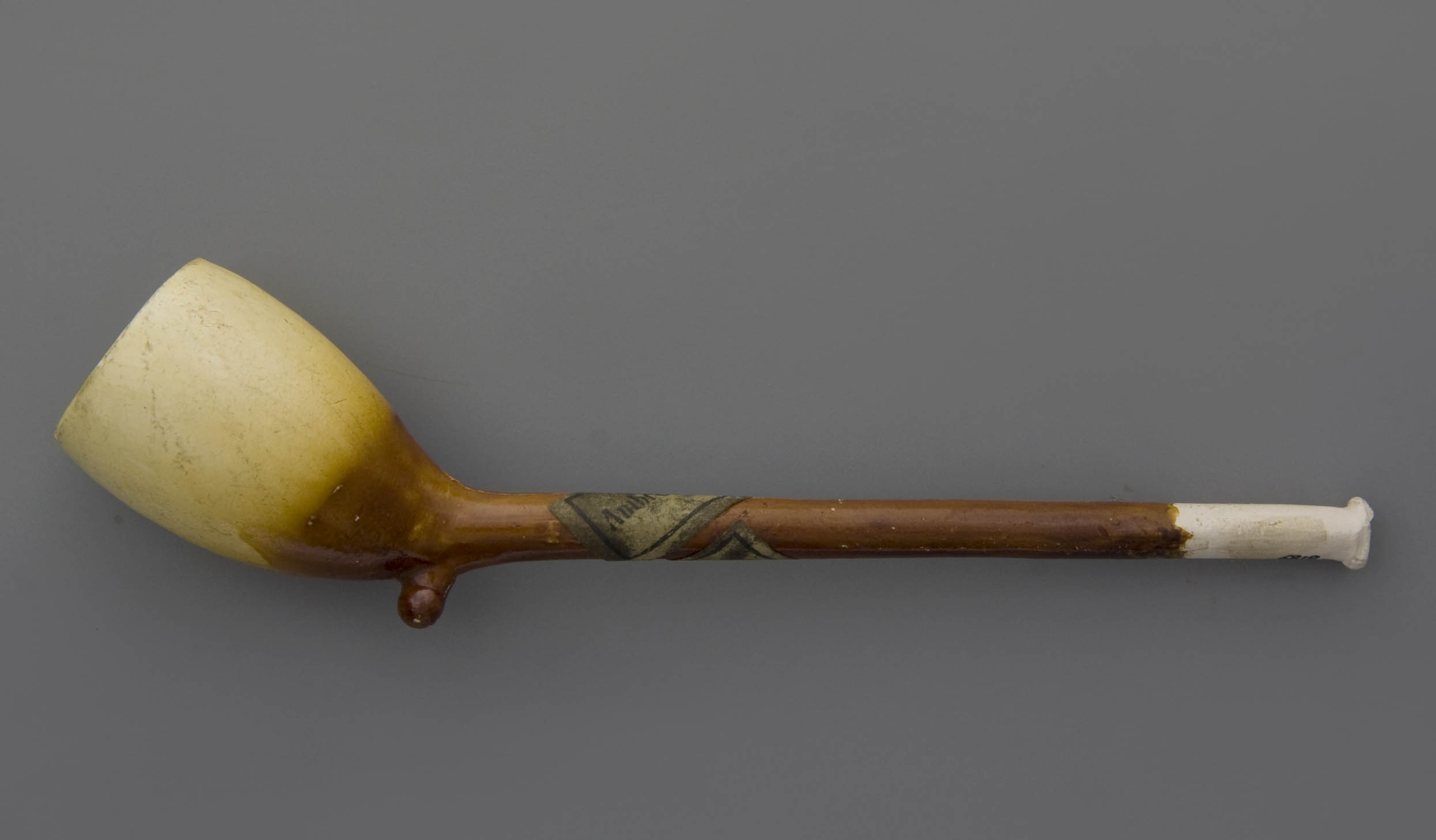
Then follow two pages, numbers 22 and 23, on which calcined tanned pipes can be seen (Fig. 7). These are clay pipes covered with a yellow lacquer, which are burnt dark brown at the rim of the bowl and sometimes also at the stem. With this finish they resemble from a distance smoked meerschaum. Here we read above the page Ambrè-Pfeifen, but of course is meant ambré, although the dash could also be omitted. This mistake by the lithographer indicates that he had trouble in reproducing letters correctly. All three of these calcined pipes have metal mounts, finished with a hard rubber mouthpiece (Fig. 8). Only the last models have a cuff and are provided with a cherry wood stem ending in a horn tip. The last page is number 24 (Fig. 9). Various products have been brought together here. Six pipes of varying nature, including three red bowls with a cuff. Furthermore, the famous Kaffeehauspfeife is depicted here, a very distinctive German clay pipe that is represented in every German assortment. In addition this page contains nine red curiosities, the latter category often decorated with a lick of colourful paint. They will be discussed later.
More details about the assortment
Browsing through the catalogue, we see that the Wilhelm Klauer & Sons company, at the beginning of the twentieth century, offered a reasonable range of clay pipes with a strong unity in terms of shape and decoration. By German standards he did well. However in a boring display, the product catalogue offers a wide choice. On the first pages the well-decorated ornamental pipes are included, related to the French figural clay pipe: some portrait pipes and other highly decorated specimen. Gradually this changes into regular tobacco pipes, some with a relief decoration following the shape of the bowl. A separate page is reserved for the longer species that are shown lengthwise instead of across the width of the page (Fig. 10). They disturb the rhythm of the catalogue, but you could also argue that they just enliven this. In the catalogue the larger tobacco pipes are followed by shag pipes with smaller bowls. The number of clay pipes shown goes from ten to twelve per page, in six well-filled pages. The importance of this category was considerable, especially for exports to West Africa. The smaller number of pipe bowls for separate mounting, together with the curiosities and the shooting figures are in the back of the catalogue. For Klauer, this is an enlargement of their assortment, nevertheless with an additional interest.
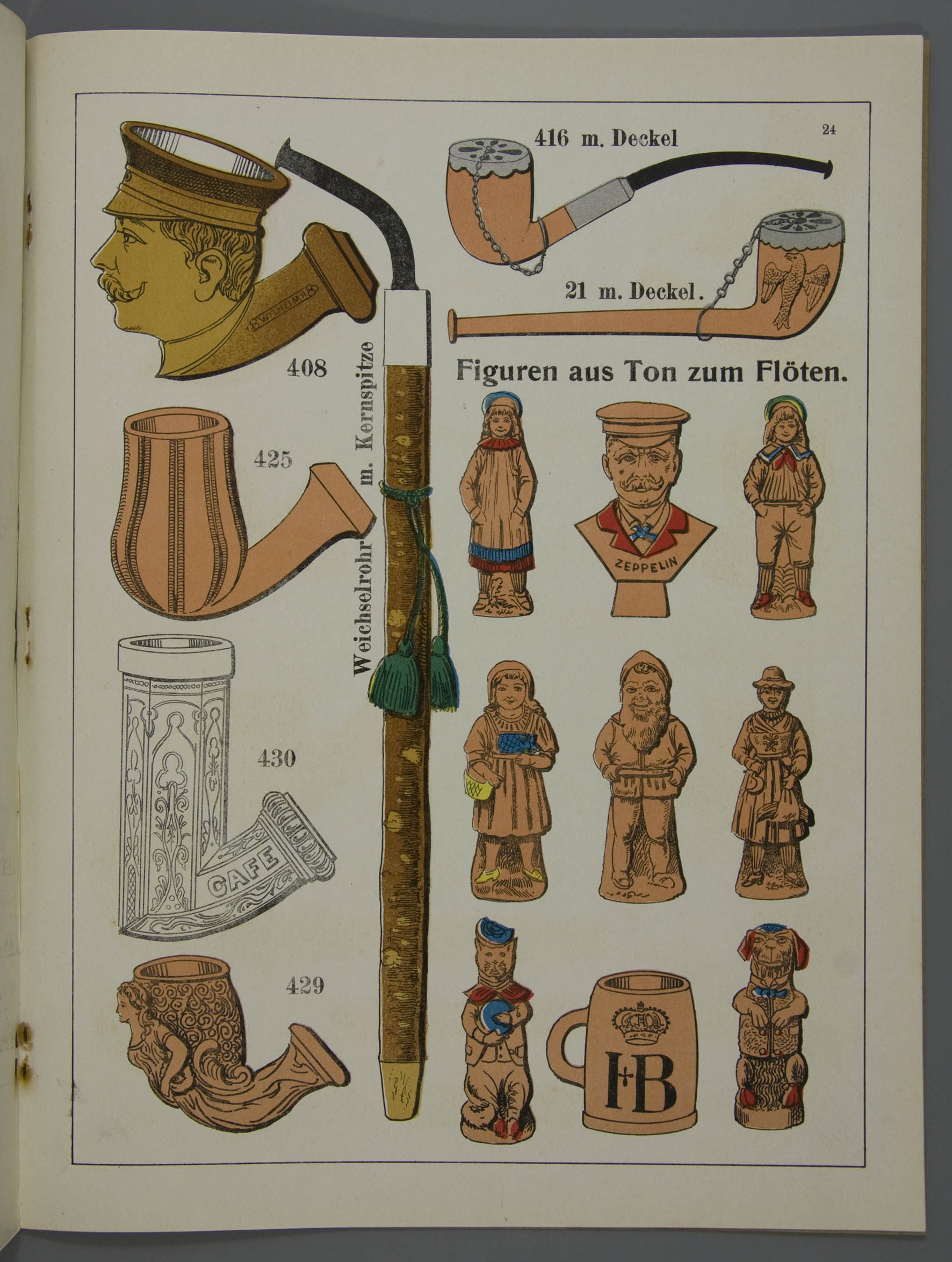
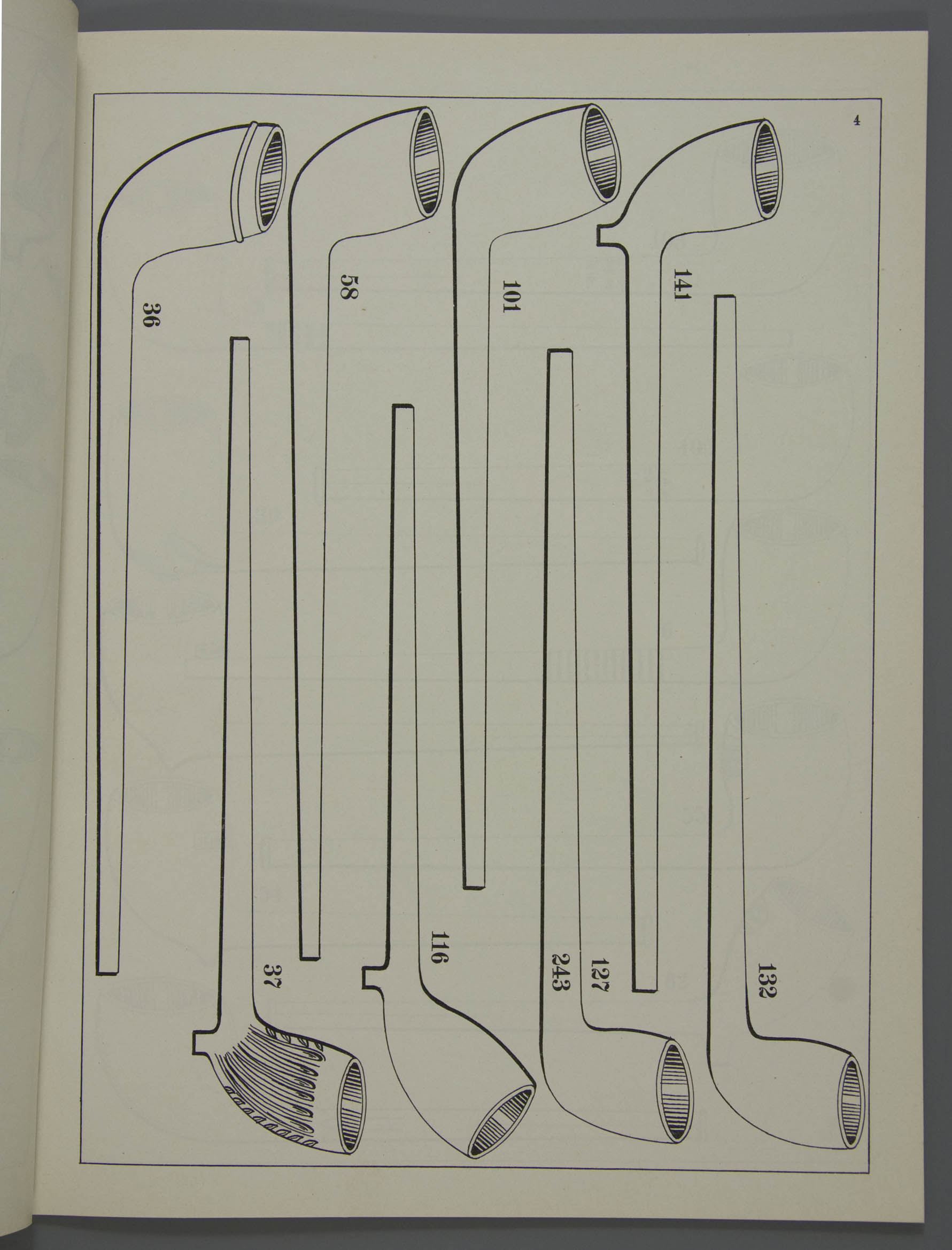
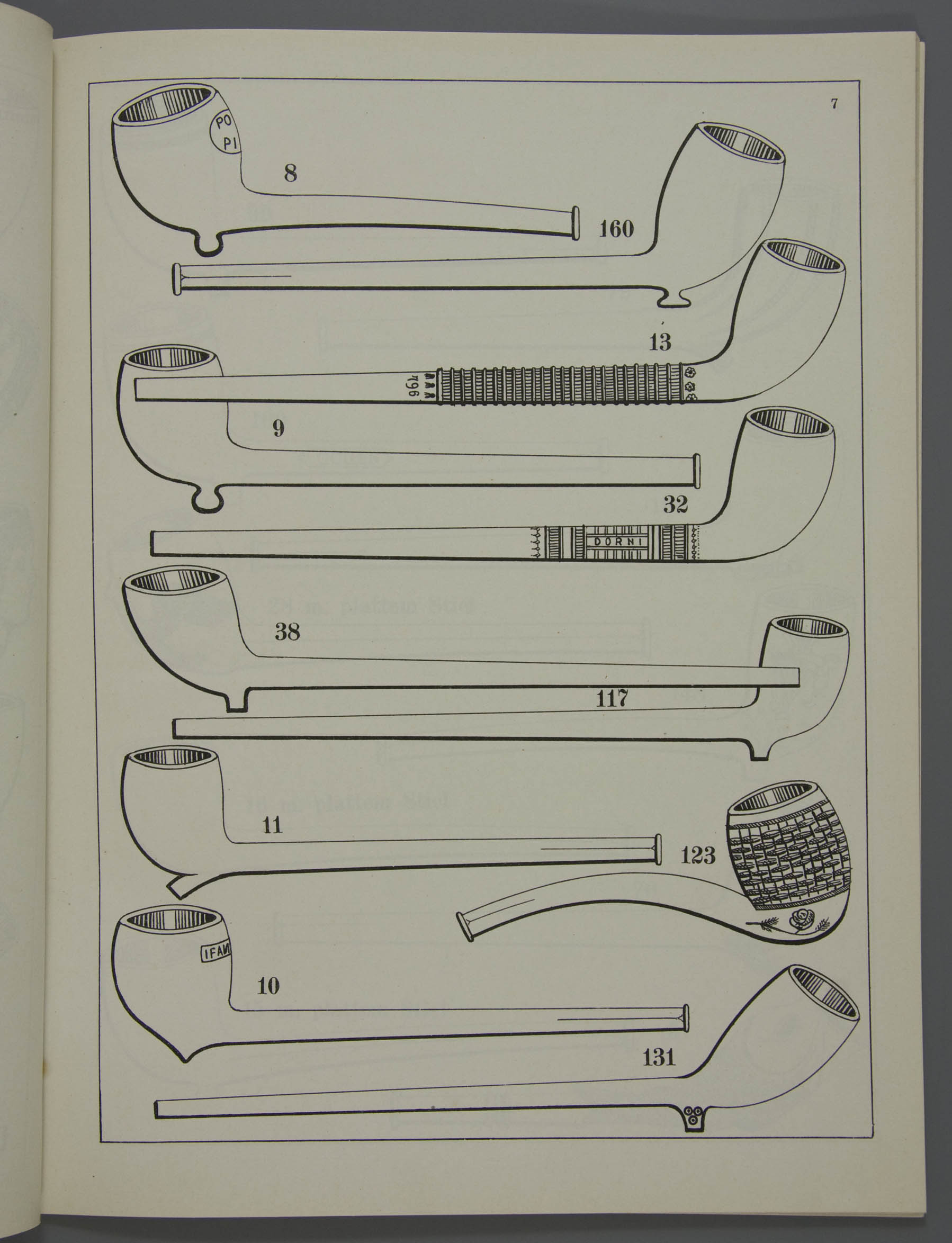
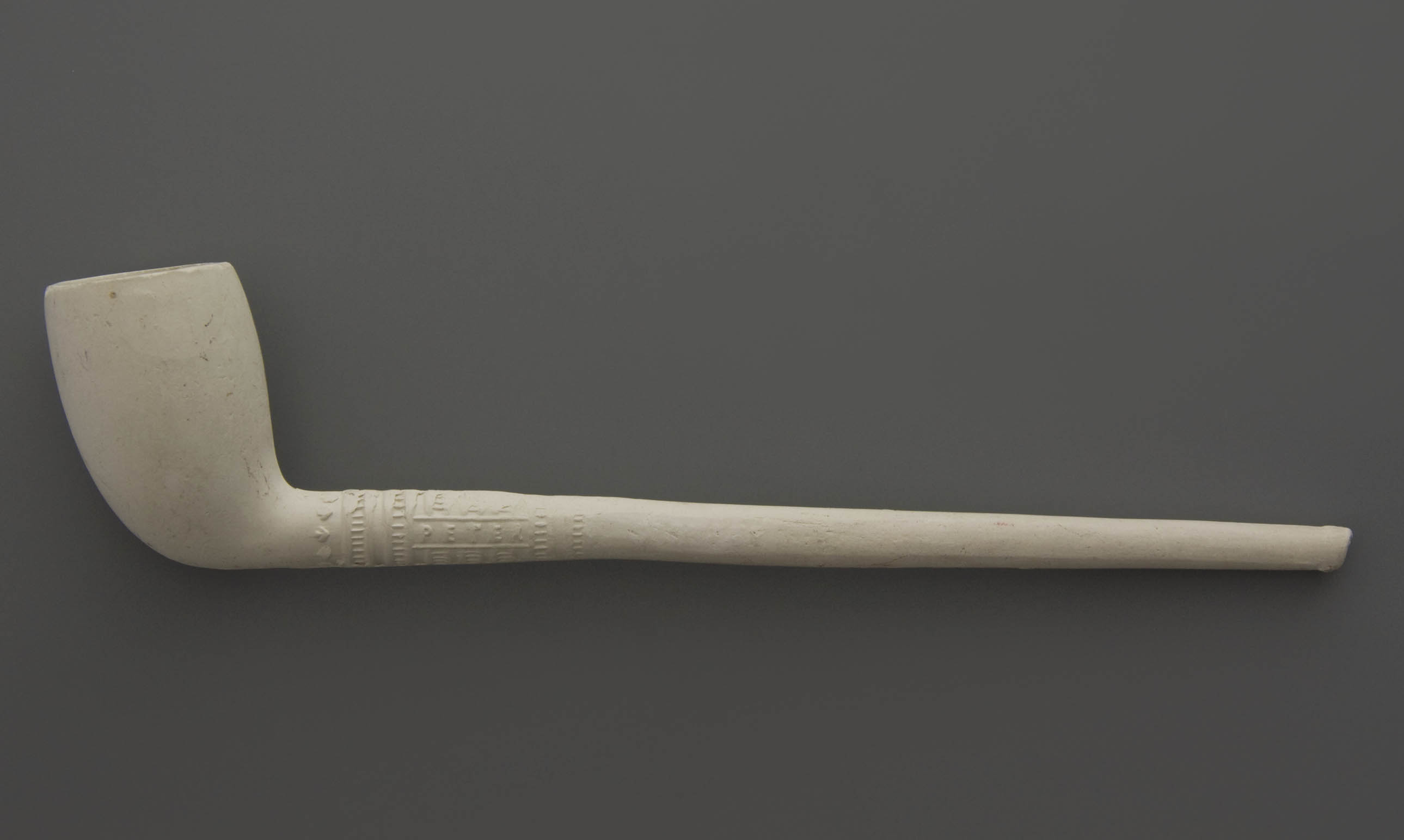
There is very limited attention paid in the catalogue to historical German, or if you like Westerwald pipe shapes . Examples of these are the Peter Dorni pipe (shape 32), that had an unprecedented demand as an export item to the United States, presumably mainly to emigrated Germans (Fig. 11). This shape was conceived as early as the eighteenth century and remained available throughout the nineteenth century at numerous workshops (shape 9, cf. Fig. 12). A second clay pipe has a very similar history. The stem text has been replaced here for a geometric band with the date 1796 (Fig. 13). The meaning of the year is still unknown, it is possible that it was adopted from late-eighteenth century pipe shapes without the underlying idea. This pipe shape with the same year was also produced by other factories. We can question what the consumer thought of these clay pipes and whether the smoker could give an explanation to the inscription of the year 1796. More logically, the customer will have chosen the clay pipe because of the high beaker-shaped bowl and the stem decoration was taken for granted.
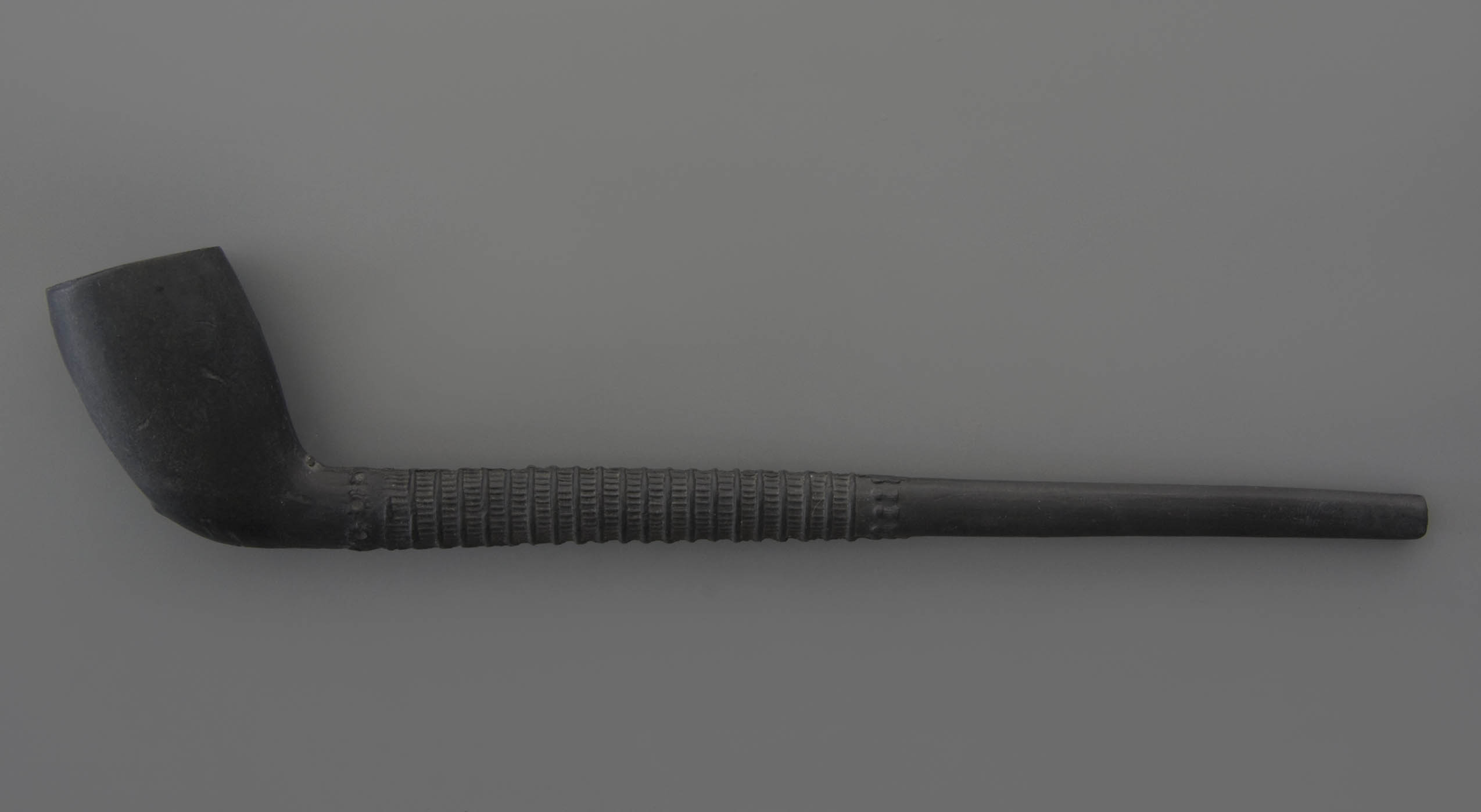
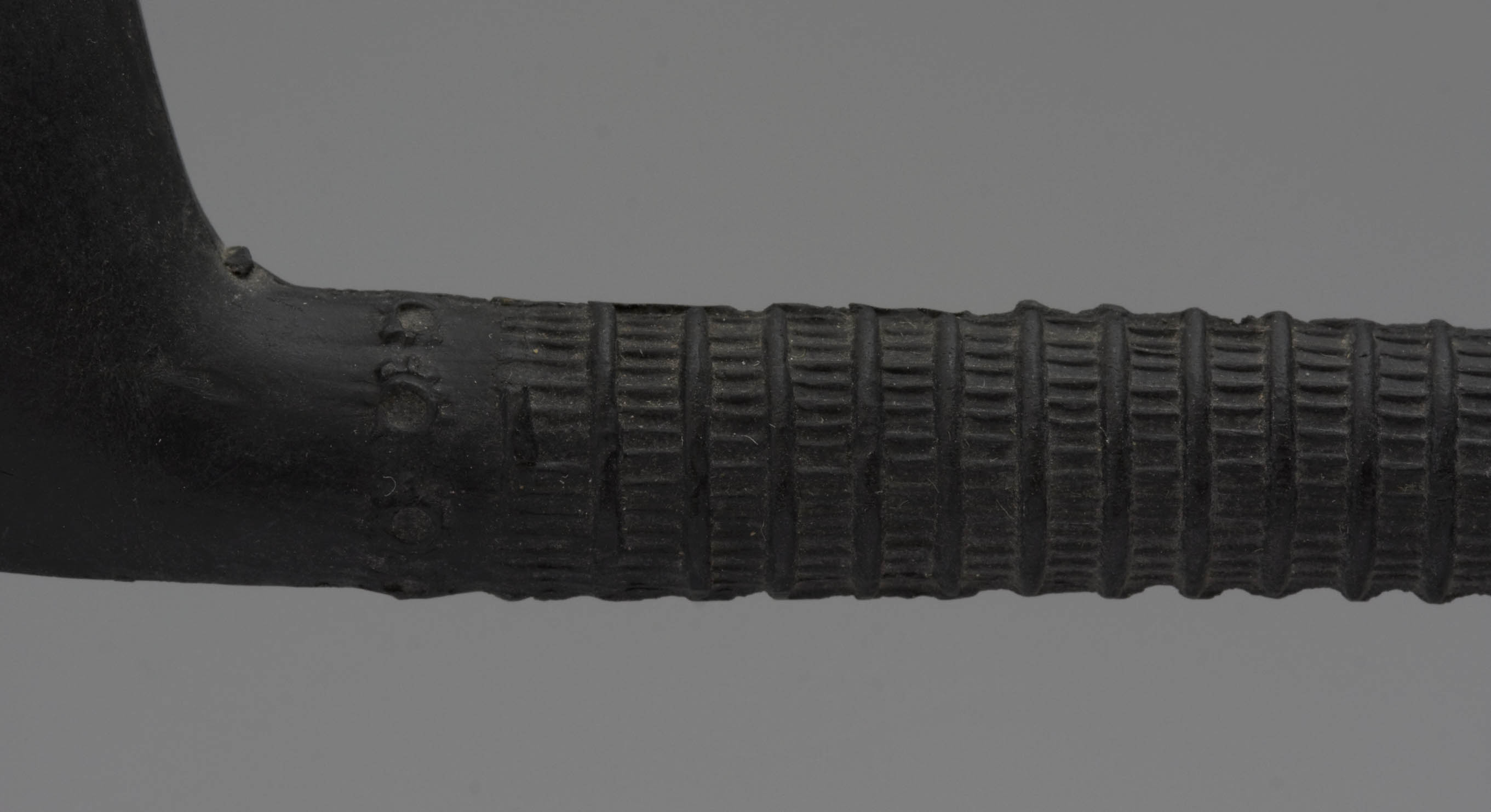
Noteworthy is that there are only five Gouda pipe shapes in the range, characterized by an oval bowl with a heel at the transition to the stem (shape 40, 41, 116, 131 and 189). In addition, we find three shapes derived from the Gouda shape: the numbers 62, 68 and 96, respectively one English and two French interpretations of the Gouda pipe bowl. Pipes with the distinctive oval bowl were apparently hardly in demand at Klauer which doesn’t surprise. The oval bowl is particularly effective with a long stem and that is something the German companies were not good at. For the short stemmed pipe, the oval bowl had lost its importance around 1900.
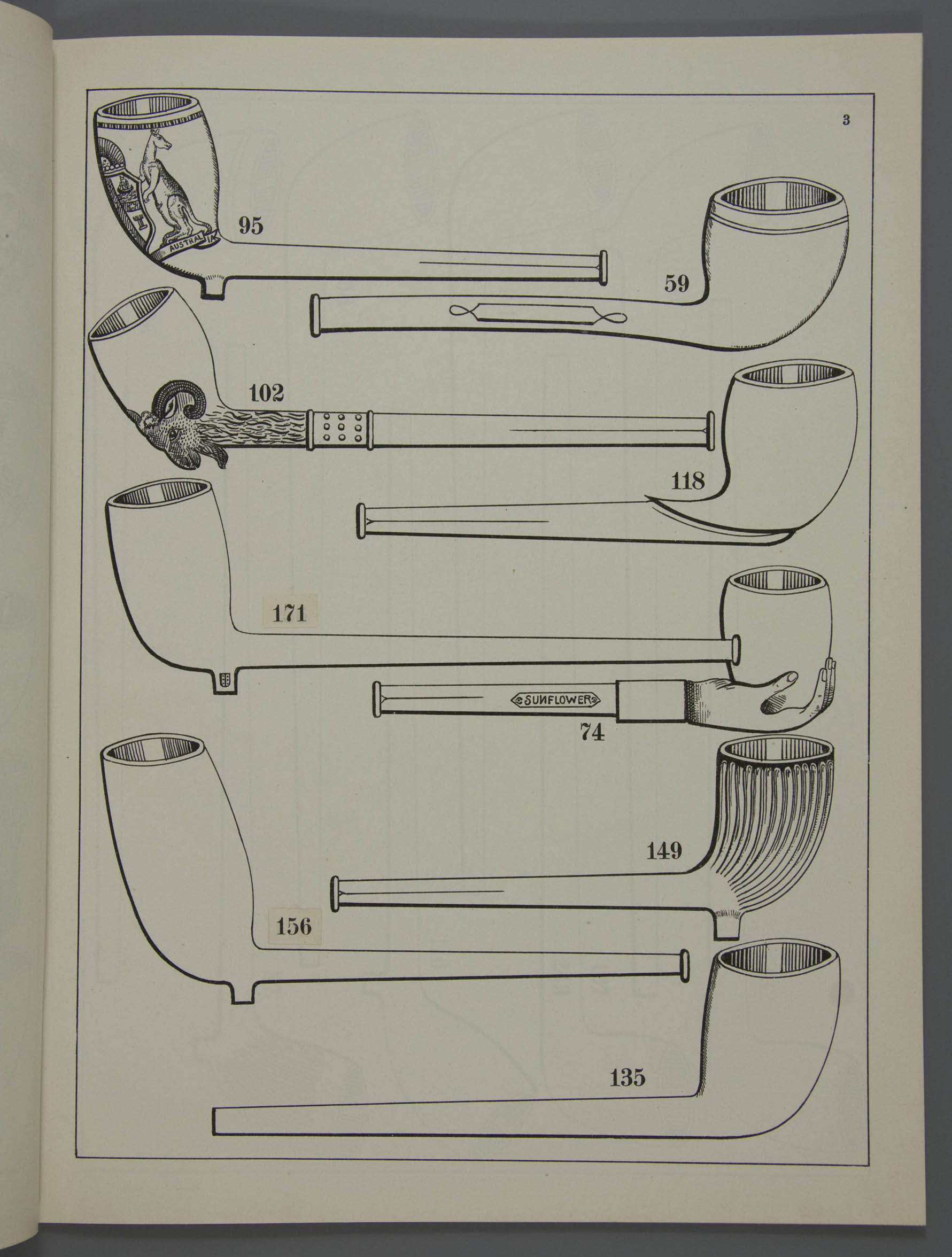
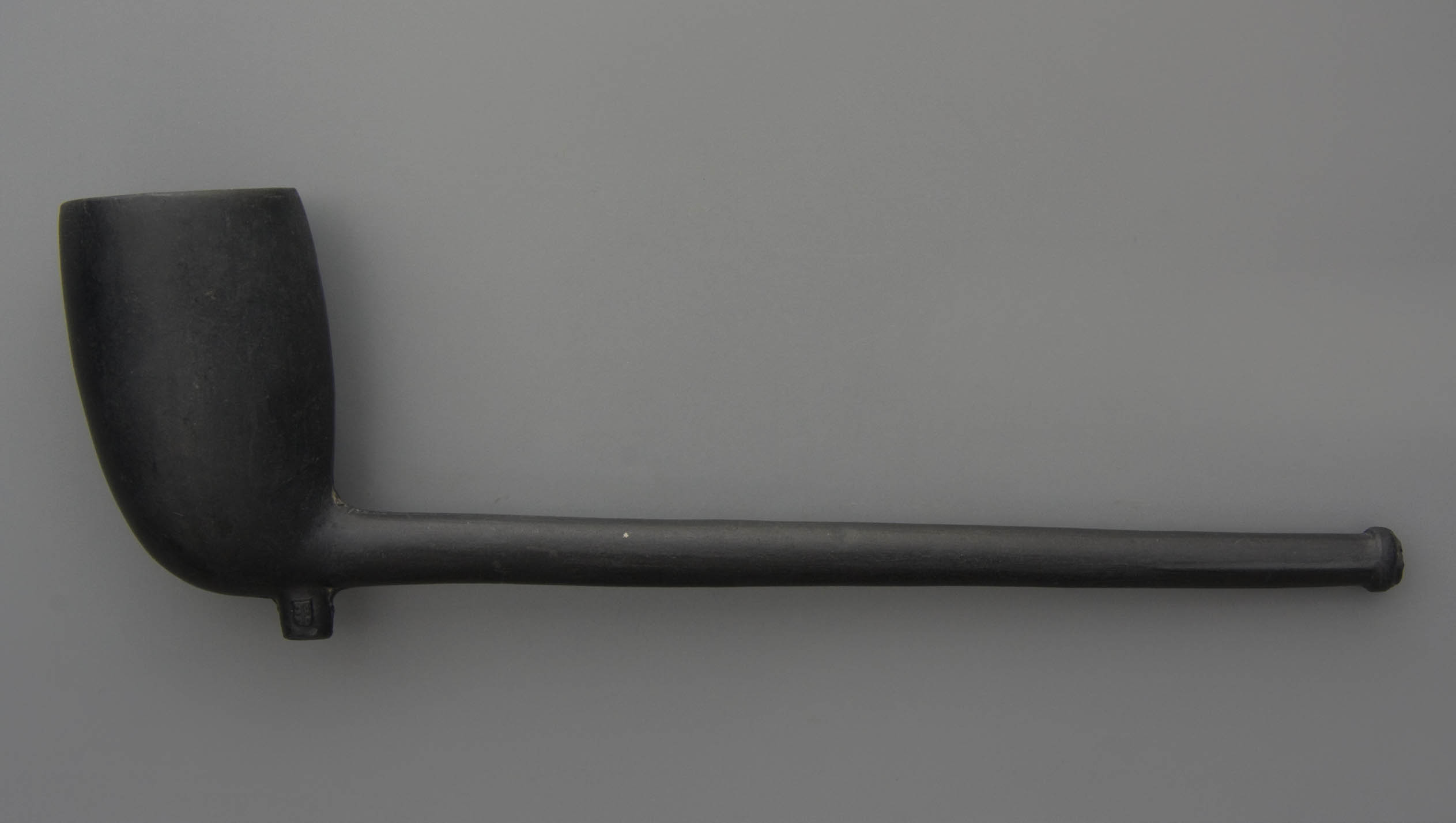
The curved styled pipe bowl, on the other hand, is very prominent in Wilhelm Klauer's catalogue. Here it is not only the original eighteenth century shape but also the countless shape varieties from later years. Again, the bowl shape is remodelled, so we see variations that betray influences from other centres. Model 171 is still very much Gouda-like, including the Gouda mark on the heel side, although it is a nineteenth century large size (Figs. 14, 15). However the characteristics are still present, in many specimens there is a striking adaptation with for example a strong lying bowl (shape 131), knob heel (shape 160) or flattened stem (shape 15). An Irish version of the curved bowl shows a thick bowl wall with milling around the fire opening (shape 84, 99, 100, 114). All these changes point to the internationalization of the pipe shape in which influences from other centers are taken for granted.
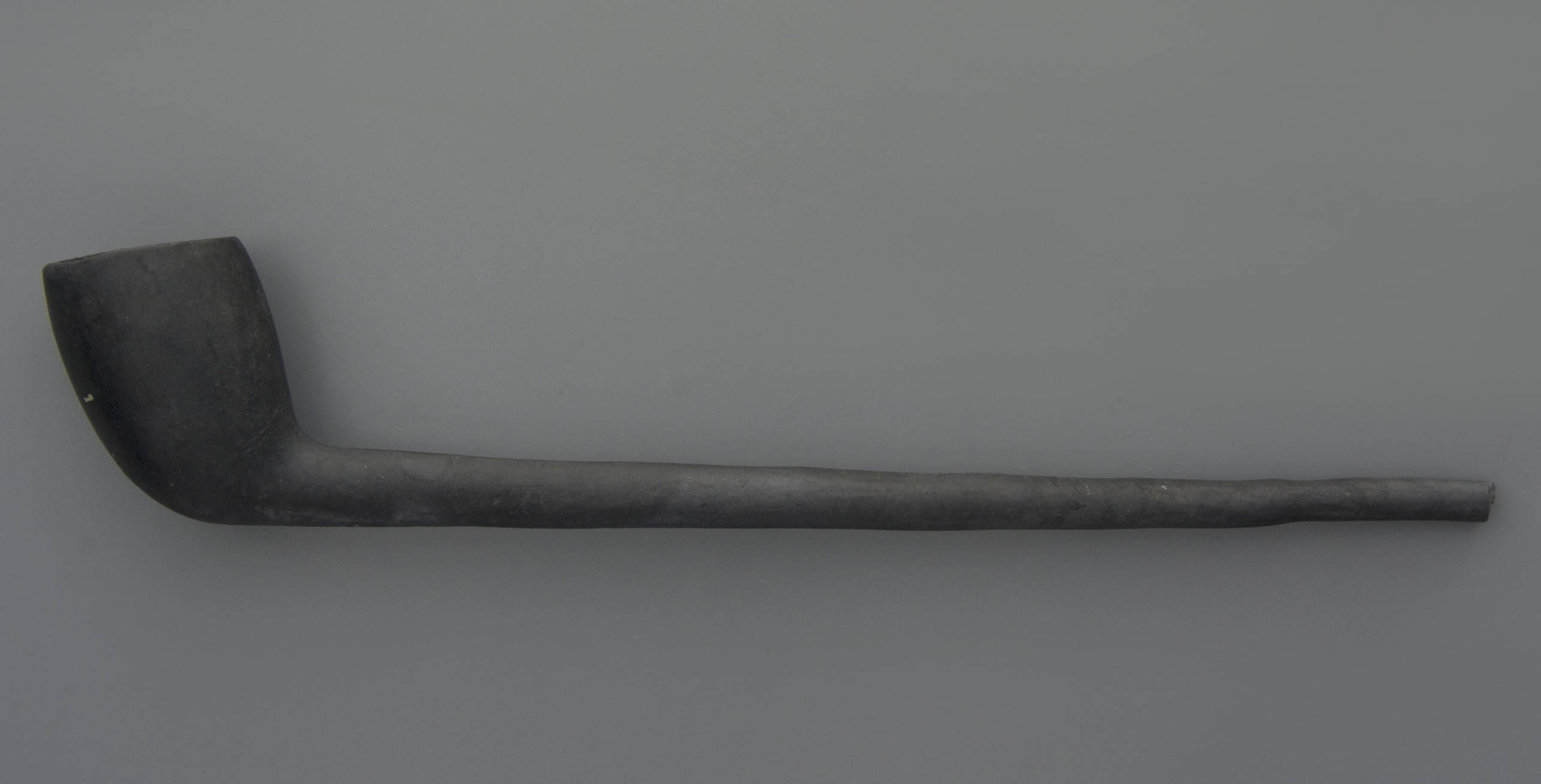
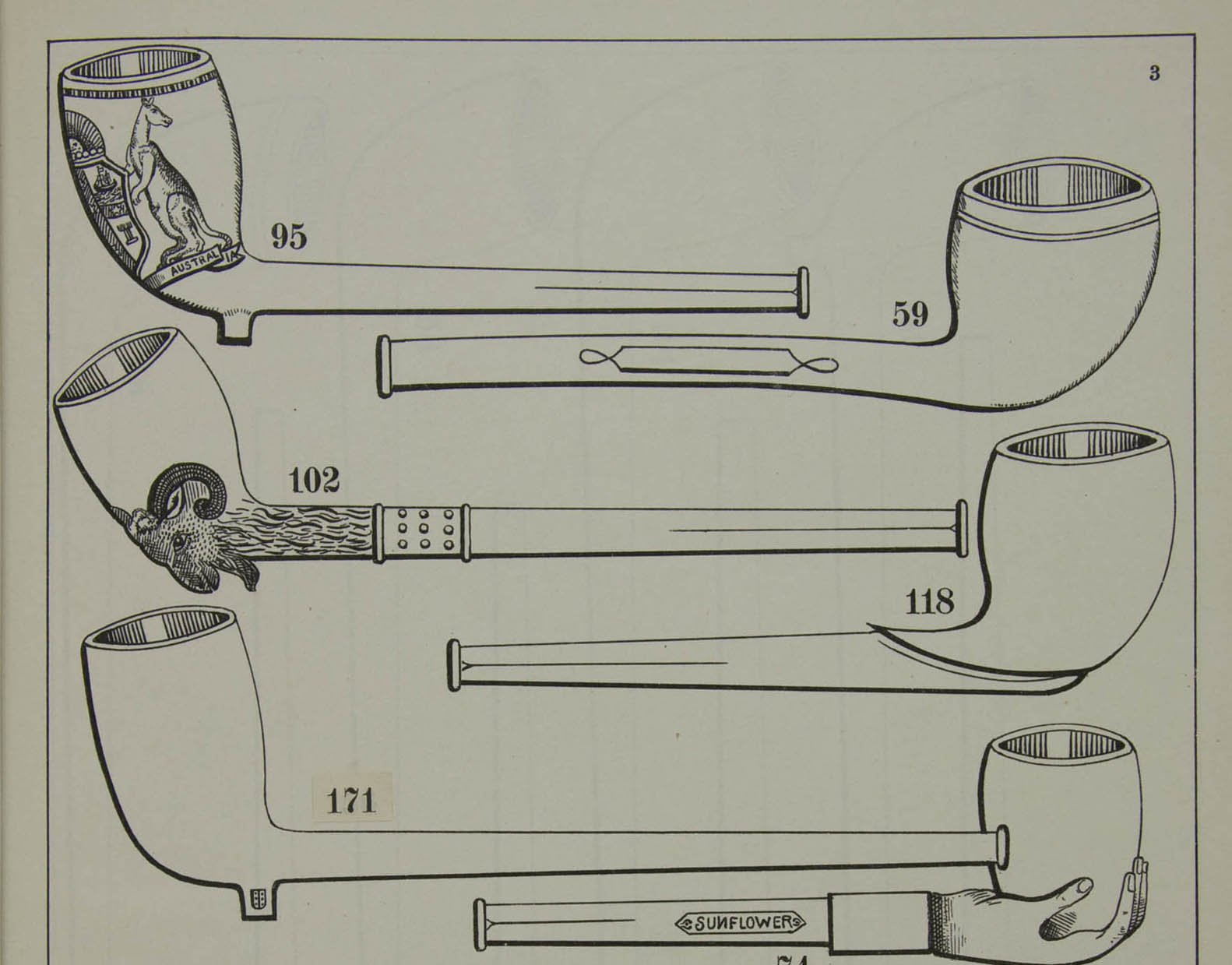
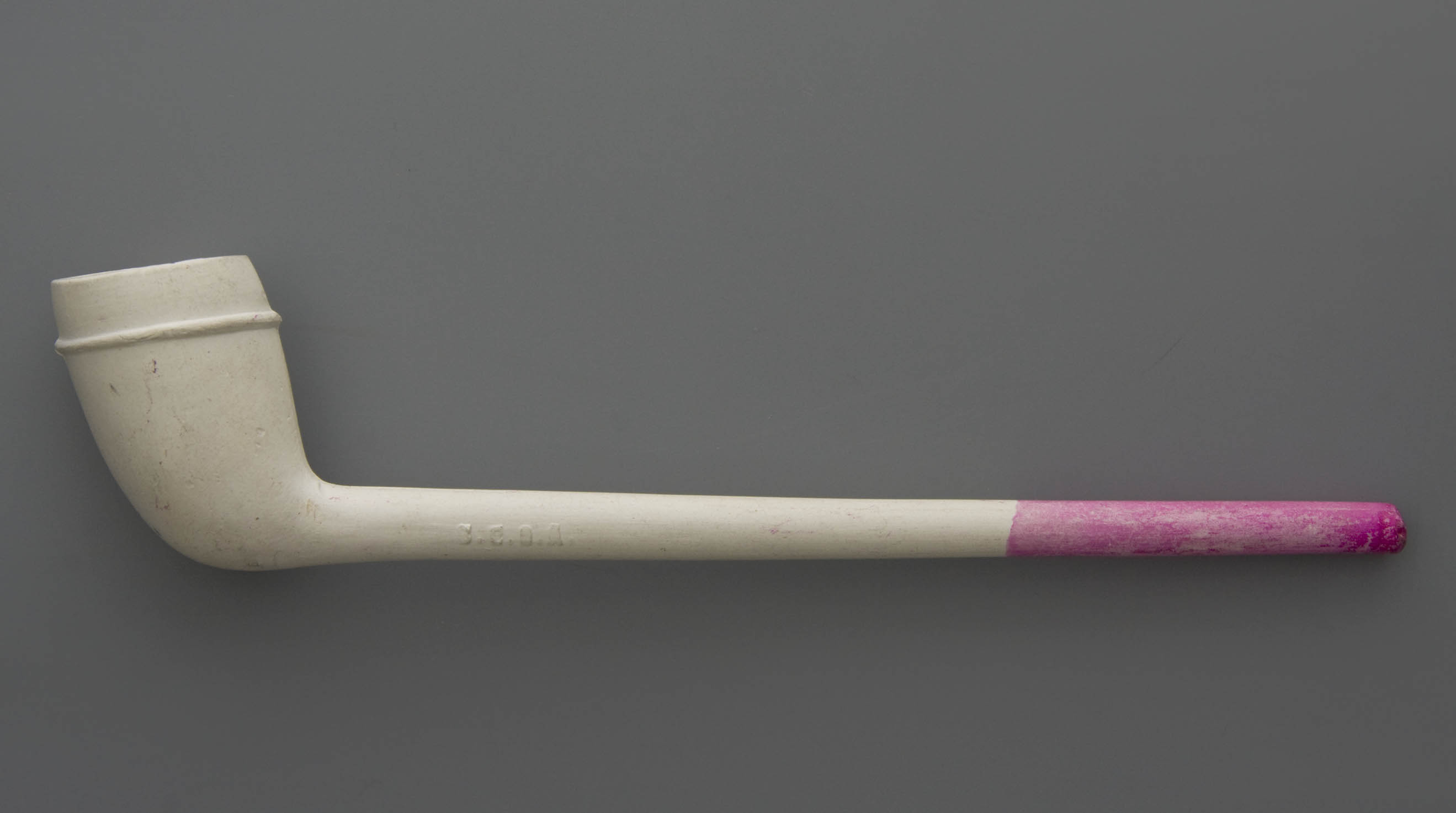
The clay pipe without a heel, originally derived from the Gouda kasjotte, had a strong development during the nineteenth century. All the heelless shapes have completely lost the eighteenth century dimensions. The bowl is much wider and significantly less high. The so-called Duitser (or German) (Fig. 16), also called Pipe Paris (shape 58, 101, 135 etc.), we see in a wide variation. It has been the most popular export pipe for the Westerwald and has been made in all other pipe-producing centres as a competitive item. Typically time-bound and typical Westerwald is the randduitser (shape 36, 59, cf. Fig. 17), with a full German shape now with a smooth embossed ring under the bowl opening (Fig. 18). They too have been exported at large numbers. With their somewhat shapeless appearance, plain cut of bowl opening and the lack of a marking between bowl and stem, these pipes are rather rough and irregular, so real bulk production.
Many other shapes without heel are direct copies of English short pipes, generally known as cutties. Although Klauer claims the copyright on the catalogue, he commits a remarkable amount of plagiarism. We notice it not only in the shapes but also in the decorations. This will be discussed in detail later.
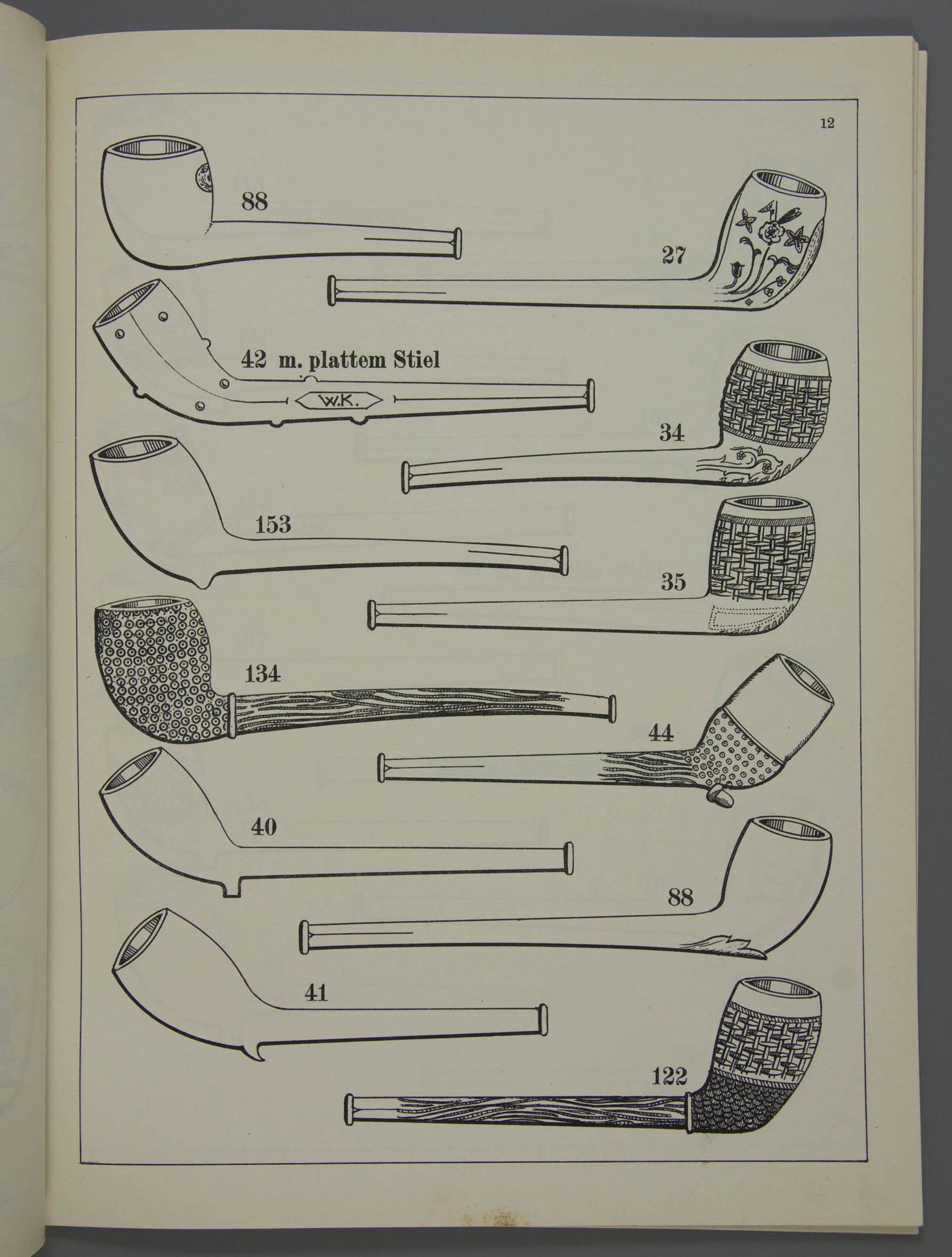
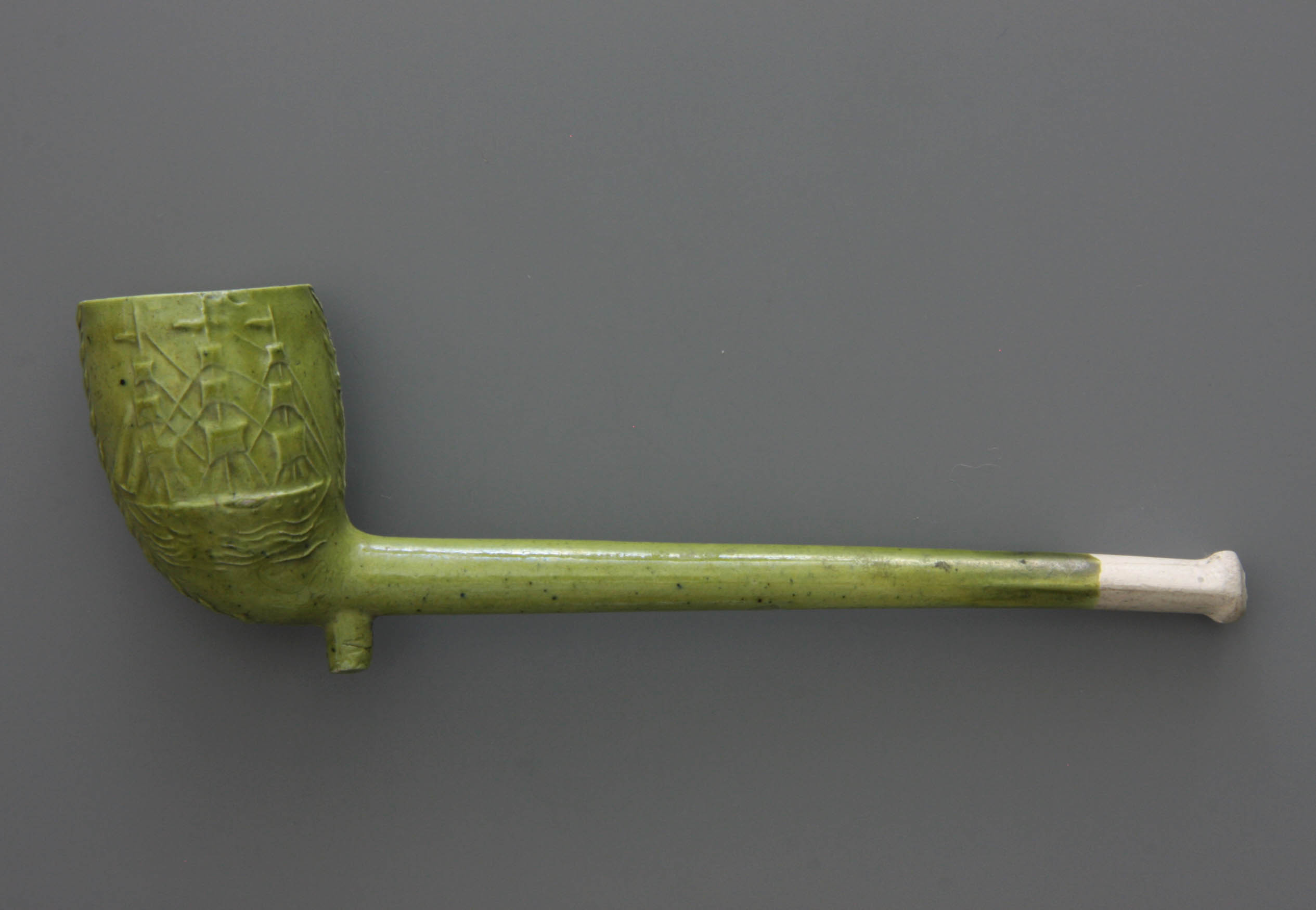

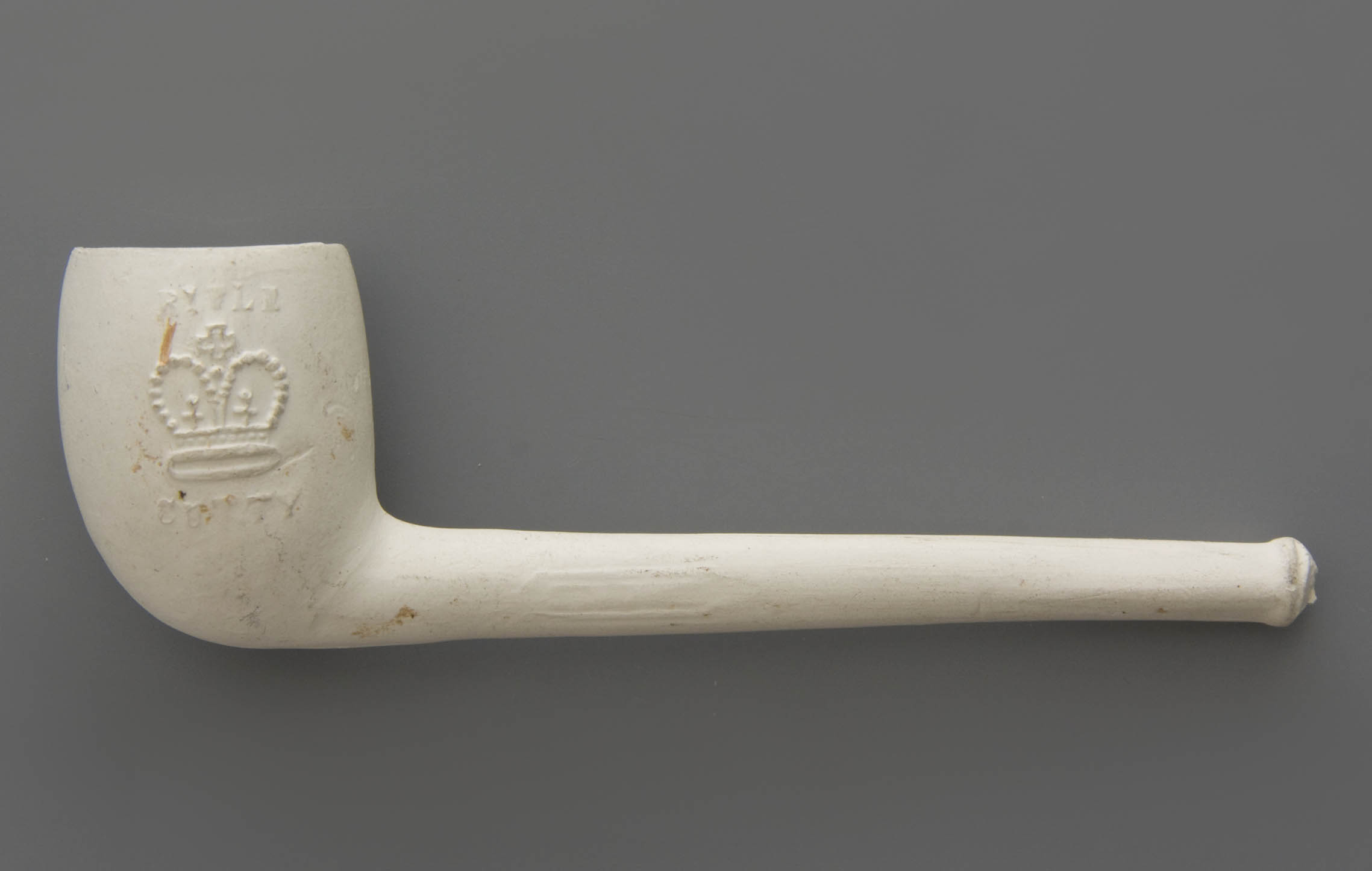
It has already been explained that shag pipes for Klauer are a separate group. The shape range is clearly more modern than with the tobacco pipes. Not surprising because this group was later invented so no outdated models occur. Moreover, the small size requires a greater elegance, something that we see in the relief decorations as well (Fig. 19). Modest but very popular decorations are baskets (shape 76, 77), the combination anchor and ship (shape 151, 157, Fig. 20) or a fine decoration of fluted lobes (shape 129, 139). Other examples show bands with dots or pearls (shape 142, 193). Some motifs seem more English, such as the crown of the English kingdom with thistle leaves (shape 106, Fig. 21) or only the crown (shape 159, Fig. 22). A typical German symbol is the eagle with spread wings (shape 21), a decoration also popular for export.
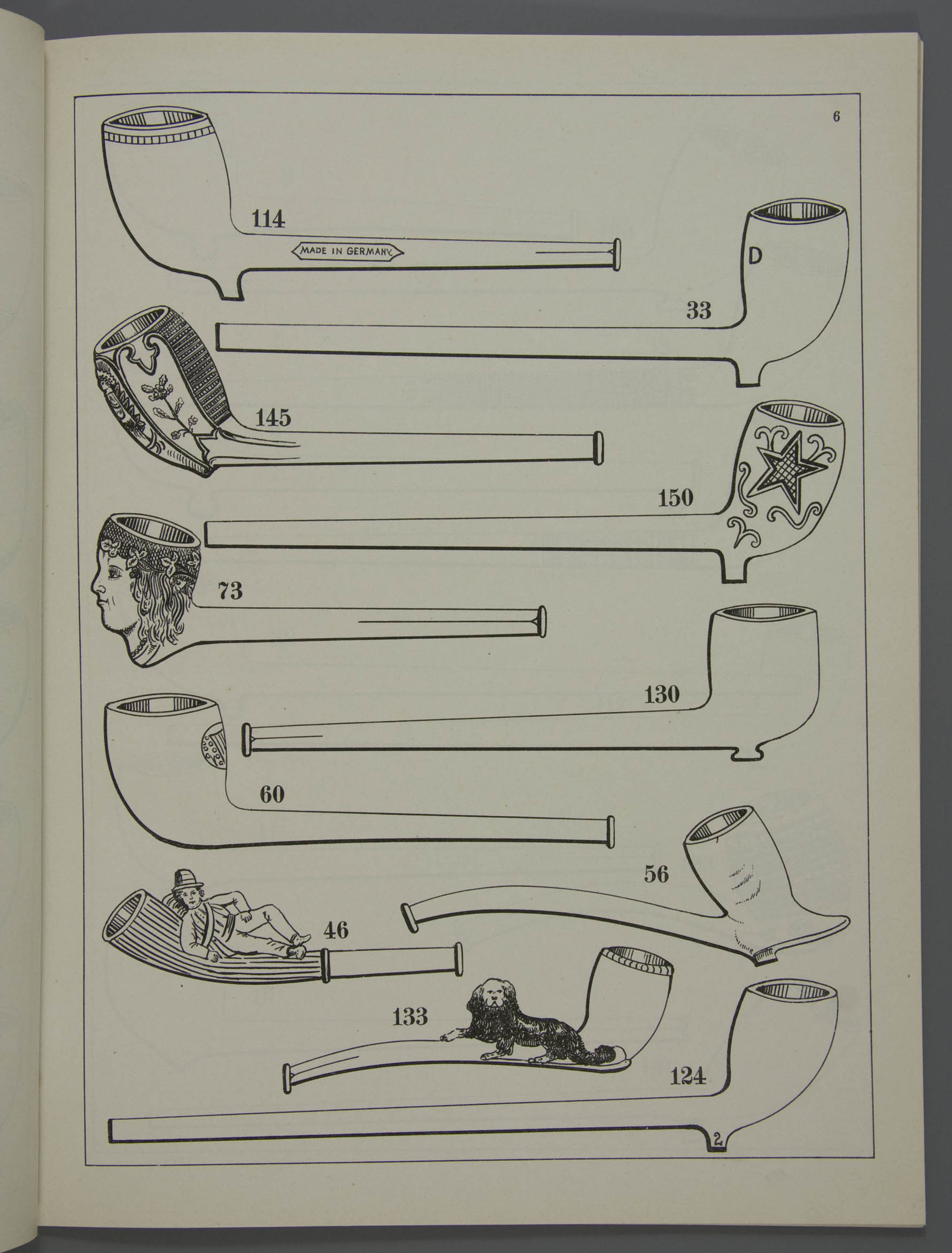
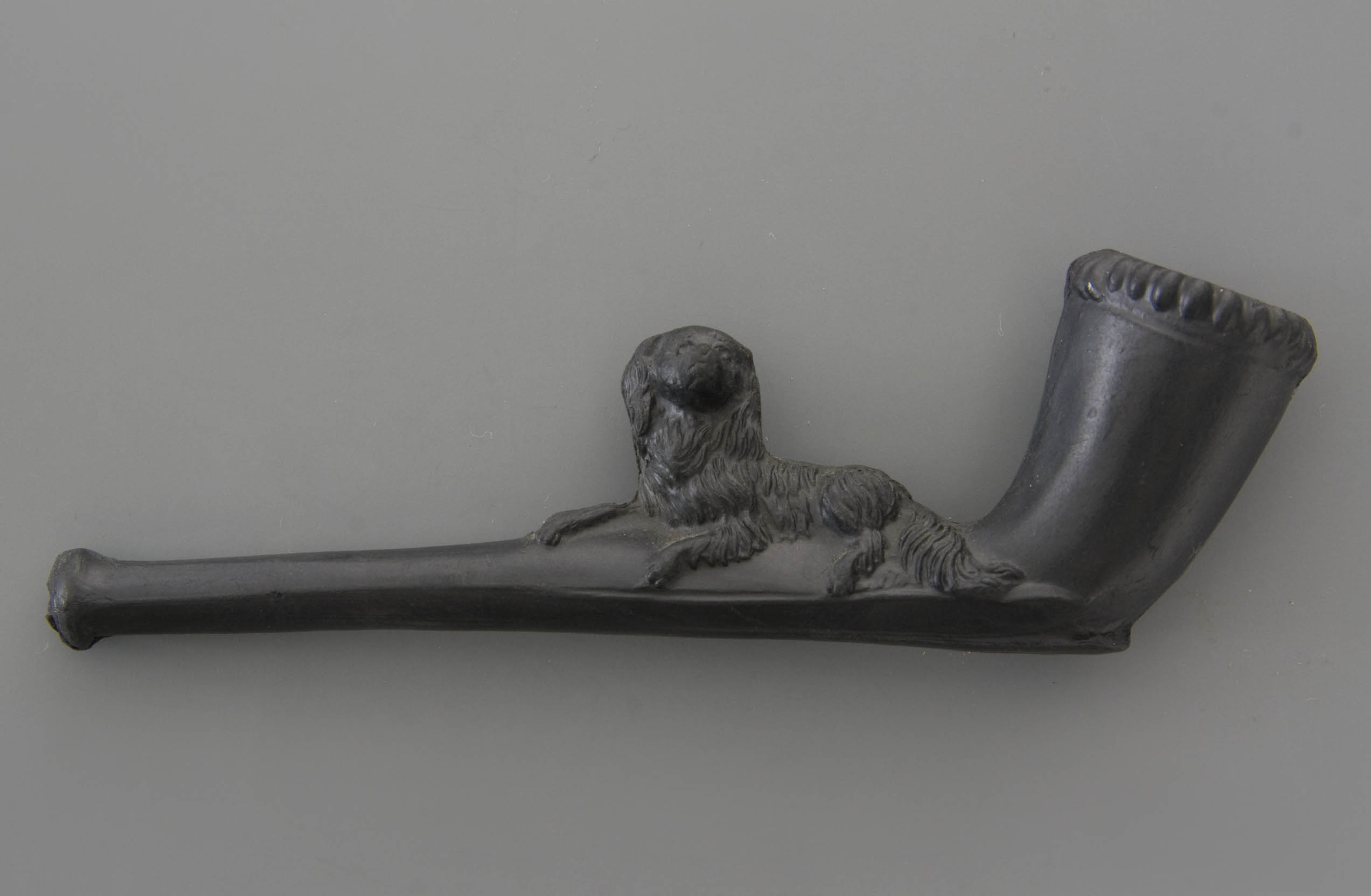

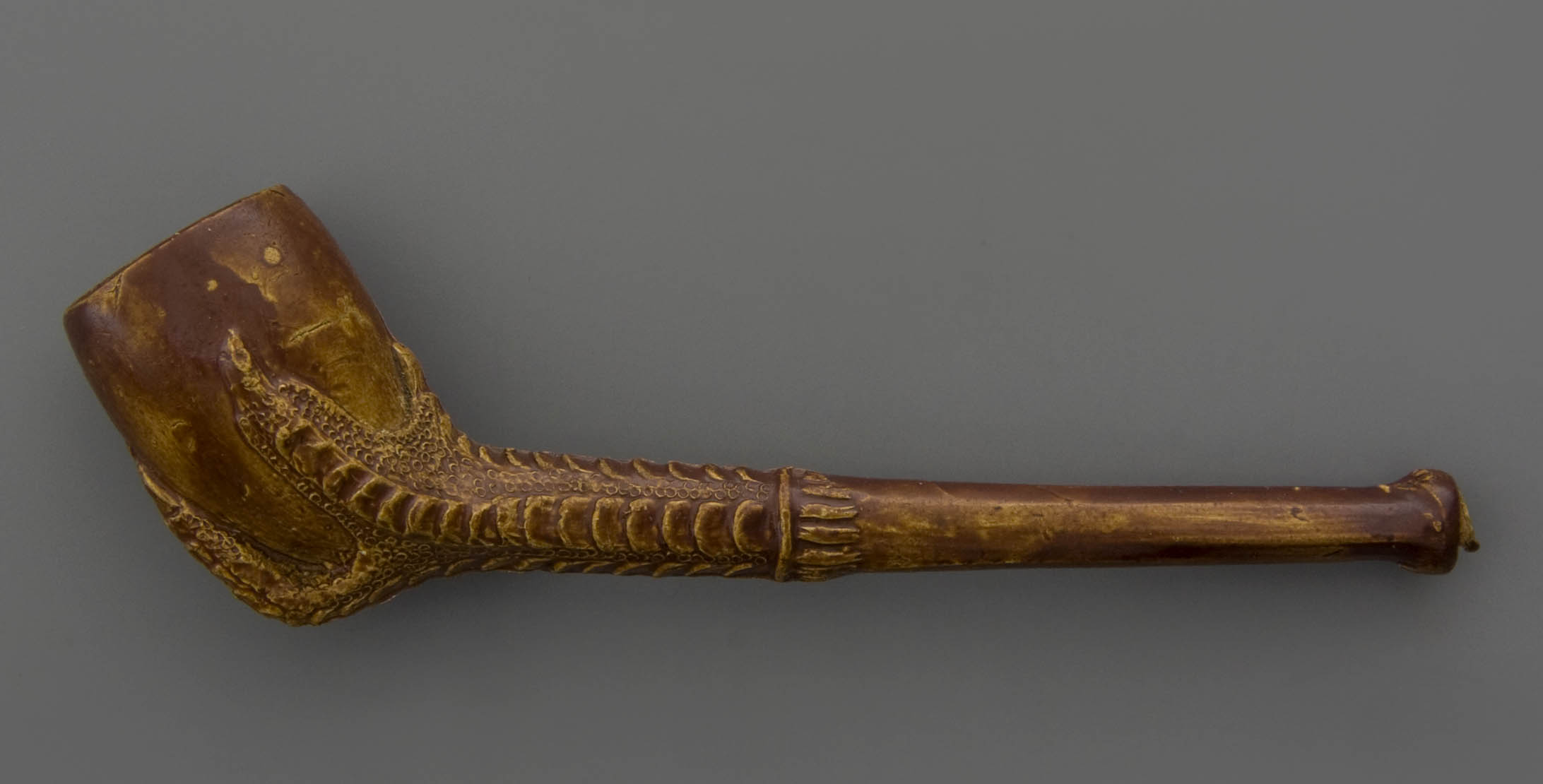
Exceptions in the shapes are pipes with a smaller size or with a different balance. Only two of them are specifically intended for smoking cigars and are derived from the meerschaum cigar holders known from Austrian workshops (Fig. 23). On the stem they carry an embossed figure, such as the lying dog (shape 133), a faithful copy of a meerschaum pipe (Fig. 24). The resting hunter, on the other hand (shape 46) is derived from clay interpretations of cigar holders. In this pressed version they both seem rather insignificant. Cigarettespfeifchen form another minority group (Fig. 25). It concerns miniatures of ordinary pipes indicated as cigarette holders, of which seven are in production, four have human heads on the bowl, one shows a bird's claw (Fig. 26). Actually, this is a kind of miniature goods, although some smokers considered them as a serious pipe around 1900.
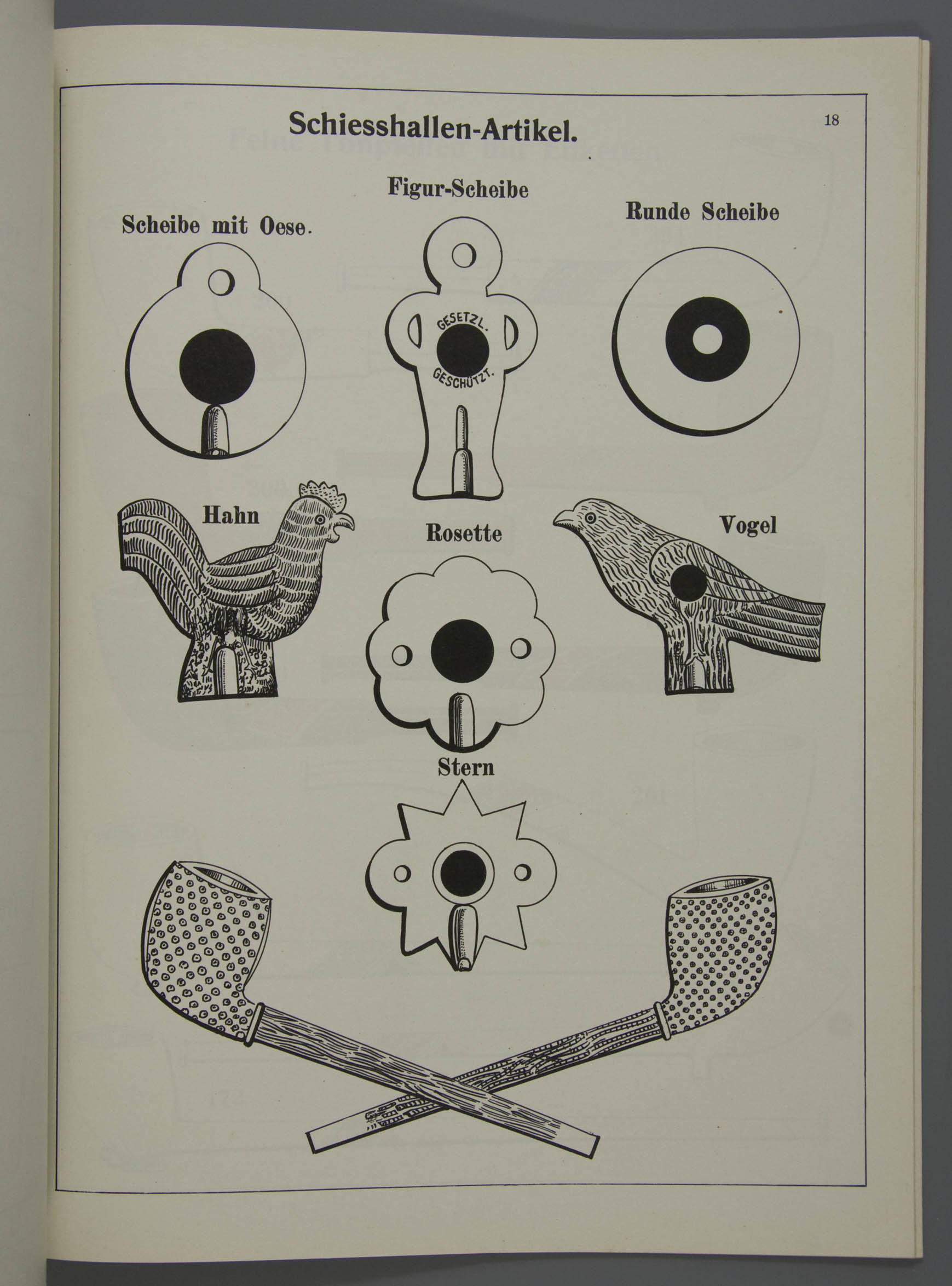

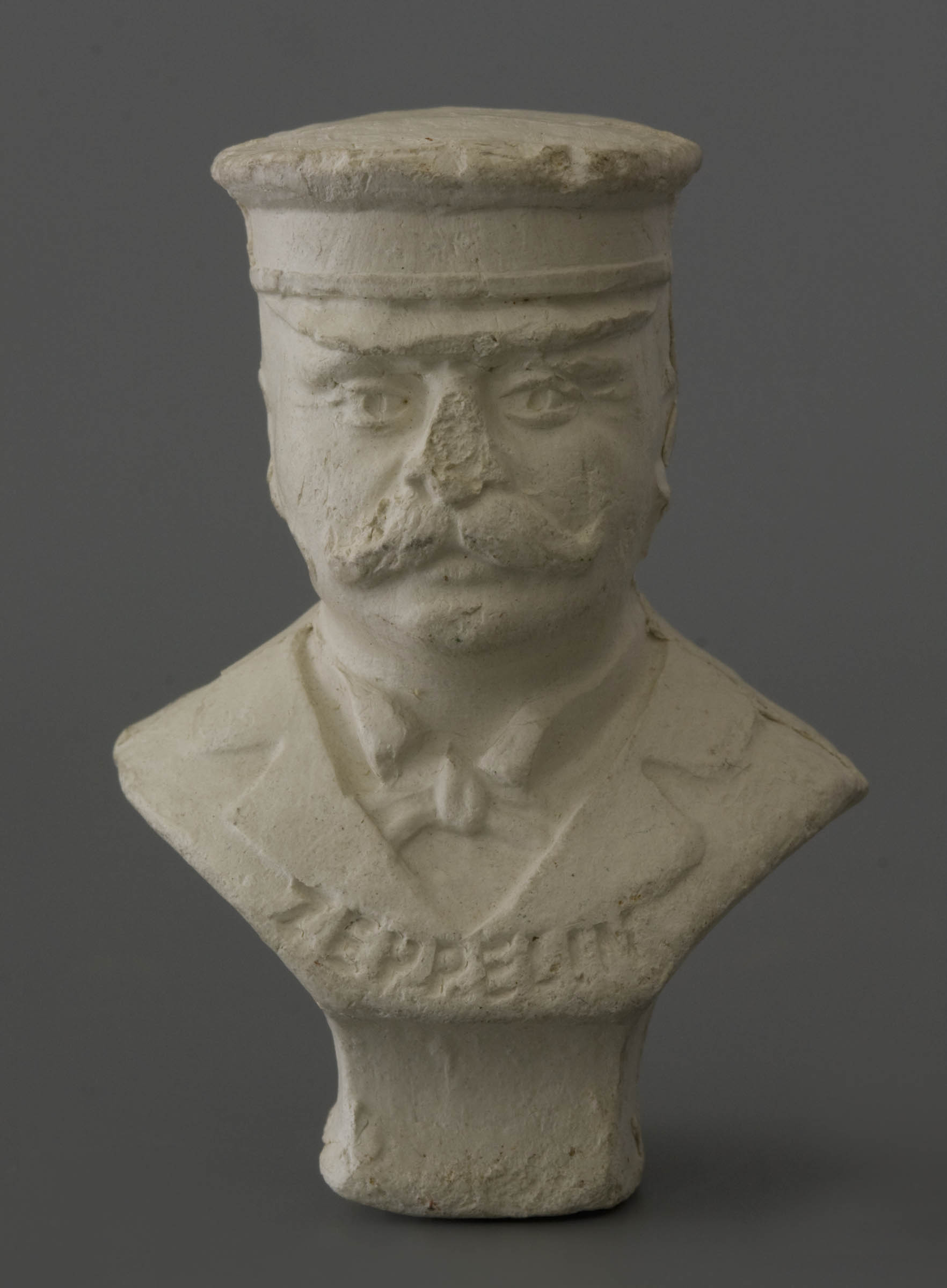
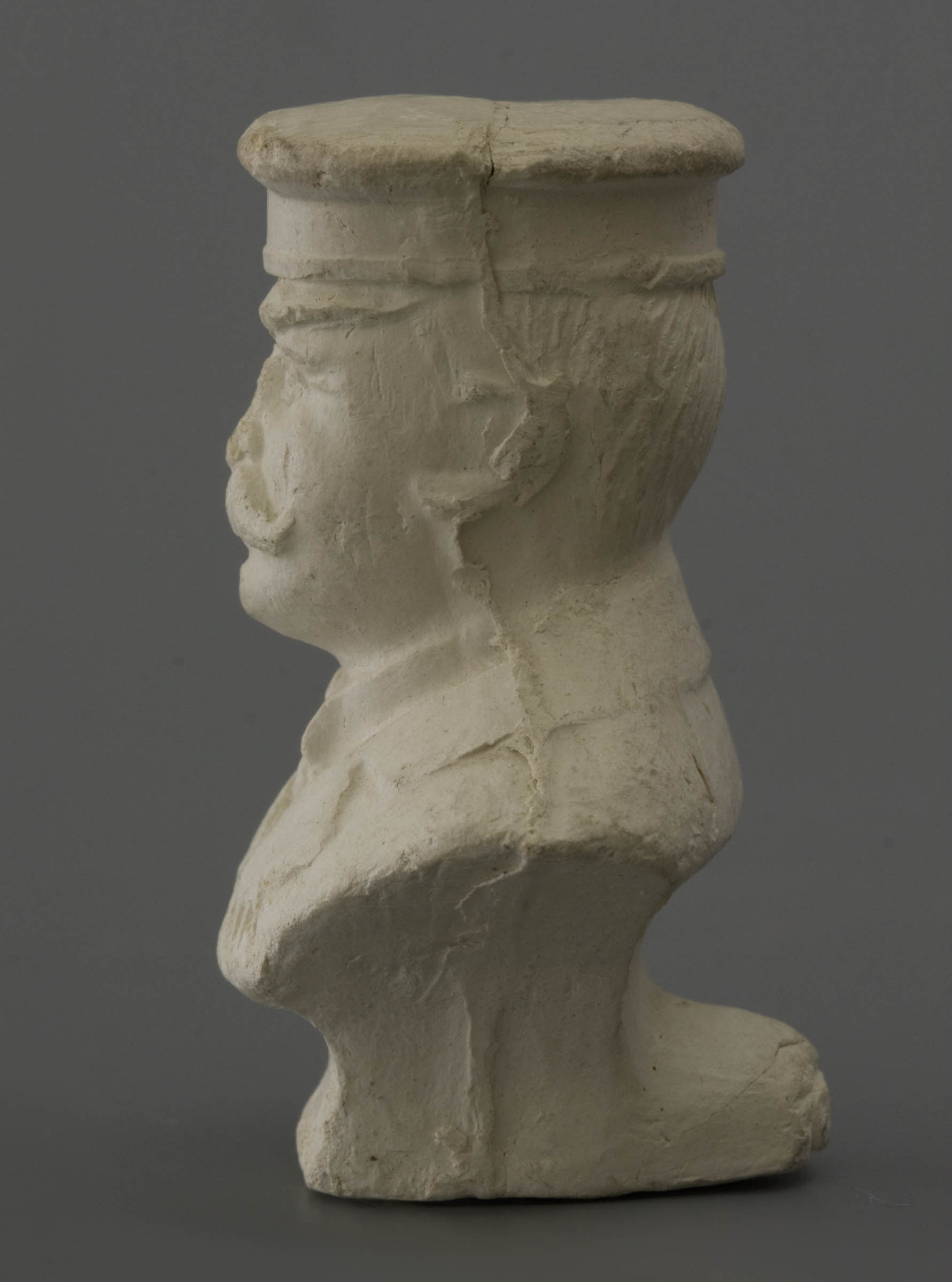
In the German Westerwald the manufacture of curiosities has a long tradition. Most pipe makers produce shooting figurines next to shooting pipes (Fig. 27). At Wilhelm Klauer & Sons, there was already a press machine before 1880 to make simple objects with minimal physical effort. The side products are so incredibly cheap in price that the production should be fast and easy. A machine of this type was especially suitable for shooting plaques. The group of side products is expanded around 1900 with luxury children's toys such as figural whistles and other curiosities. Many of these flutes are in the form of a sweet image that appeals to young people in particular (Fig. 28). As a gift item, the Puss in Boots and a sitting dog became extremely popular. Time-tied and more serious is the bust of Graf Zeppelin, also fitted with a whistle at the back (Fig. 29). With this design it has become a real boy thing, although it can also be seen on a ledge somewhere in the house for decoration. Such children's toys were certainly not unique to Klauer, but come into production at many pipe factories in the region. Here again there is no question of originality, but only of imitation. Incidentally, the new production line is born out of necessity to compensate for the declining export orders for pipes.
Within the category of clay pipes, there is not really a wide range of shapes available, rather a specific selection of shapes. Standardization of the assortment was a necessity for streamlined and therefore economically responsible production. This was in fact the base and starting point for a production company. The fact that we see so many shapes from England is not surprising. Pipes in the style of the large factories in London, Manchester and Scotland from those days were offered in copy by German companies. Orders by the thousands were placed where prices were a fraction of a penny lower. They formed the main part of exports worldwide. At the beginning of the twentieth century, the French clay pipe had largely lost its reputation as an export article, a conclusion clearly expressed in this catalogue.
Prestigious pipes versus standard goods
As mentioned, on page 1 the catalogue starts with the most attractive pipes from the factory. There is a big difference between the two catalogues. The oldest example shows five figural pipes on the opening page, followed by three smooth, simple export shapes (Fig. 30). This division doesn’t create a convincing page. The later print solves this problem and shows the desired unity (Fig. 31). Now the first page shows ten pipes of a similar look, five of which are figurative. The other examples are also highly decorated, albeit less exuberant.
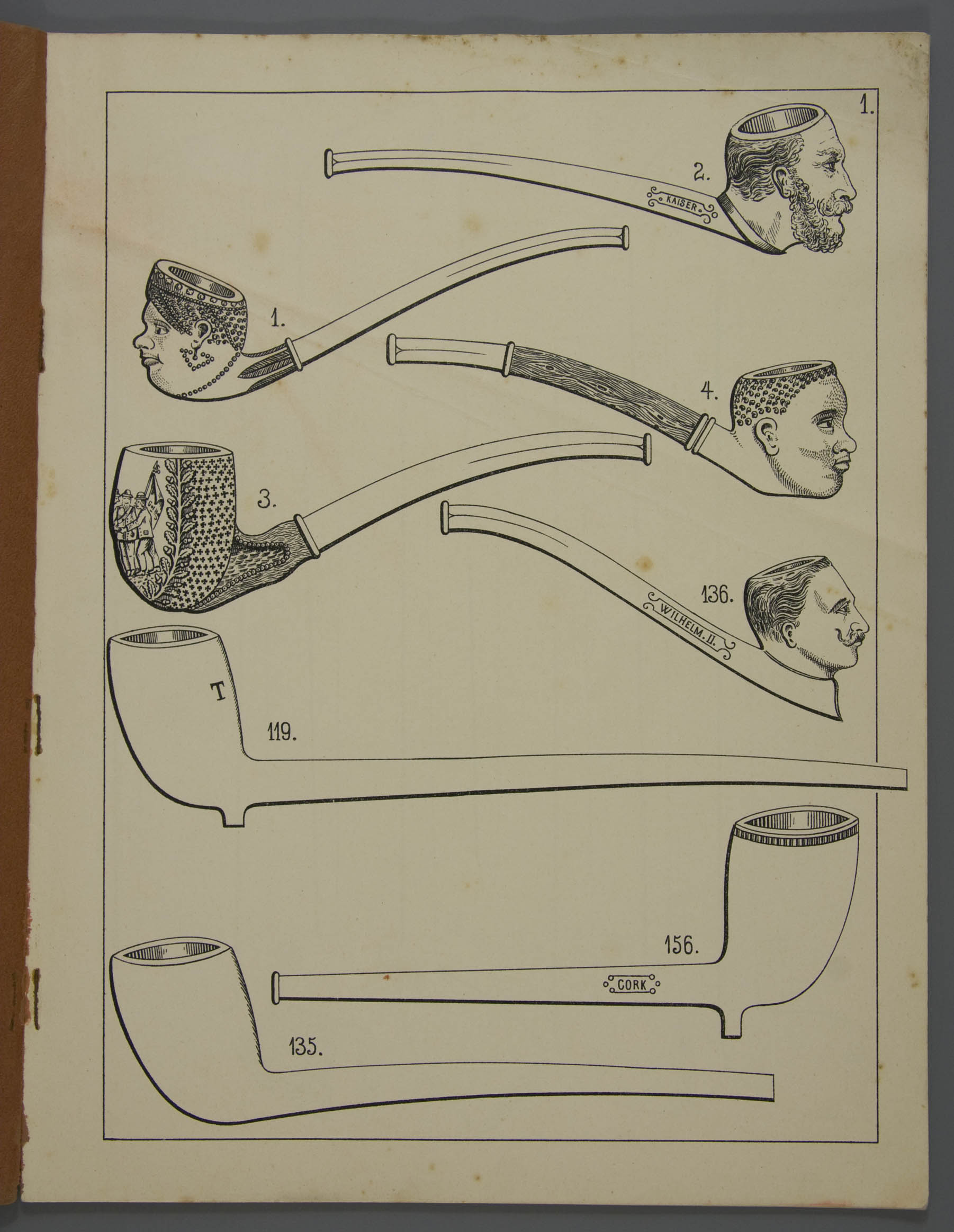
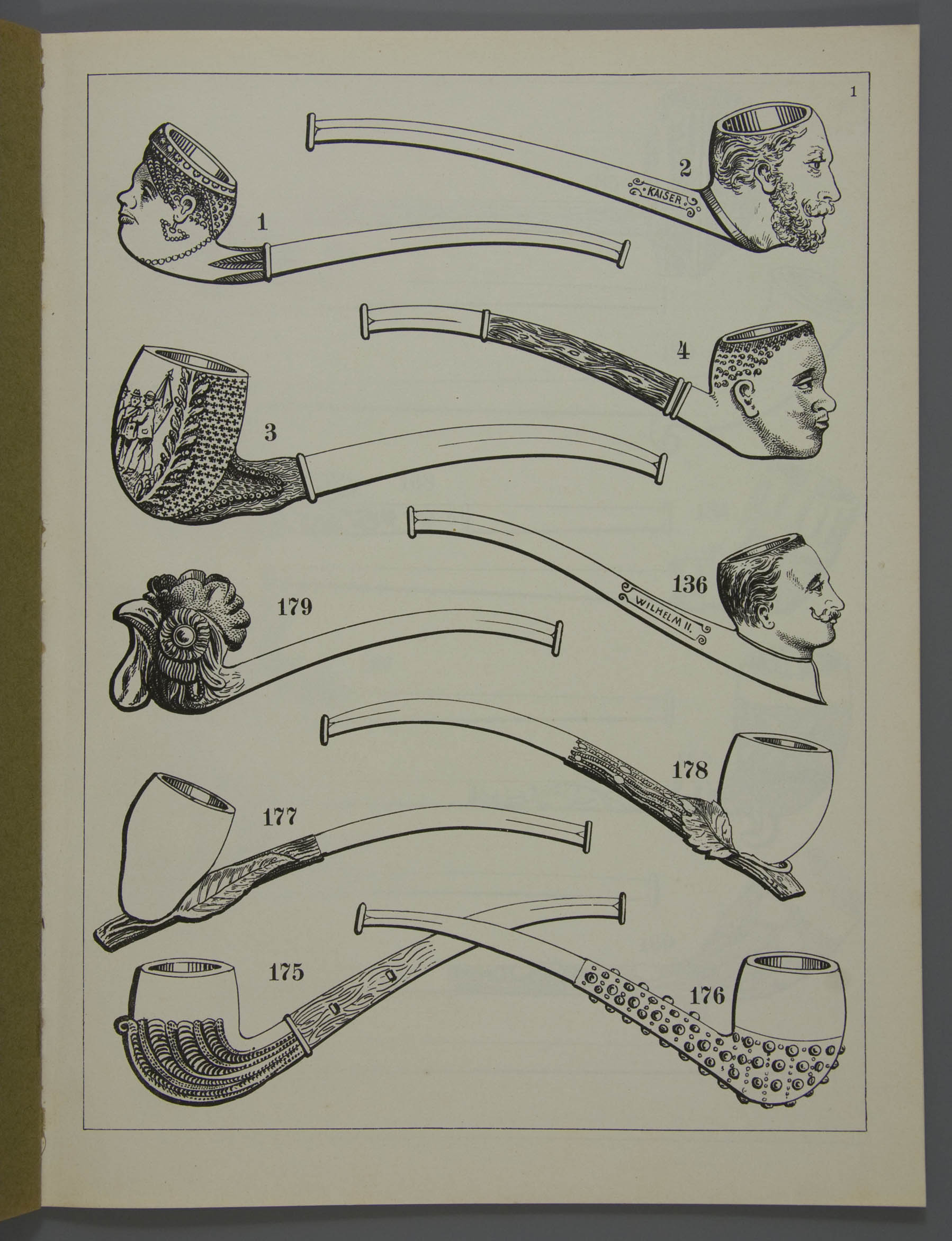
In addition to two negro females (shapes 1 and 4), there are the portraits of Kaiser Wilhelm I (shape 2) and Kaiser Wilhelm II (shape 136). Another politically engaged pipe has a light relief decoration executed in the Kevelaer genre, but now with a time-bound representation (shape 3) of the South African trio consisting of Pretorius, Krüger and Joubert on the front of the bowl. They formed the government from 1880 to 1883. We see them on the front of the pipe, the place where normally an image of the Kevelaer Madonna can be seen. The rest of the bowl is roughened with asterisks, as was usual with the pilgrimage pipe. With the revised printing, the first page, thanks to the figural work, attracts the full attention of everyone who leafs through the catalogue.
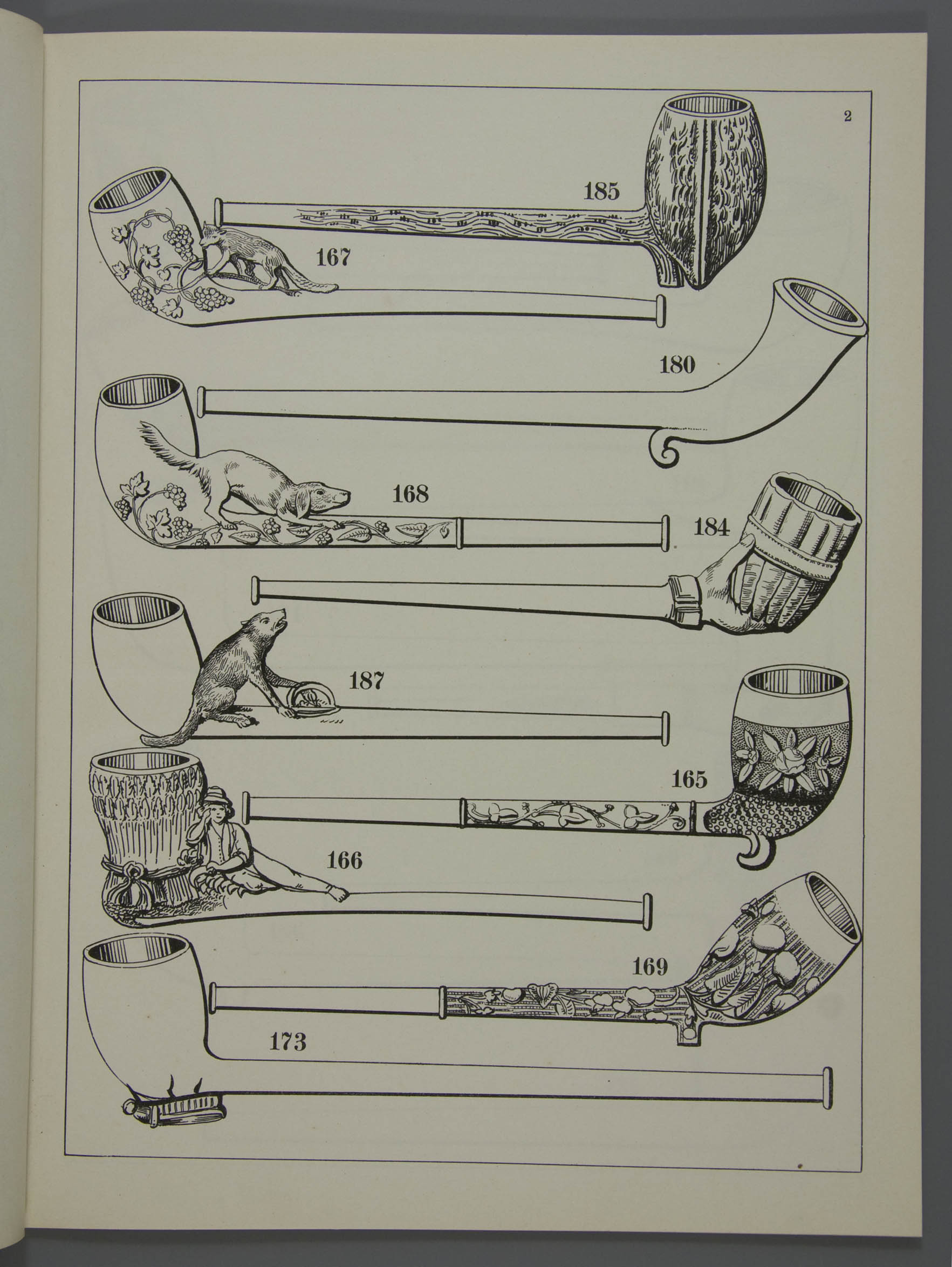
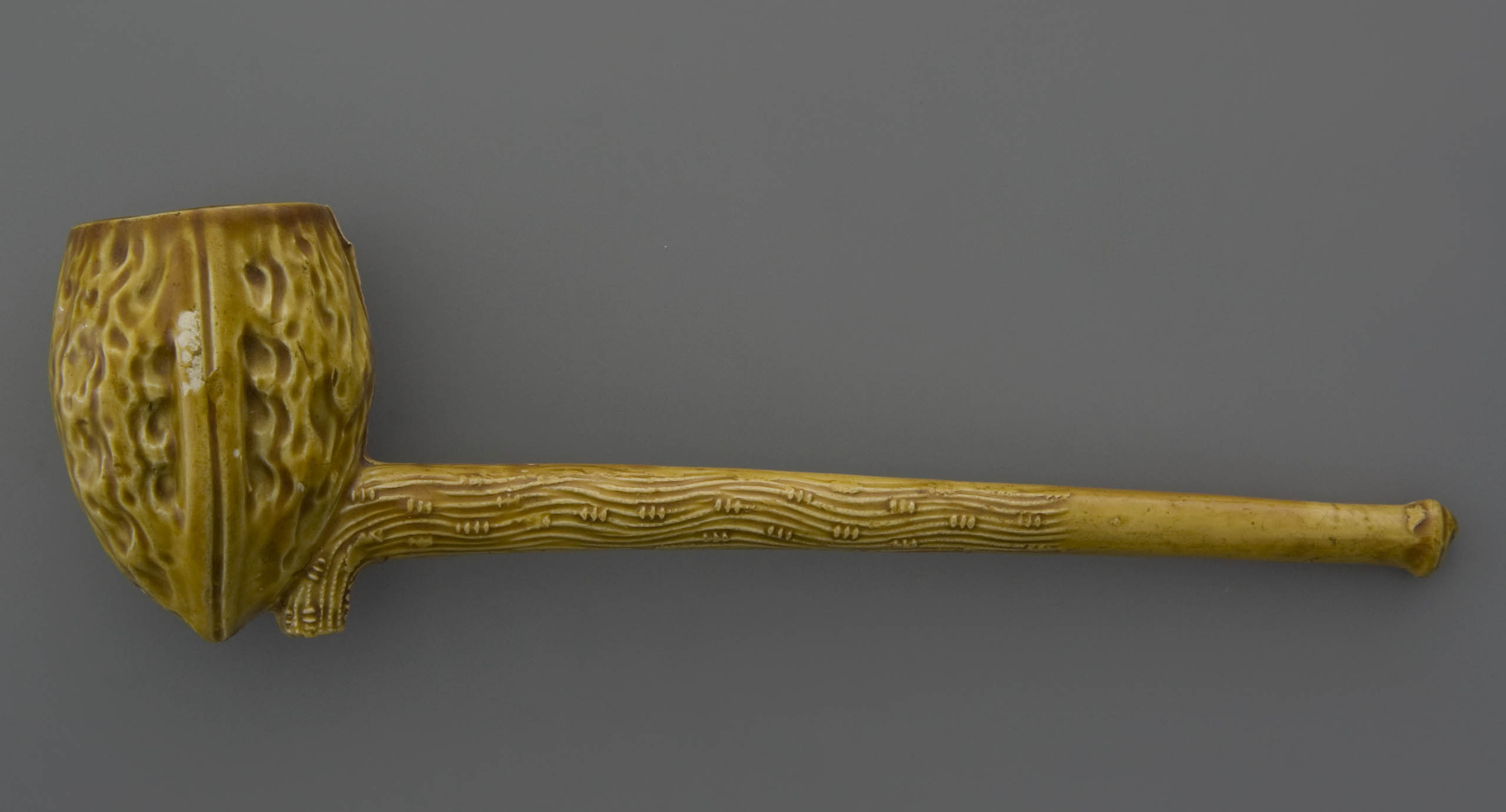
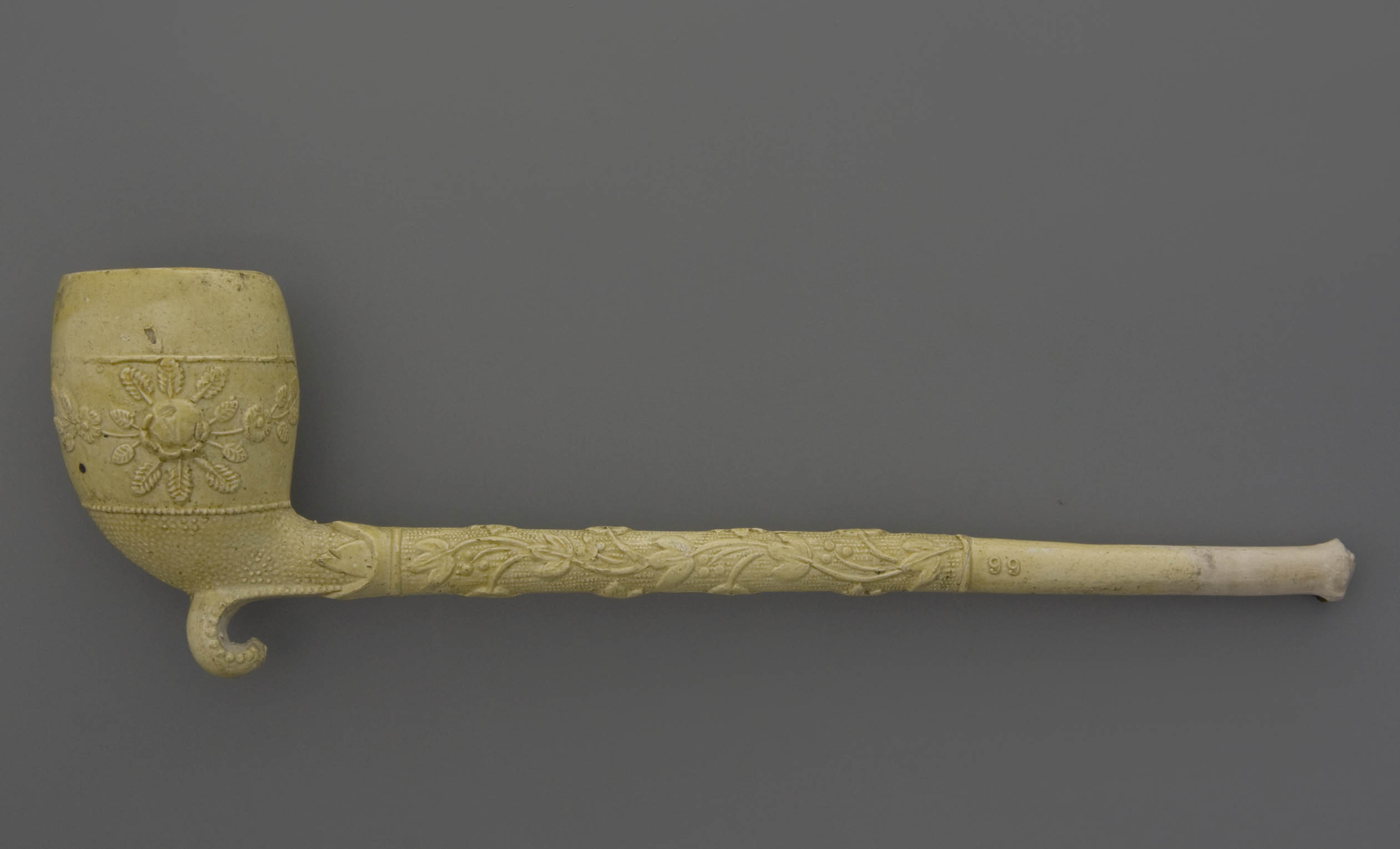
Page two of both editions is again very different. In the old printing, smooth pipes are shown, depicted lengthwise because of the longer stems than usual. At the second edition the rhythm of the first page is continued (Fig. 32). In terms of appearance, these clay pipes do take a step back, but this page certainly contains attractive specimens. Four clay pipes have an exuberant stem decoration in high relief, three with an animal (shape 167, 168 and 187), the latter with a shepherd resting next to a sheaf (shape 166). These pipes were more difficult to produce, since the clay should fully fill the decorations of the press mould. The walnut (shape 185, Fig. 33) depicted on this page and a hand holding a bunch of cigars (shape 184) are other examples of more outstanding pipes. Interesting are two pipes in the style of the French Marseillaises (shape 165, 169, Fig. 34). They were copied directly from the French firm J. Gambier from Givet, but without any marks or inscriptions. It was assumed at Klauer’s that not the model was protected, but only the factory mark. Moreover, a second thought was that Gambier did not deposit outside their own national borders. These two pipes prove that shapes and decorations were copied over and over again and that the makers were not so strict with anyone’s rights.
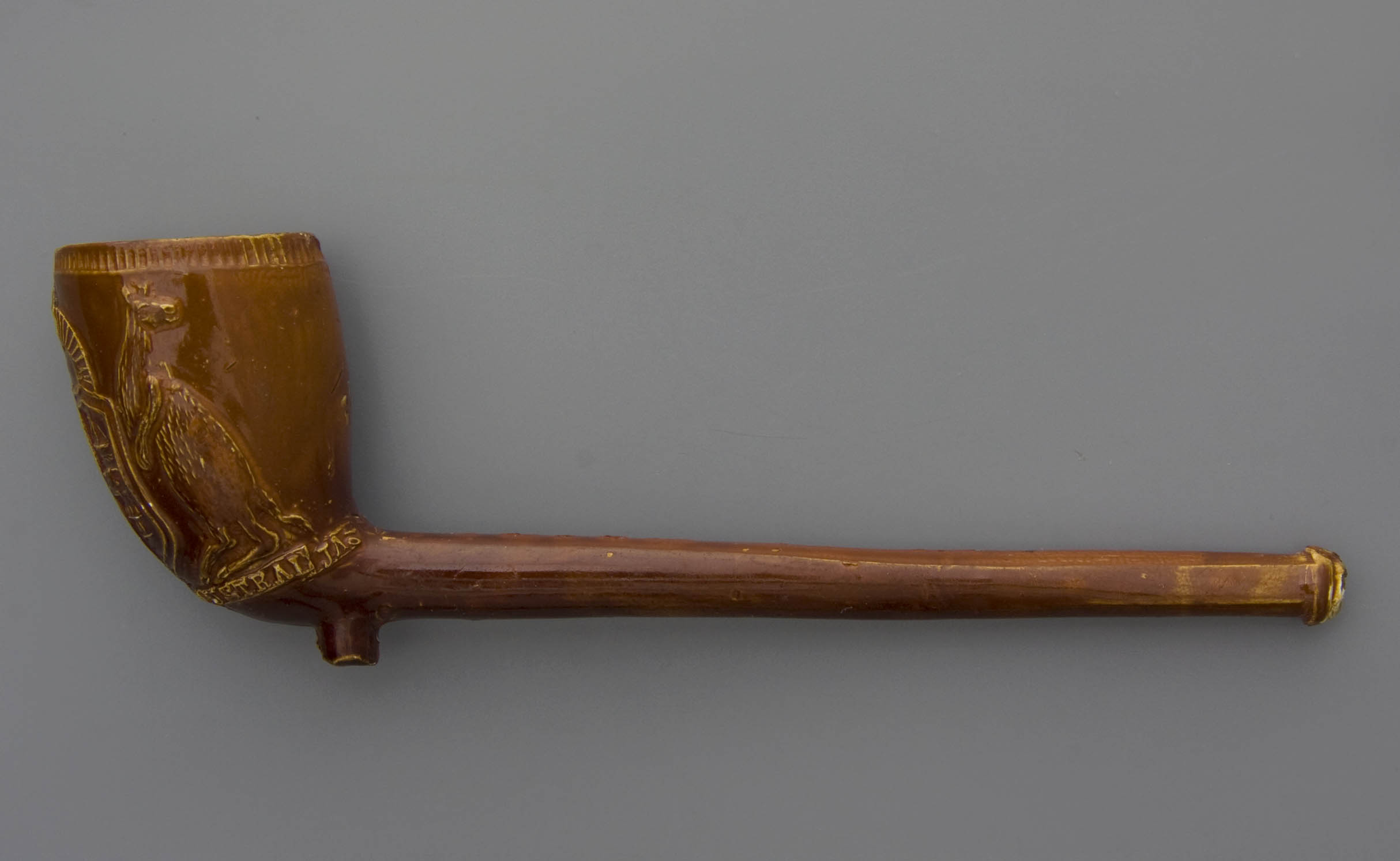
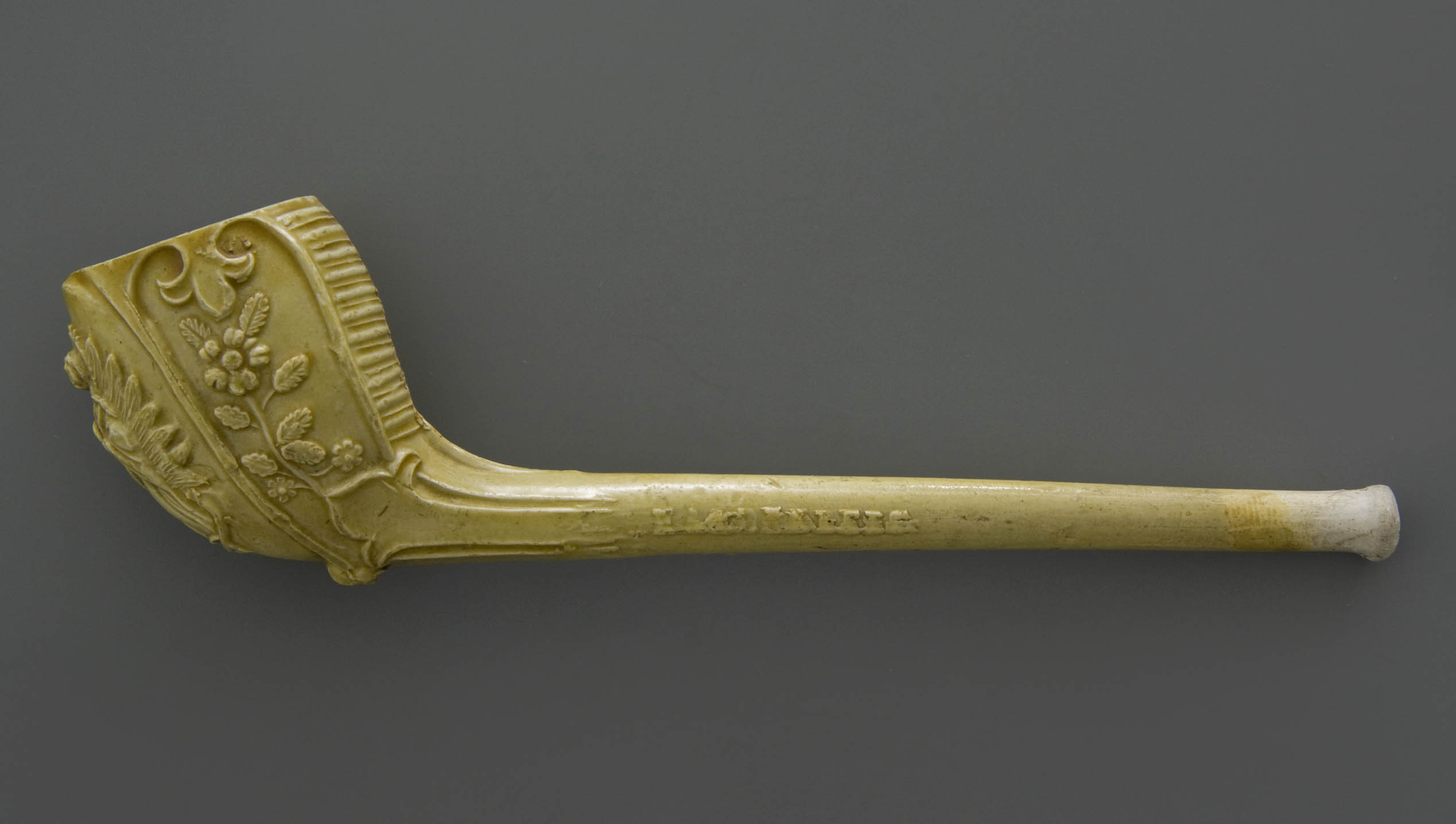
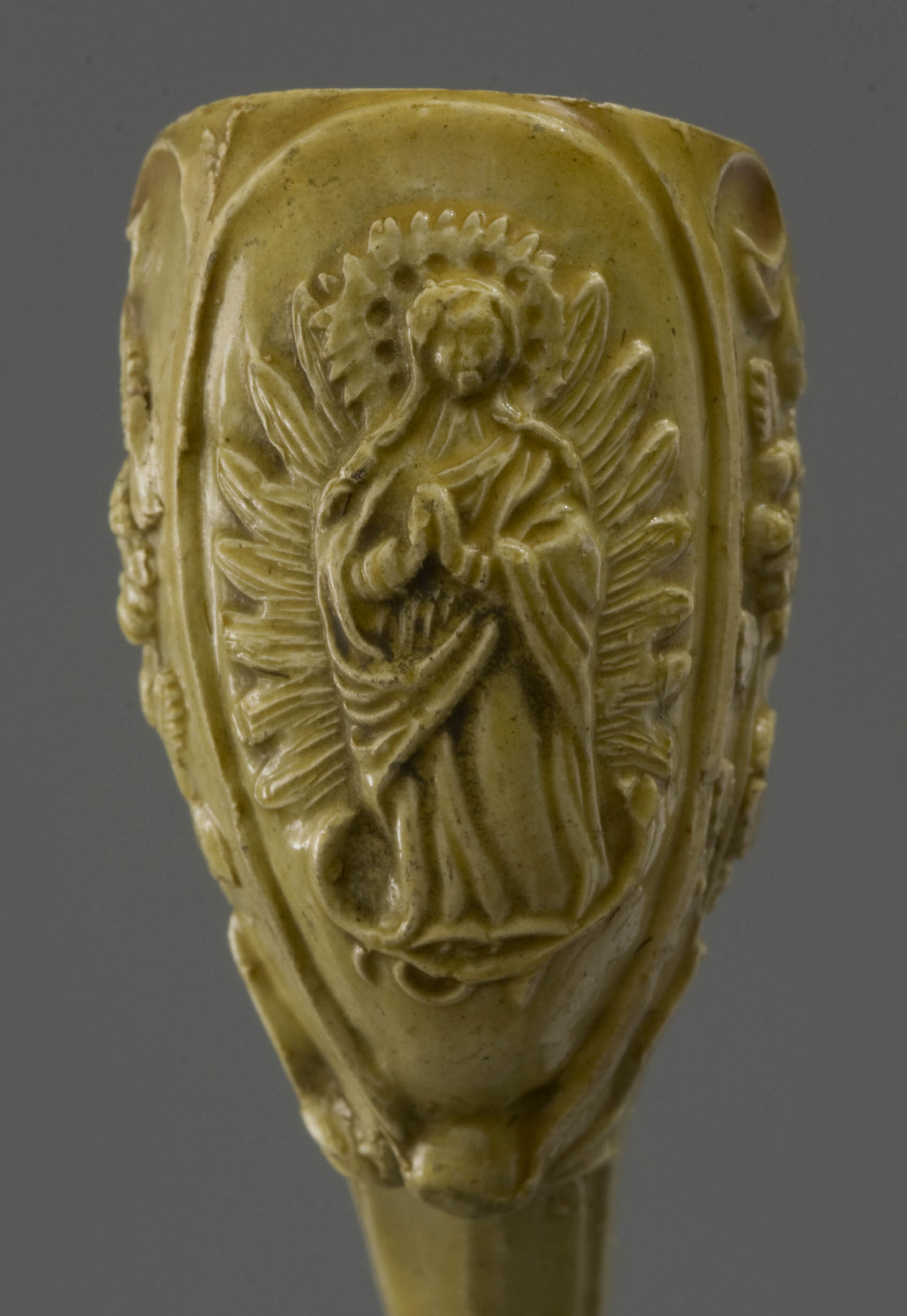
After page 3 it is nearly done with the decorated work. Relief pipes continue to alternate with the simple standard shapes albeit in limited numbers. We see one or more distinctive pieces on every page, starting with the coat of arms of Australia (shape 95, Fig. 35). A beautiful product is a pilgrim pipe (shape 145, Fig. 36) with an oval-shaped bowl with a standing Maria on the half-moon with a halo around her head. On the stem we read the name of the pilgrimage site Hardenberg, nowadays Neviges. An unexpected image is a tobacco pipe in the shape of a fish (shape 61, Fig. 37, 38). That proves to be the last pipe in fantasy design, the rest is executed with a shallow relief following the shape of the pipe. Even when portrait pipes are depicted, these are in moderate design that do not free itself from the pipe shape (shape 133, Fig. 39). Shape 47 for example, a cigar holder with head of a cuirassier from the oldest catalogue is interchanged in the later edition for a more neutral and more modern shape of a man's head with a simple military cap. It is illustrative for the simplification of the clay pipe after the year 1900, both in terms of subject and finish.
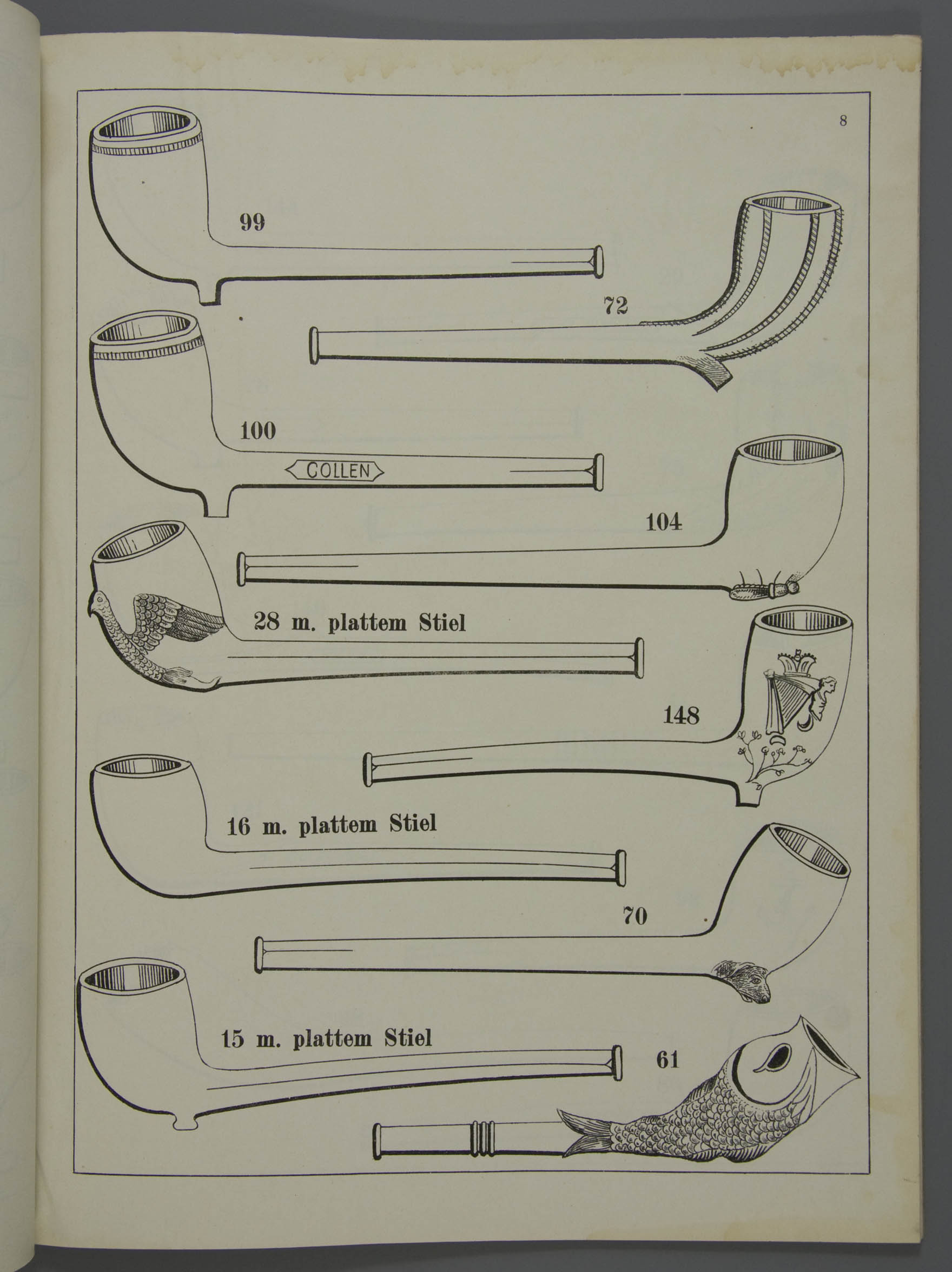
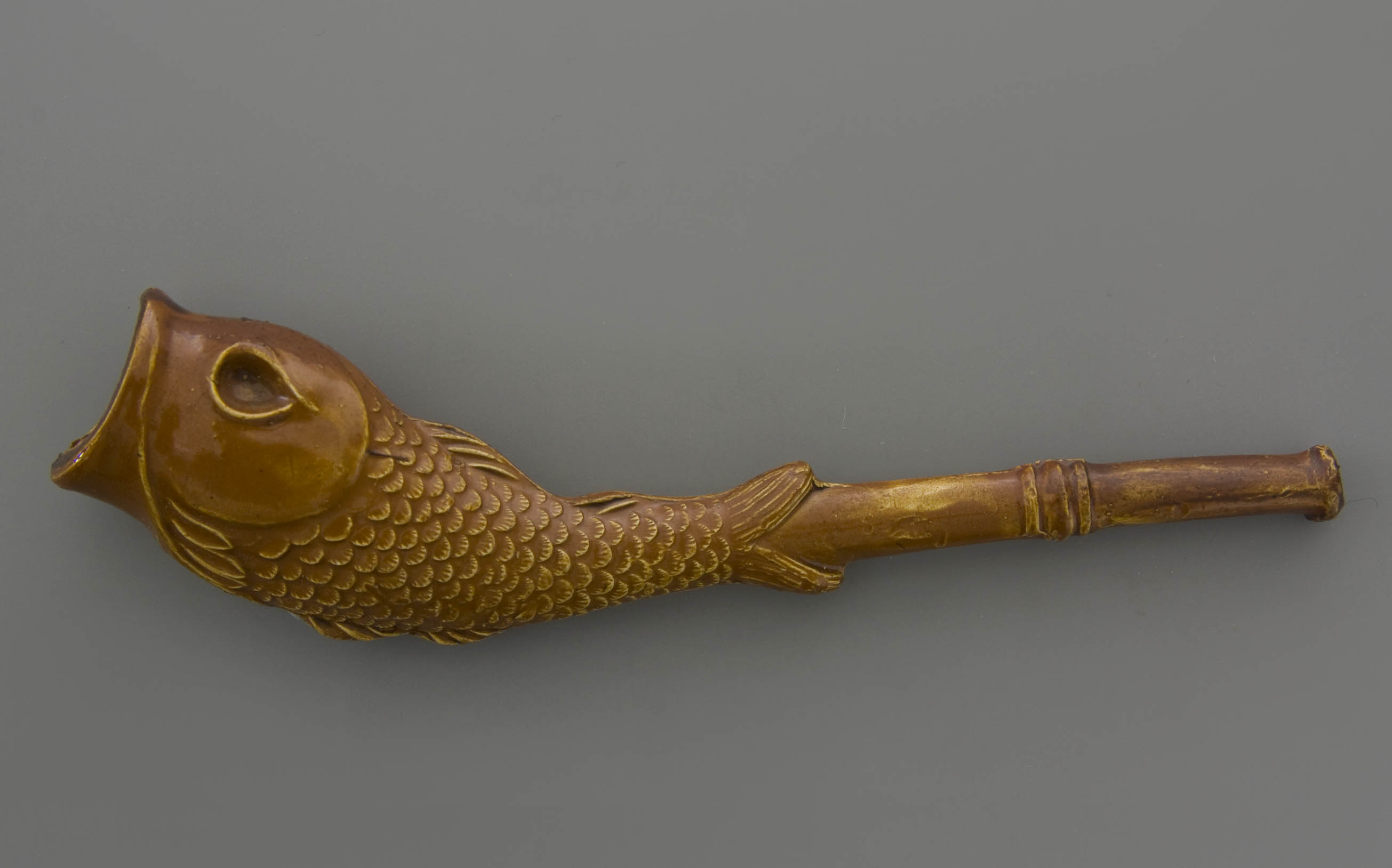

Some other luxury products can be found in the back of the catalogue. There we see, for example, two portrait pipes of General De Wet (shape 413) and Queen Wilhelmina (shape 414, Fig. 40). The portrait with General De Wet is the oldest in this category and was produced for the South African market (Fig. 41), just like the older stemmed pipe already discussed with the South African triumvirate (shape 3). Queen Wilhelmina was of course meant for the Dutch smoker, but its sales did not seem to have been successful (Fig. 42). Both pipes clearly show how much the modelling in the Westerwald was different from that of the leading French factories. The portrayal is highly schematized, even rather coarse, so the pipes lose a lot of realism. The problem of recognition is compensated by writing the name of the depicted on the pipe itself. Both designs were executed as insertion bowl, a characteristic design for the beginning of the twentieth century. The old fashioned cuff has been replaced for a smooth stem end on which a metal ferrule is pushed for mounting with a hard rubber or horn mouthpiece.
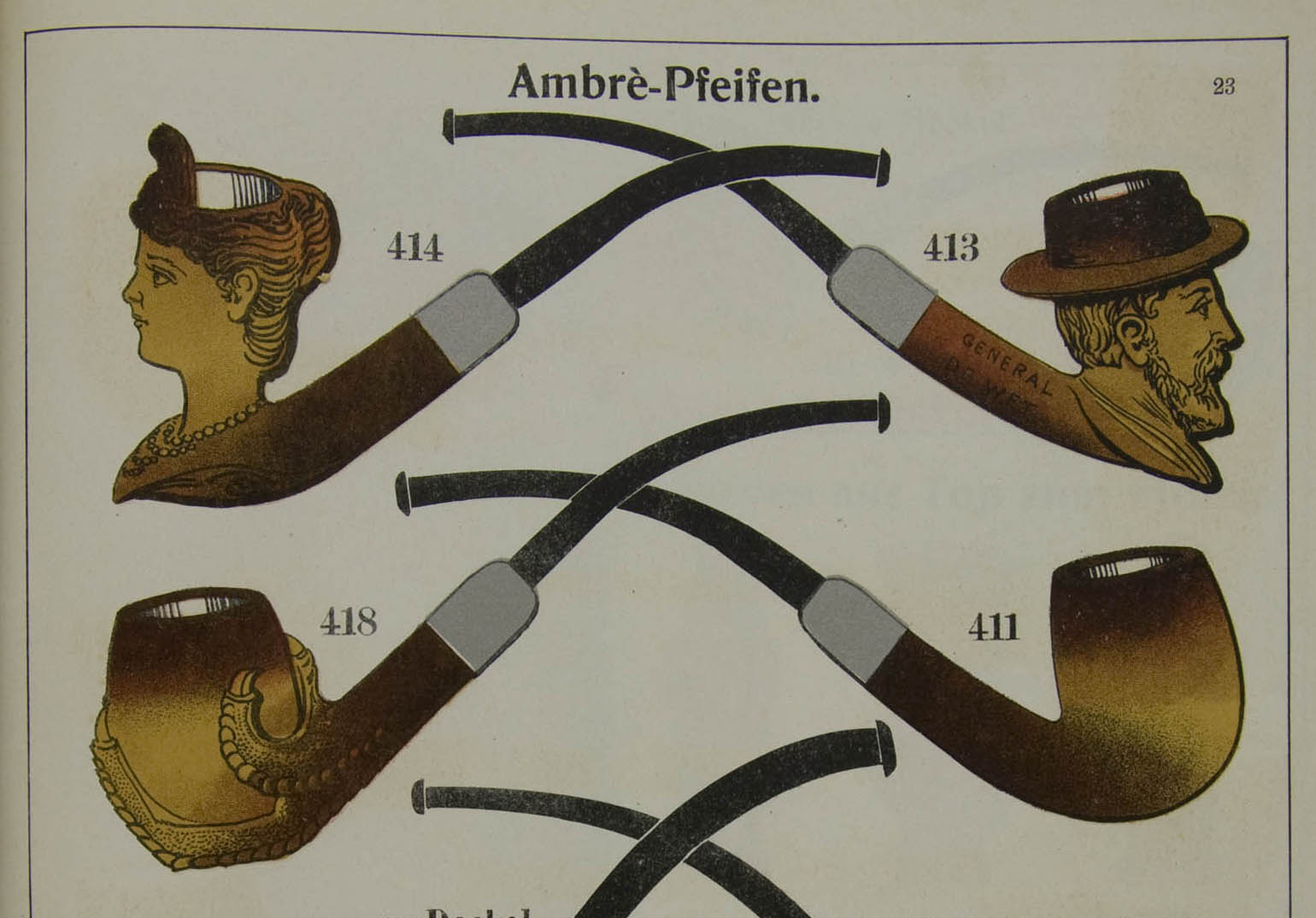
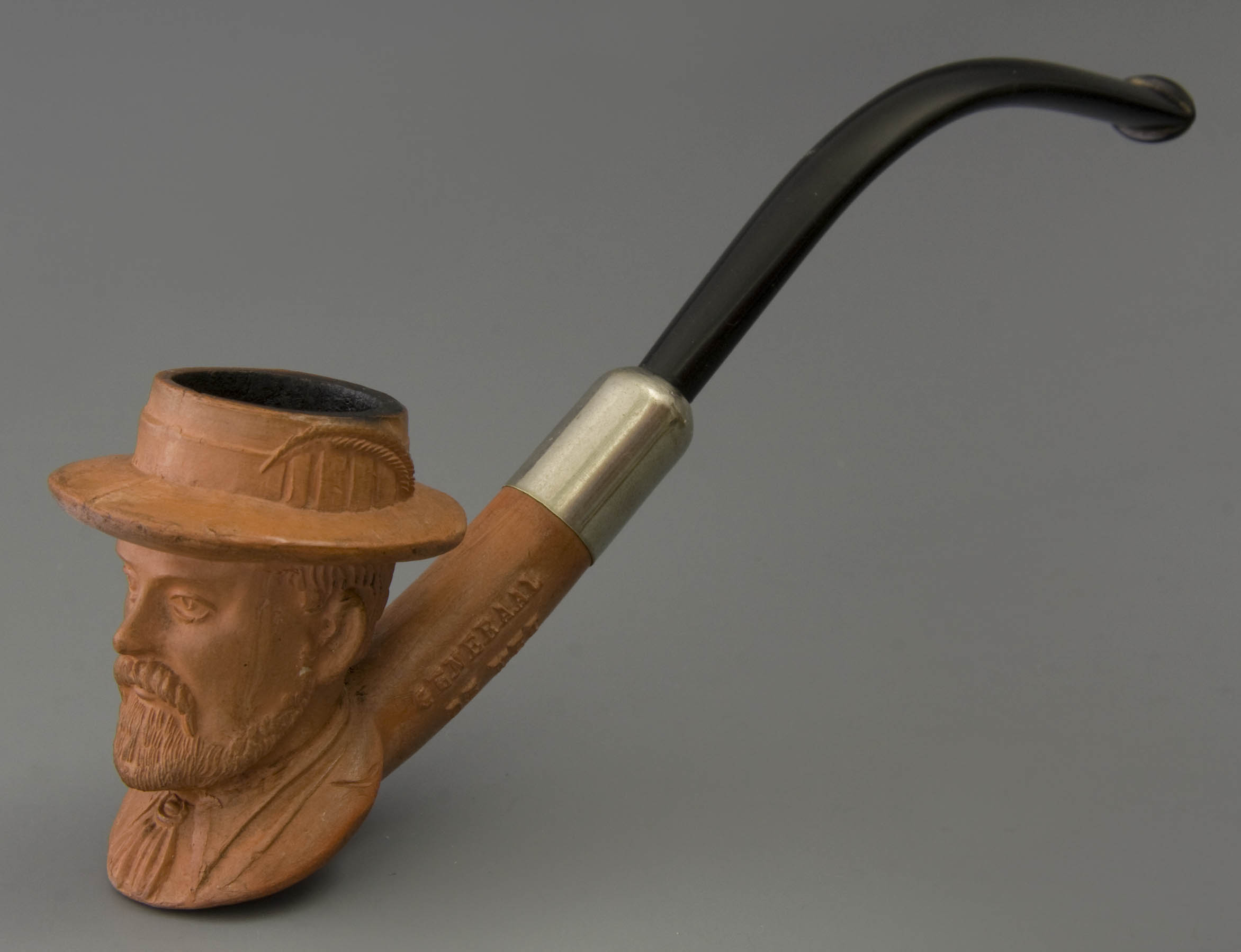
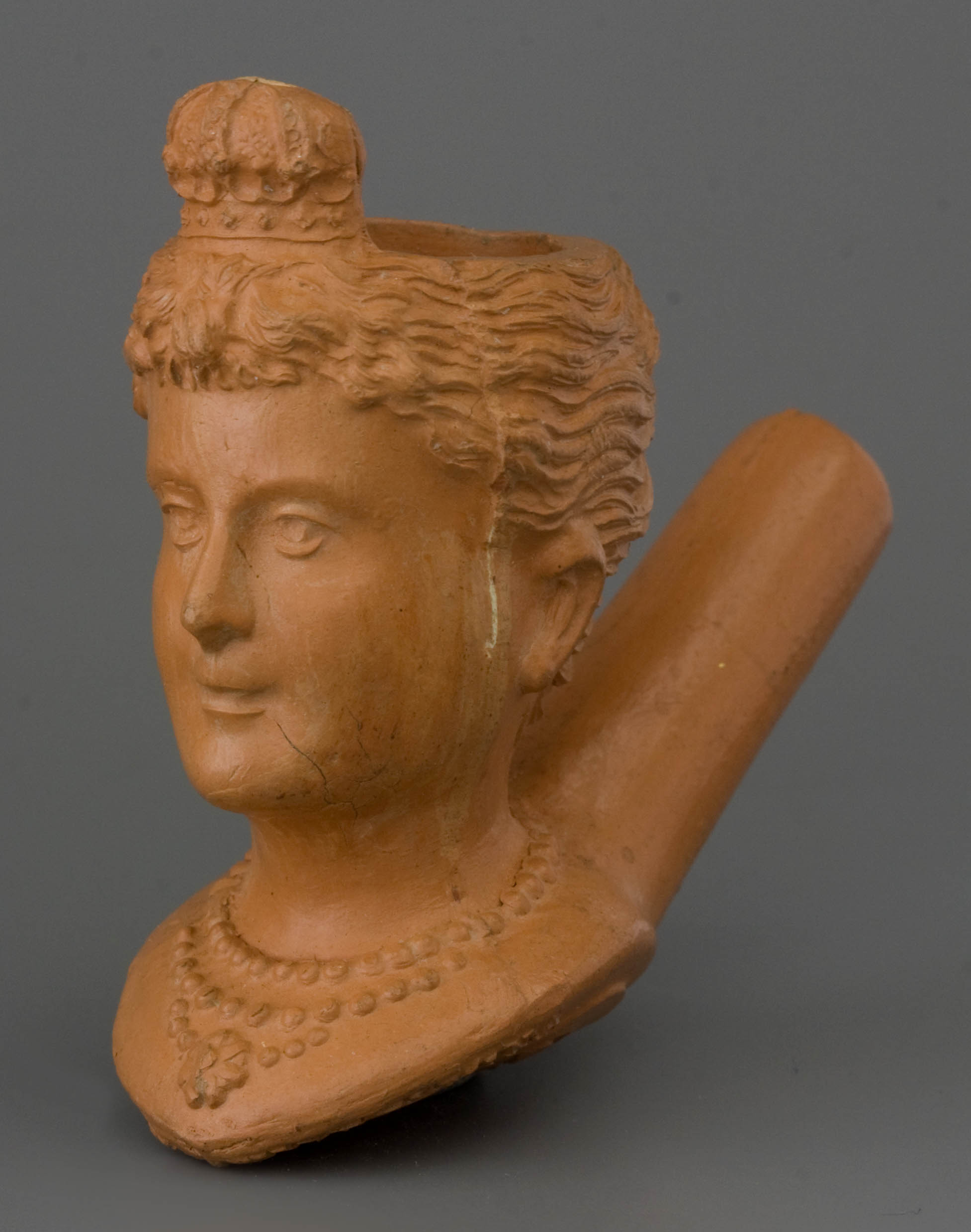
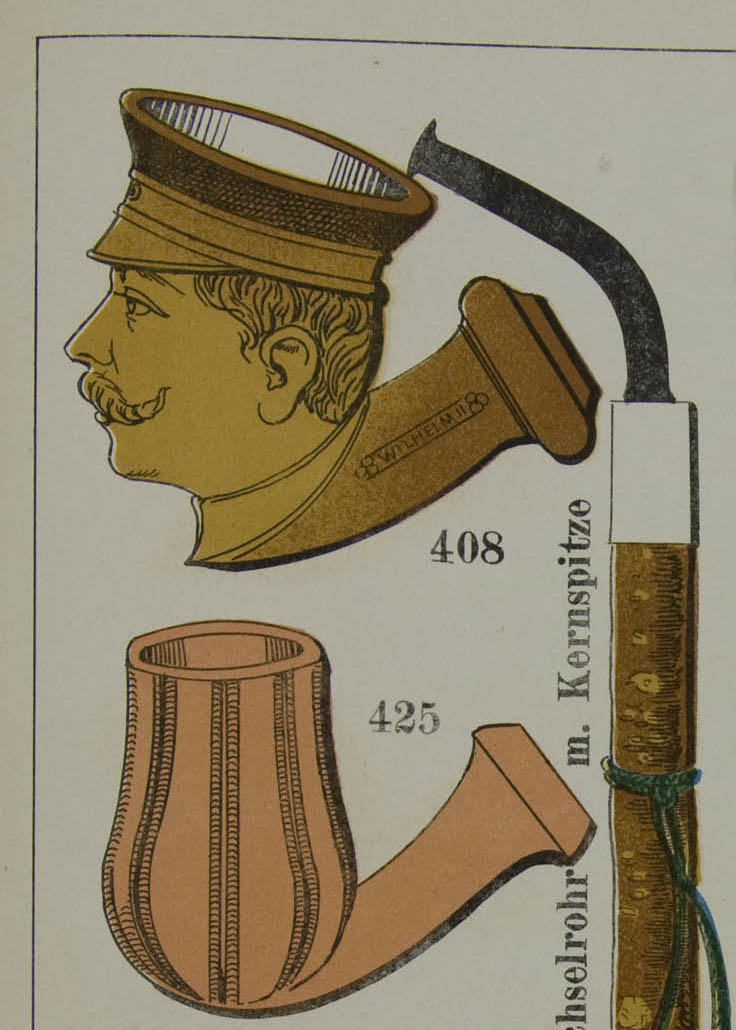

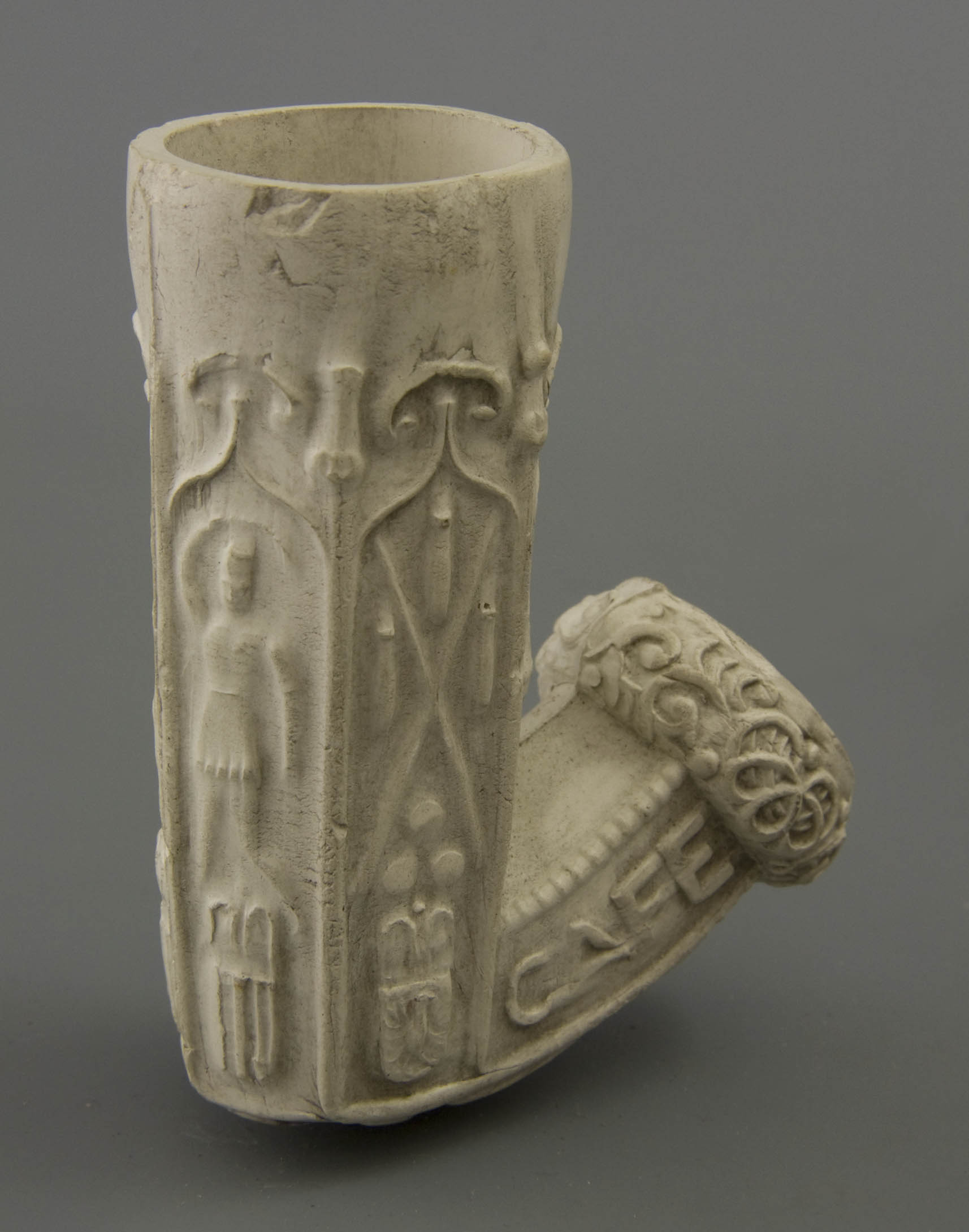
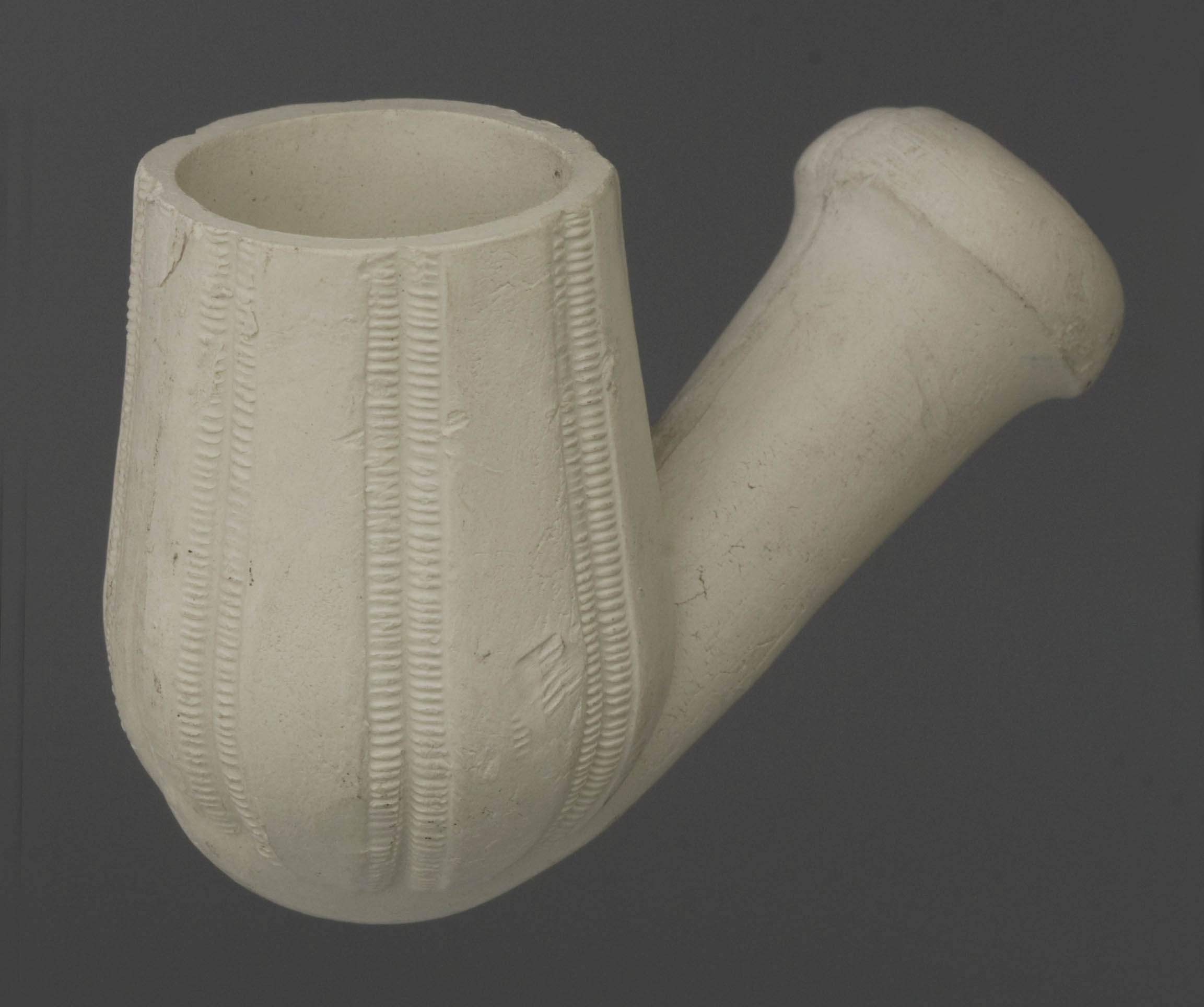
Only a few interesting pipe bowls from this range still show the somewhat outdated cuff. A well-done specimen shows a substantial portrait of Kaiser Wilhelm II (shape 408, Fig. 43). A smaller bowl shows a woman dressed in draperies with a laurel wreath along the front of the bowl (shape 420). There is no question about the origin, it is a copy of a Belgian design. The Kaffeehauspfeife (shape 430) is a characteristic feature of Westerwald production, a high hexagonal bowl with geometric decorations on the panels (Fig. 44). Such bowls were made in huge numbers in almost all German companies well before 1850, mainly intended for use in the Austrian and Hungarian Kaffeehäuser. They are seen as the most hygienic clay pipes because the thick walls absorb the nicotine juices almost completely (Fig. 45). Specifically for Klauer, finally, is a pear shaped stub stemmed bowl with longitudinal ribs (shape 425, Fig. 46). It is an original shape that was made at few other factories as well.
Worldwide export goods
In the last quarter of the nineteenth century the sale of short-stemmed clay pipes had become an international trade. Pipe factories and general export companies shipped hundreds of gross from Europe to West- and South-Africa, North America and Australia. Orders were easily placed elsewhere when the production costs were a few cents lower per gross. This development has been extensively discussed in the book Century of Change.[1] For example, orders sometimes changed from Scotland to England or the German Westerwald. Klauer was a medium-sized company that could produce cheaply with the local pipe clay at hand and could join this international circuit. It is uncertain whether Klauer himself investigated the demand for certain shapes and decorations or received orders from traders for specific clay pipes.
A fact is that Klauer delivers remarkably large numbers of pipes that are directly copied from French and even more English, Scottish and Irish pipe makers. Without any restraint, particular decorations and inscriptions were adopted. Originality, copyright of others, keeping your own style or recognisability, none of this was an obstacle. This chapter describes a series of these imitations, each with their own history. The main part of this export goods consists of simple stemmed clay tobacco pipes with or without a modest relief decoration.
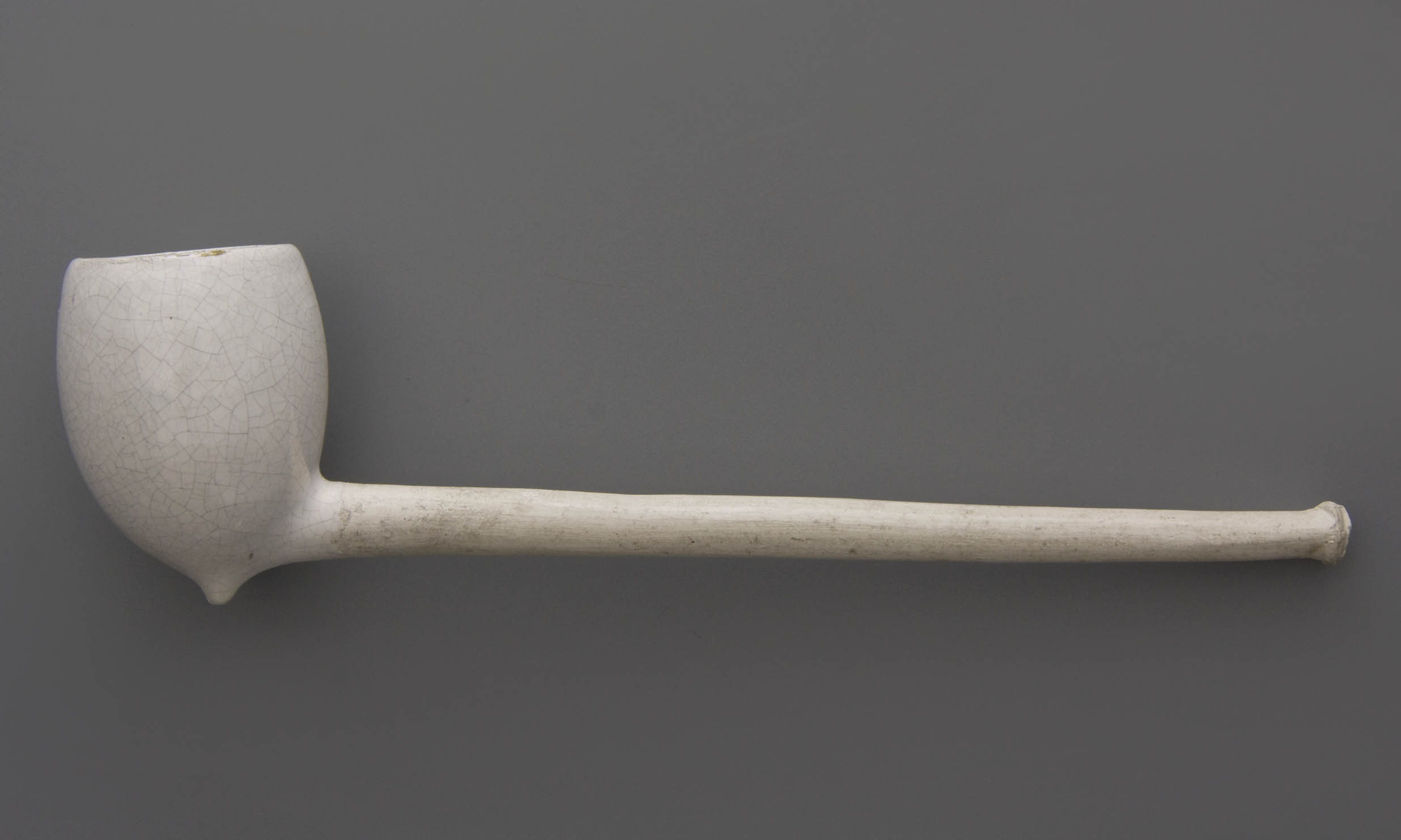
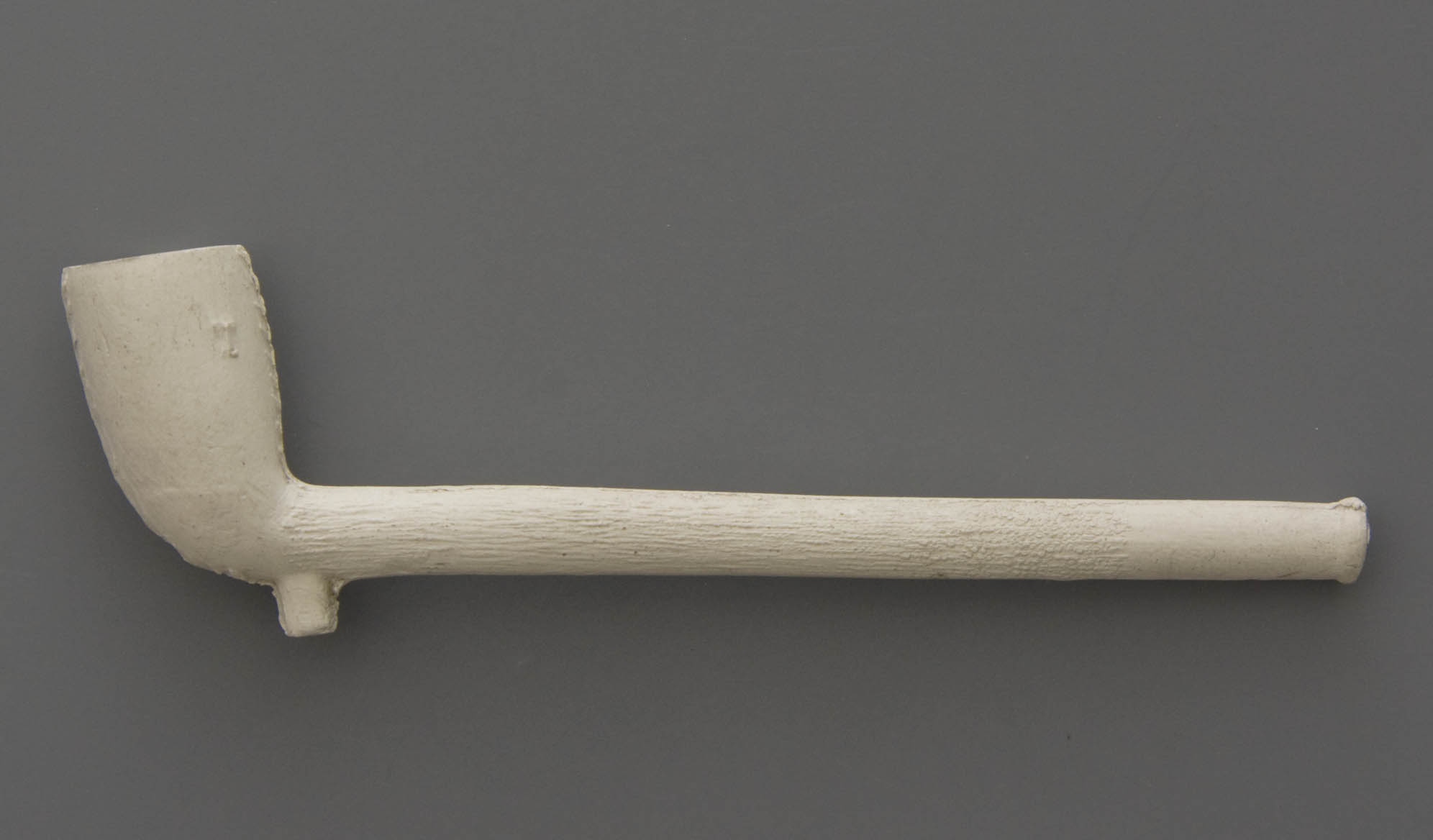
The best-known example of an export pipe is the TD pipe with a large curved bowl, cut-off opening and with the initials TD (shape 33, 170, Fig. 47) embossed on the pipe bowl facing the stem. The origin of the TD mark as an export pipe lies in England where pipes were already sold in such a way in the eighteenth century. They have always remained popular and from the middle of the nineteenth century they get their well-known shape that exactly that of the illustrations from Klauer's catalogue. For the sake of time saving, the stamped mark is then interchanged for letters in relief. The importance of the TD pipes lies mainly in the export to America. Around 1900 Klauer even introduced a cigarette pipe with the same mark (shape 143, Fig. 48). It is proof of how long a tradition can hold on.
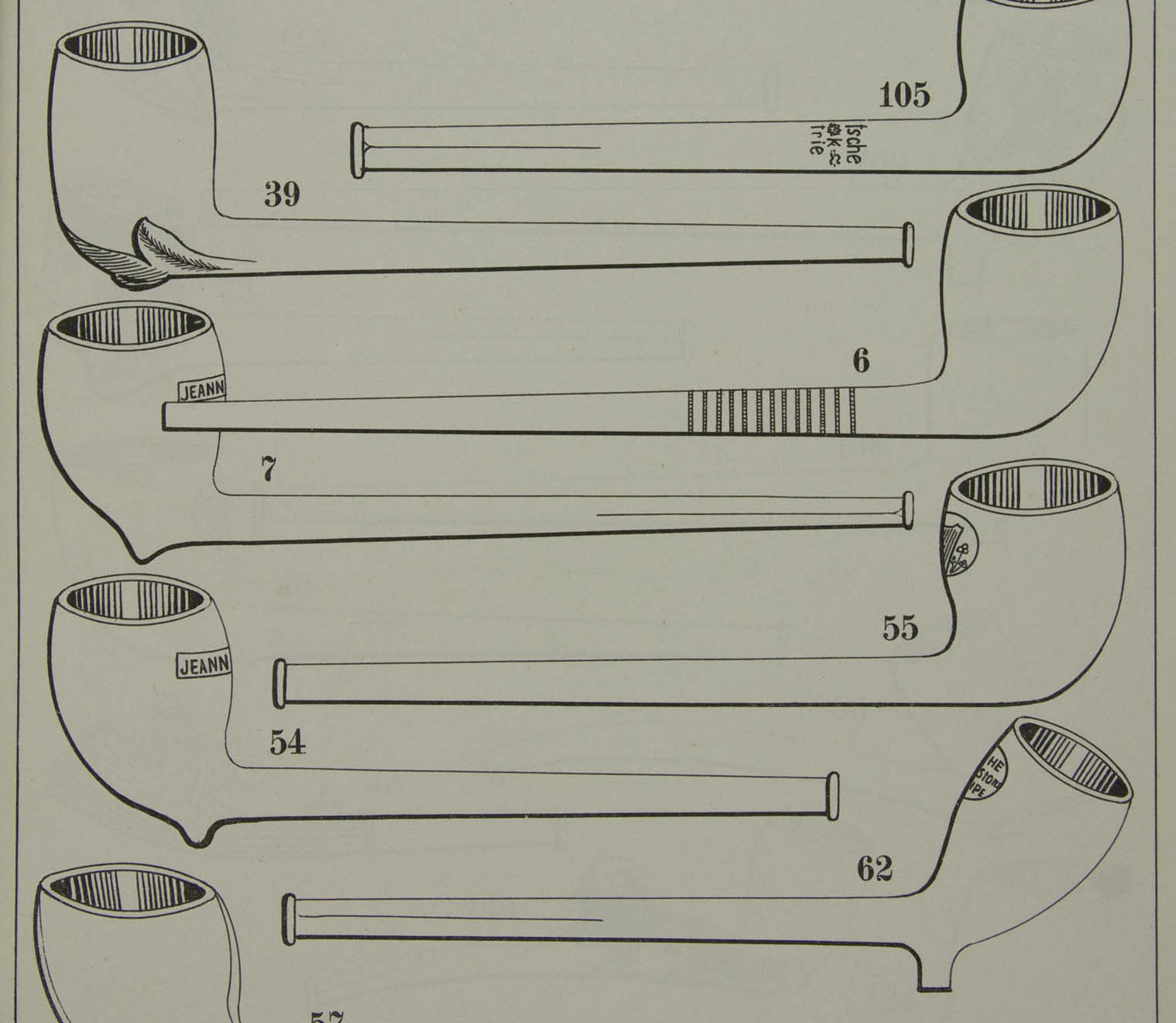
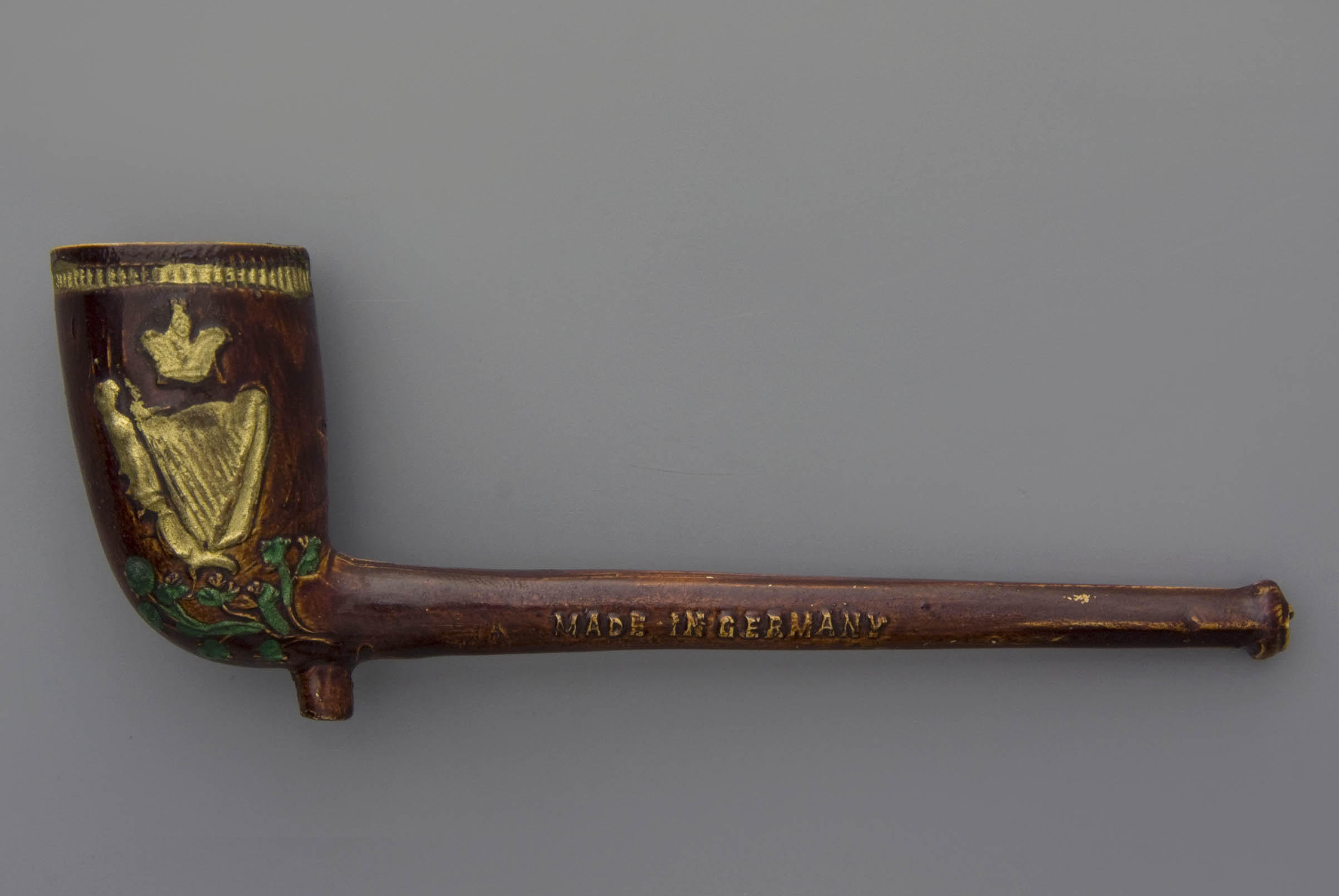
The shapes with a convex bowl and spur are taken from the French makers, marked with "JEAN NICOT" (shape 7, 10, 54) on the bowl as shown by Gambier (Fig. 49). Around 1900 such Nicot pipes are already quite outdated so it is surprising that there are still three versions illustrated in the catalogue. Such pipe shapes were meant to sell in or via France, proved by the stem intaglio "PIPE FRANÇAISE" to make it look optimally French. Labels were also in use with the letters W.K. crowned left and right the text "PIPE FRANÇAISE PARIS". The colours red and blue of the labels had been copied by Klauer from Gambier, but they were also imitated by other factories. Belle in Serves, France and Goedewaagen in Gouda, Holland are two of many. Whether the Jean Nicot pipes were destined for the French market is doubtful, rather these products went to French-speaking export areas round in the world. The outdated style was, after all, no longer suitable for the normally pampered French smoker at that time.
In the late nineteenth century, countless new export shapes came onto the market. We recognize examples in the catalogue. Pipe designs from the European mainland are no longer in demand. Meanwhile, pipe design is determined by the English, Scottish and Irish taste. The Irish influence is not insignificant, which is particularly evident from the inscription "ERIN GO BRACH" (model 84) or the Irish coat of arms (model 55, 60, Fig. 50), although these products were only made to a limited extent in Ireland. Much of this material was produced in England and Scotland and was sold by merchants to America to be distributed among the large group of Irish emigrants. It is a trading pattern initiated by the important pipe merchant Edward Keevil from Dublin.[2] In fact this production line is comparative to the Dorni and 1796 pipes that were invented earlier and similarly found their way to the United States.
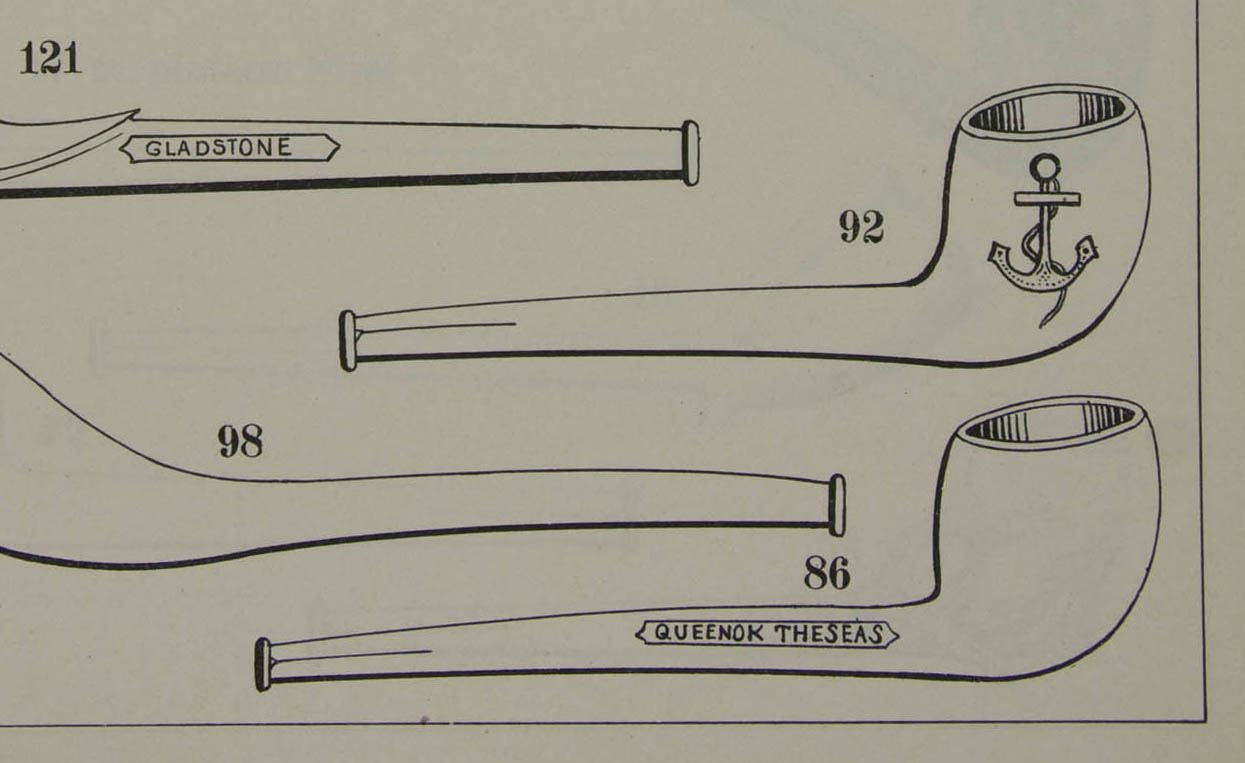
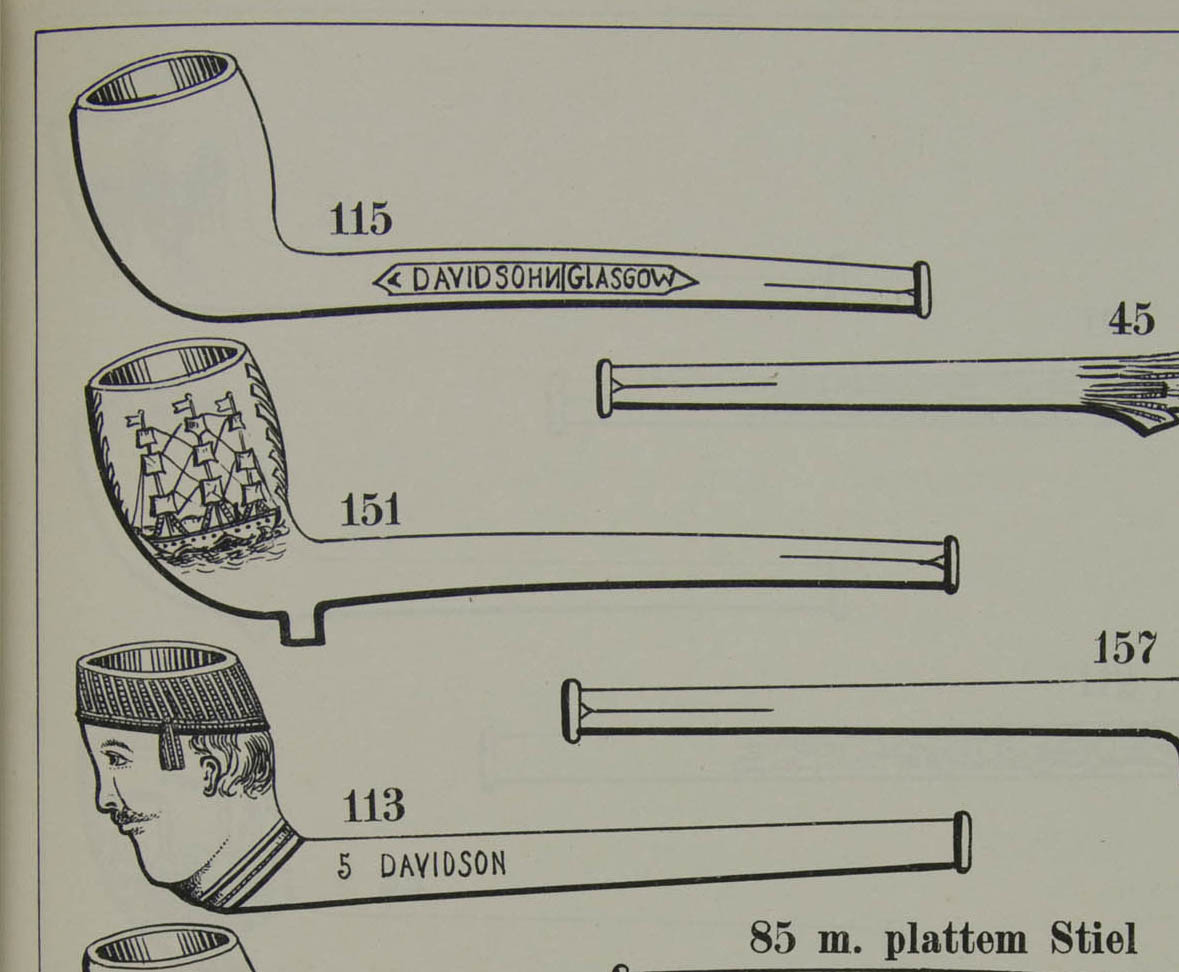
Another phenomenon, closely related to the British industry, concerns pipes with an advertisement for a tobacco brand on the stem. This marketing occurs when large tobacco factories dominate the market and discover the clay pipe as an opportunity for advertisement. On one side of the stem we find "SMOKE" and on the other side a tobacco brand as "QUEEN OF THE SEAS" (shape 86, Fig. 51) or "RIFLE CUTTY" (shape 90). Funny enough, these inscriptions in the catalogue are not always spelled correctly. It turns out that the lithographer had trouble with texts and was possibly even illiterate. Sometimes he wrote the words together or made spelling mistakes like queen ok the seas. With the inscription rifle cutty accidentally the F was changed for a V. The number of mirrored letters also shows lack of practice, especially the letter N often confused the lithographer. Where in the old print "SUNFLOWER" (shape 74) is written correctly, we see in the later print a retrograde letter N.
A tobacco pipe with a stem text like "DAVIDSOHN GLASGOW" (shape 115) seems to be commissioned work, but that is not the case. These are copies of English/Scottish pipes that are sold as a competing article to the same market as the original maker was producing for. Whether the letter H in Sohn inserted intentionally in order not to be guilty of improper copying, or by mistake is unclear. A portrait pipe (shape 113) bears the same inscription but now without the letter H (Fig. 52). Interesting with this pipe is the strong shape-following effect of the male head. An as yet unexplained but older inscription mentions on the bowl side "THE STONE PIPE" (shape 62). Also this pipe was originally an English make.
Some clay pipes carry as stem mark "DEUTSCHE INDUSTRIE", including the initials of the maker: WK (shape 102, 105). The new catalogue shows the first entries of the more modern heading "MADE IN GERMANY" (shape 114) next to the separate word "GERMANY" (shape 170). Shape 114 initially had the title "143 CORK", taken from the original producer or merchant from Ireland. This text will be replaced later for the made in inscription. In doing so this pipe turned into a German industrial product, albeit recreated from elsewhere foreign example. Such shifting patterns are characteristic of the international style, when features from one region are taken over by the other, resulting in a more generalized product .
The catalogue in a wider context
We have seen now that Wilhelm Klauer & Sons supplied a range of clay pipes for the global market. The products can be characterized by a simple design and strong modelling. Although there is a reasonable choice in shapes with and without decorations, the assortment is still limited. It sticks to a restricted range of tobacco and shag pipes of one type with some curiosities as surplus. This makes the products very similar, not to say identical to clay pipes from the English and Scottish centres. To what extend Klauer stands out as a Westerwald factory is as difficult to say. In comparison with the company J. Schilz-Müllenbach from Höhr, which was the same size, we see a similar product range in number and style. Both companies produced more than two hundred different shapes. They were surpassed by two larger factories that were significantly older, Julius Wingender and Müllenbach und Thewald. Their assortment was well above the 500 pipe shapes and they even functioned as a trading house in pipes and related products of all other Westerwald producers.
Furthermore, there were several smaller pipe factories in the Westerwald. We come across a comparable configuration of the assortment in those smaller workshops, although of course with less variation in detail. The reason for the large consistency in the assortment of the Westerwald companies in that period is that their product was predominantly geared to export. Customers were domestic and mainly foreign trade houses that bought in huge quantities with a clean overview of their assortment to offer. The pursuit of turnover was the starting point for the trading house, offering a wide choice was making sales difficult.
The Westerwald therefore delivered bulk goods of a standard quality. These were copied pipe shapes developed in other centres, always in the lower price range. Quality products still came from France where the design level was much higher since the design was better developed. We see that French merit in the Westerwald only at the two largest companies, which also saw a challenge in that particular segment because they literally wanted to deliver everything. The Klauer house had to be satisfied with their position as a quality factory in the medium-sized bulk-goods sector.
In the Westerwald it was not uncommon to outsource orders. The manufacturer owns the production material and allows artisans to enrol in contracts. Then the relevant tools for production are lent to them. Thanks to this method the clay pipes are created for a minimal cost price; the over-all factory costs were avoided. Those who nowadays want to know where the pipes are actually made, will not get an answer. It is not known whether this method was also applied at Klauer’s, even though it seems that the product was predominantly produced in-house. It is possible that work was outsourced to third parties only with extensive rush orders.
The factory catalogue proves which pipe shapes are supplied. Usually this range consisted of conventional products, supplemented with bestsellers from earlier times. Sometimes some prestige products are added to increase the importance of the factory. A catalogue illustrates what you can deliver, but at the same time it creates the risk that what you do not illustrate will never be ordered. In addition to the standard assortment, many manufacturers carry a few proprietary products. They were made on request for a specific customer, for example as an advertising pipe for a tobacco or beverage brand. We do not find these products for incidental orders in the catalogue. They are too specific, in other cases there was an exclusive right of the customer. Sometimes these special editions are regularly included in the assortment, because there was not one candidate with this specific demand, but several.
The two catalogues with a date difference of not more than ten years show how remarkably little changed at this company in ten years. A big difference with, for example, Gouda as city of pipes. There, several pipe makers, who work equally in a stagnating, outdated market, make the switch to the slip casted tobacco pipe. This innovative product brings a huge boost to the industry from 1910, both in terms of production and sales. In the Westerwald, as we have seen, the range remains virtually unchanged during that period, with a slight shift to curio goods. However, the organization of the factory is gradually rationalized. For example, the changes in numbers of stub stemmed pipe bowls to the 400-series takes place. For that reason the pipe bowl with the portrait of Kaiser Wilhelm II changes number from 208 to 408. Developments in this branch thus take place in small steps. The two prints of the catalogues of the Wilhelm Klauer & Sons company show these minor shifts with the differences in detail. It seems that Klauer experienced a considerable growth from 1890 onwards. Germany is still an important nation at the beginning of the twentieth century. The German Union under Bismarck aims to become a world power. They try to obtain colonies and stimulate foreign sales. With the outbreak of the First World War in 1914, that suddenly came to a stop. Four years of struggle will follow with a humiliating peace afterwards. During the war there are export blockades, after which the German product is barely in favour anymore. Klauer appears to be growing well until 1914. Then there is an acute decline in demand and therefore in profits. In this way the growth of the company stagnated.
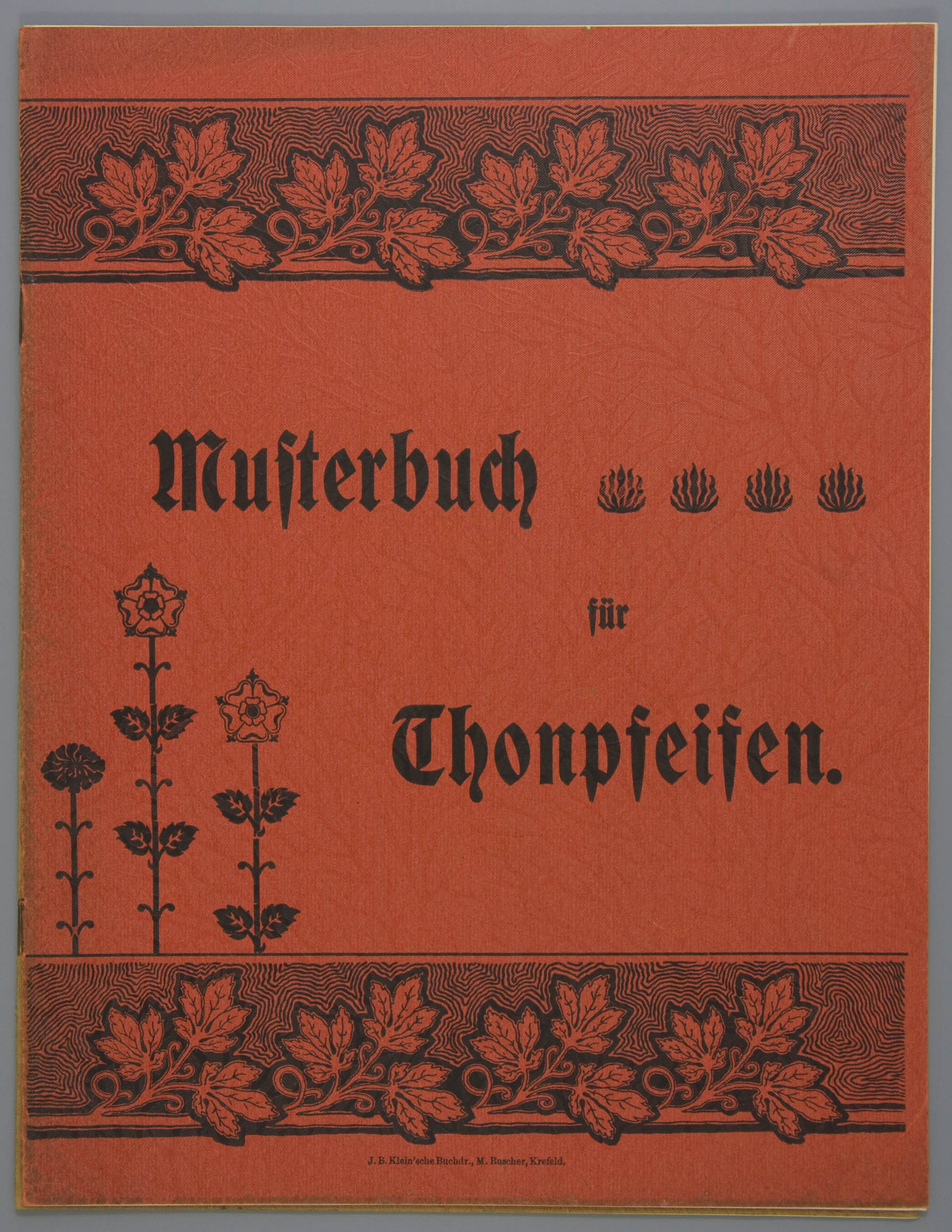

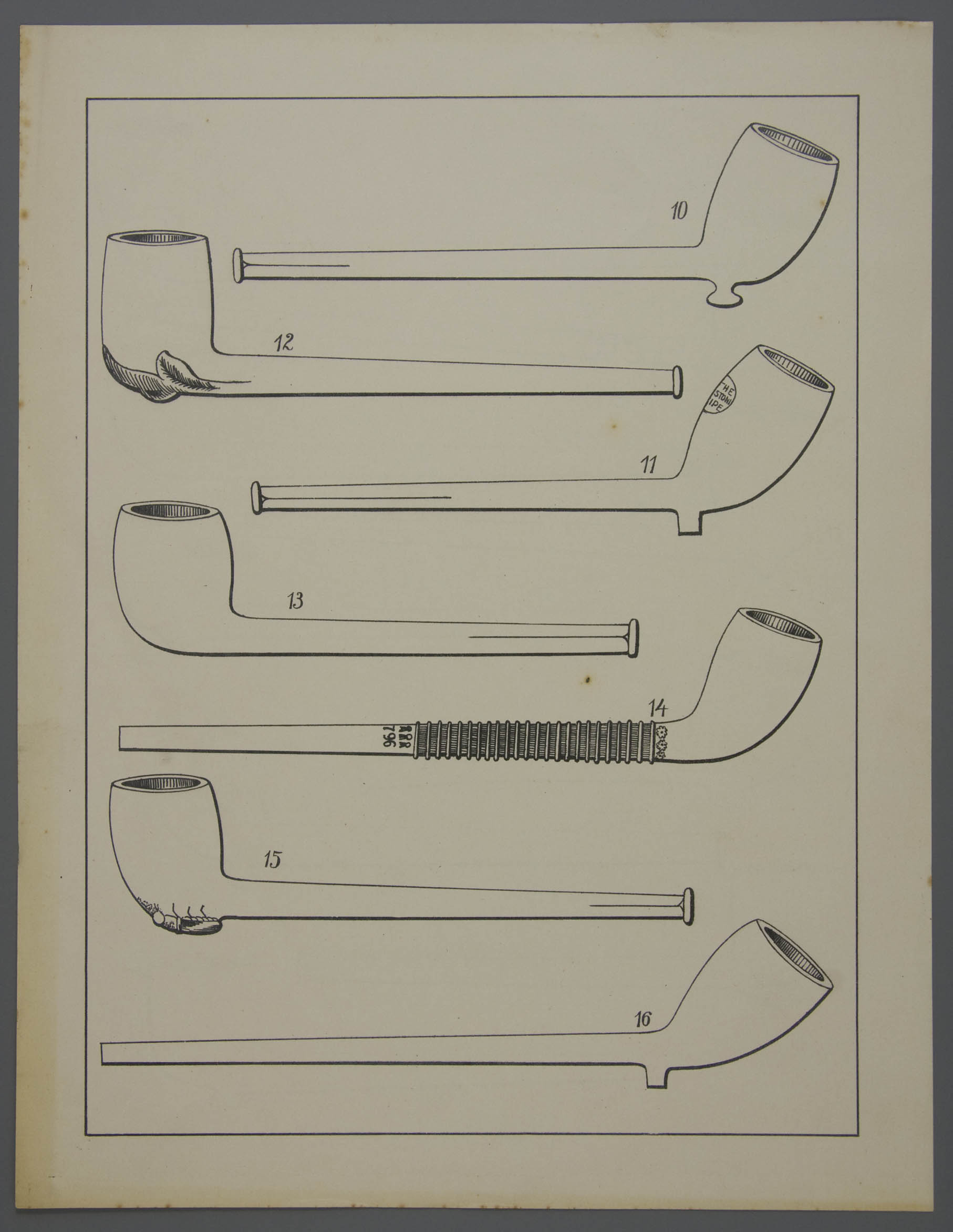
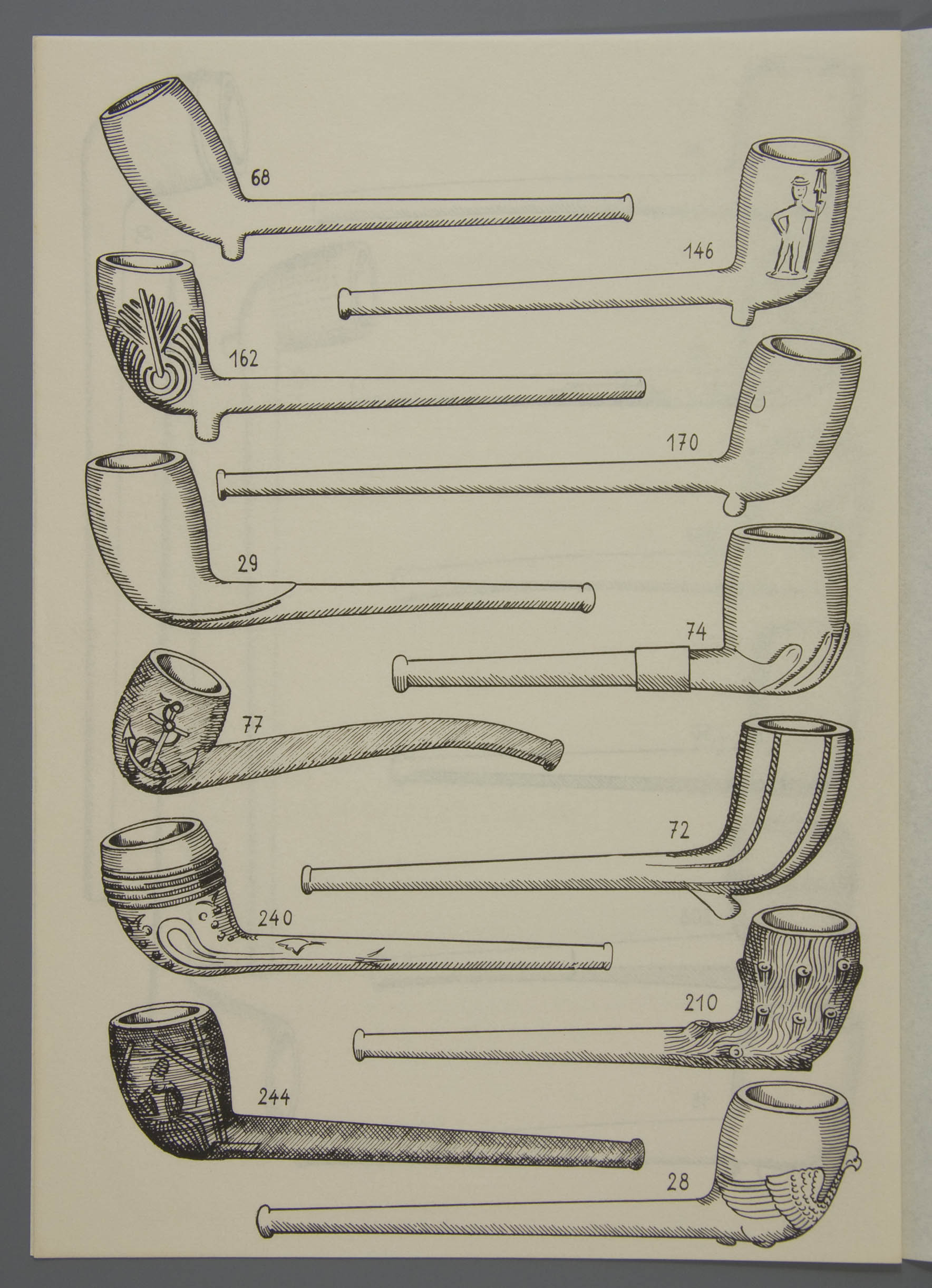
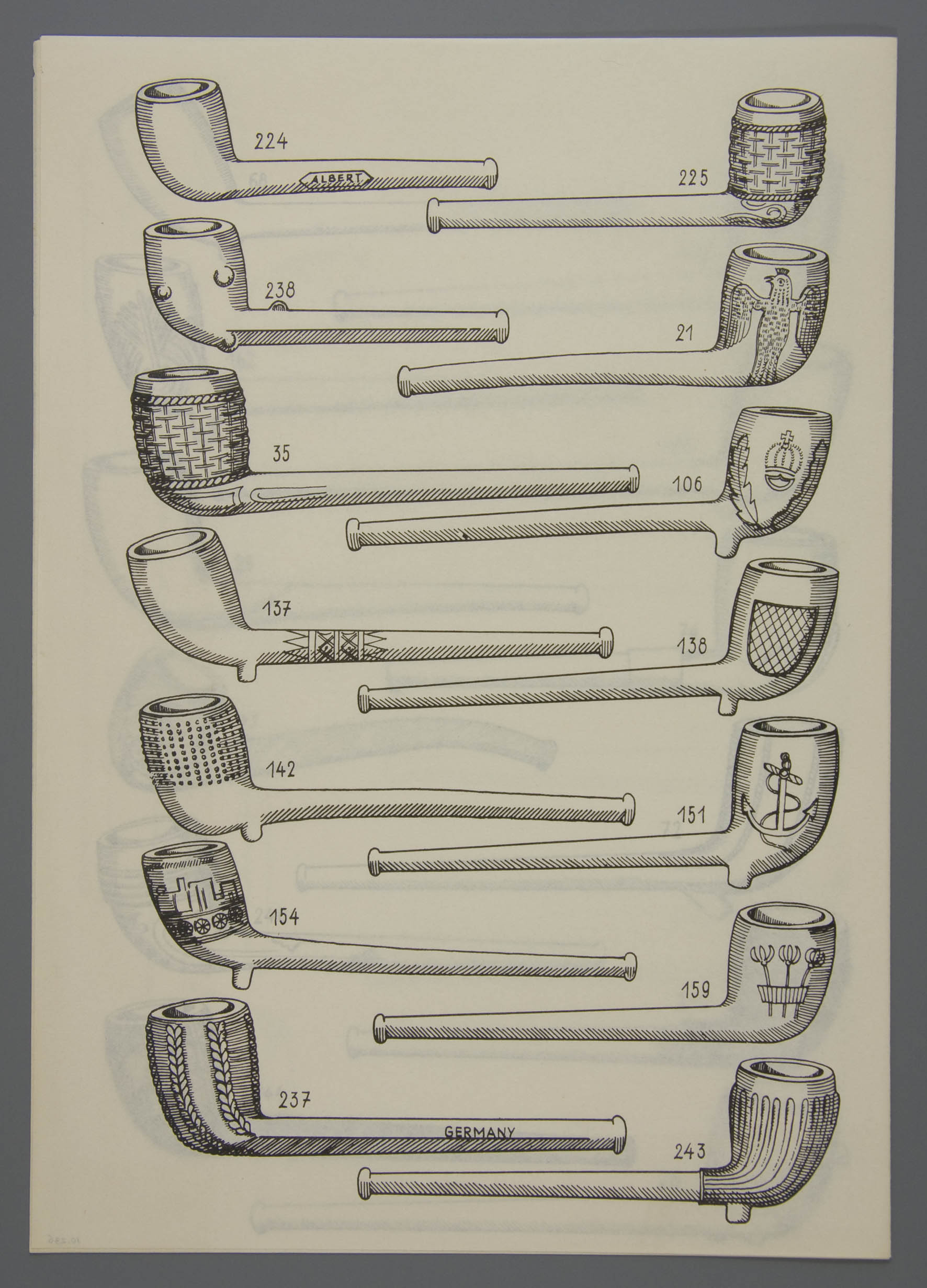
The catalogues of Wilhelm Klauer Söhne, discussed here, were used in combination with other printed matter. For example, some so-called Musterbücher are preserved (Fig. 53). Once again these are well-cared-for catalogues in large size, but now with only 82 simple pipe shapes, a third of the content of the large catalogue. Obviously, this is a slimmed-down range of stereotypes for mass bulk pipes from the period up to the First World War. They were intended for traders and representatives who sold their assortment under their own name and at their own prices.
The extensive catalogue was primarily intended for the representative or traveling salesman visiting the shops. It is shown at both trading houses and shop visits to elicit orders. Only the best customers receive a copy as a gift, so that they can easily make repeat orders. The Musterbuch was destined for the privately operating trader and will be distributed very selectively. For advertising by overseas mail Klauer used even much thinner, simpler model pages. A single copy has been preserved, with for instance only sixteen pipes (Fig. 54), used as a counterpart to the catalogue with the red cover. Without exception, these abbreviated catalogues contain smooth pipes, including some models with simple stem decorations. When decorated clay pipes were published, it concerns simple pipes with a fly or leaf motif on the heel of the pipe. In later years Klauer issues a catalogue printed on thin airmail paper (Fig. 55). With this document, mostly cutties have been depicted over two printed sheets. Exceptions are three slightly longer shapes that have been rearranged in length. This catalogue shows more decorated pipes. Evidently the fashion of the export pipe has shifted, but there is no question of renewal. The separation what was and what was not suitable for export and where to, remains unclear for the time being. The lifespan of the clay pipe is so short that it did not survive in the countries of destination.
Epilogue
Thanks to both catalogues and the additional printed matter, we were informed about the products of Wilhelm Klauer & Sons. An amazing fact is that a sample collection of pipes was also kept of this factory, that ended up in the Pijpenkabinet collections. This group represents most pipe shapes from the catalogues. This completes our understanding of the quality of the product from the period of the two catalogues. These products confirm the sharp press moulding and good workmanship. Although it is clearly a factory product, the range is representative of medium-sized businesses in the Westerwald at the beginning of the twentieth century. This sample collection also ensured the illustrations in this article.
How strange it may sound, it is nearly impossible to date the two catalogues, neither the preserved pipes from Klauwer. The firm exists since 1863 and survived until present day! The two catalogues are the only ones ever printed in over 150 years, and the one in red cover in the Pijpenkabinet collection is even the single one ever seen! If we assume that the German pipe making firms would not produce for others than the local market during the years 1914-1925, and again from 1940-1945, the catalogues should date from before 1914.
Hoe vreemd het ook mag klinken, het is bijna onmogelijk om de twee catalogi te dateren, noch de bewaarde pijpen van Klauwer. Het bedrijf bestaat sinds 1863 en heeft tot op de dag van vandaag stand gehouden! De twee catalogi zijn de enige die in meer dan 150 jaar zijn gedrukt, en die met rode kaft in de collectie van het Pijpenkabinet is zelfs de enige die ooit is gezien! Als we aannemen dat de Duitse pijpenfabrikanten in de jaren 1914-1925 en opnieuw van 1940-1945 niet voor anderen dan de lokale markt zouden produceren, dan zouden de catalogi van vóór 1914 moeten zijn.
The publication Century of Change has already shown that a stream of catalogues was produced in the German Westerwald in the first two decades of the twentieth century.[3] The main differences are in the size of the range, not so much in the appearance of the product. This article shows how that range is built up. When we look at the pipes over time, we notice that there was hardly any product development during that period. There is endless copying over and over again, but new designs are extremely scarce and always within restrictions of the same concept. An extensive standardization has now taken place internationally among exporting companies. This so-called international style was determined by the trading companies that did not want to get lost in an unlimited choice. They thus determined the appearance, quality and degree of luxury of the goods produced.

The two catalogues give us a new opportunity to interpret Klauer's position as a medium-sized company in the Westerwald in the first decade of the twentieth century. Until the First World War, production there remains relatively unchanged, although there is a gradual decline. However, the war as changing point is seriously affecting the trade position of the Westerwald. After the peace of 1918, the industry slips away, mainly because of the changed smoking habit in which greater luxury is in demand, supplied by different companies making briar pipes. The clay pipe companies transform into workshops for mass production, with product quality gradually declining. The deployed line of the by-products becomes the main line for some companies. Klauer still exists fifty years later, but then runs on shooting pipes, Weckmännchen (Fig. 56) and novelties, no longer on smoking pipes. The company went along with its time, mechanization set in, while the noble handwork disappeared and the product transformed into a disposable article without smoke function.
© Don Duco, Pijpenkabinet Foundation, Amsterdam – the Netherlands, 2012.
Illustrations
- Cover of the catalogue. Baumbach, Wilhelm Klauer Söhne, 1895-1905.
Amsterdam, Pijpenkabinet collections Pk 16.839a - Cover of the catalogue. Baumbach, Wilhelm Klauer Söhne, 1905-1915.
Amsterdam, Pijpenkabinet collections Pk 16.839b - First page with colour showing two red pipes and coloured labels. Baumbach, Wilhelm Klauer Söhne, 1905-1915.
Amsterdam, Pijpenkabinet collections Pk 16.839b - Catalogue page with clay pipes in French style with colourful painted enamel. Baumbach, Wilhelm Klauer Söhne, 1905-1915.
Amsterdam, Pijpenkabinet collections Pk 16.839b - Catalogue page with fully glazed and brown lacquered clay pipes. Baumbach, Wilhelm Klauer Söhne, 1905-1915.
Amsterdam, Pijpenkabinet collections Pk 16.839b - Shag pipe with tulip-shaped bowl finished with bright yellow glaze. Baumbach, Wilhelm Klauer und Söhne, 1910-1920.
Amsterdam, Pijpenkabinet collections Pk 6.021 - Catalogue page with calcine burnt clay pipes. Baumbach, Wilhelm Klauer Söhne, 1905-1915.
Amsterdam, Pijpenkabinet collections Pk 16.839b - Pipe with so-called ambre finish. Baumbach, Wilhelm Klauer und Söhne, 1900-1915.
Amsterdam, Pijpenkabinet collections Pk 6.818 - Last page of the catalogue with pipe bowls and figurines. Baumbach, Wilhelm Klauer Söhne, 1905-1915.
Amsterdam, Pijpenkabinet collections Pk 16.839b - Catalogue page with clay pipes turned a quarter. Baumbach, Wilhelm Klauer Söhne, 1905-1915.
Amsterdam, Pijpenkabinet collections Pk 16.839b - Catalogue page 7 with Peter Dorni pipe. Baumbach, Wilhelm Klauer Söhne, 1905-1915.
Amsterdam, Pijpenkabinet collections Pk 16.839b - Tobacco pipe with stem inscription "PETER DORNI". Baumbach, Wilhelm Klauer Söhne, 1910-1920.
Amsterdam, Pijpenkabinet collections Pk 6.010 - Tobacco pipe with stem in relief and date 1796. Baumbach, Wilhelm Klauer Söhne, 1900-1920.
Amsterdam, Pijpenkabinet collections Pk 6.175 - Catalogue page 3 with shape 171 with curved pipe bowl. Baumbach, Wilhelm Klauer Söhne, 1905-1915.
Amsterdam, Pijpenkabinet collections Pk 16.839b - Tobacco pipe with curved pipe bowl and side mark Gouda arms on the heel. Baumbach, Wilhelm Klauer Söhne, 1900-1920.
Amsterdam, Pijpenkabinet collections Pk 6.180 - Tobacco pipe with Duitser bowl, without heel and straight stem. Baumbach, Wilhelm Klauer Söhne, 1900-1920.
Amsterdam, Pijpenkabinet collections Pk 6.182 - Catalogue illustration of so-called randduitser. Baumbach, Wilhelm Klauer Söhne, 1905-1915.
Amsterdam, Pijpenkabinet collections Pk 16.839b - Tobacco pipe shape randduitser with orange stem end. Baumbach, Wilhelm Klauer Söhne, 1910-1920.
Amsterdam, Pijpenkabinet collections Pk 6.187 - Catalogue page with shag pipes with different decorations. Baumbach, Wilhelm Klauer Söhne, 1905-1915.
Amsterdam, Pijpenkabinet collections Pk 16.839b - Shag pipe with anchor and ship. Baumbach, Wilhelm Klauer Söhne, 1910-1920.
Amsterdam, Pijpenkabinet collections Pk 6.074 - Shag pipe with king’s crown and thistle leaves. Baumbach, Wilhelm Klauer Söhne, 1910-1920.
Amsterdam, Pijpenkabinet collections Pk 6.067 - Shag pipe with king’s crown and tobacco advertising "SMOKE RIFLE CUTTY". Baumbach, Wilhelm Klauer Söhne, 1920-1930.
Amsterdam, Pijpenkabinet collections Pk 6.863 - Catalogue page with two cigar holders. Baumbach, Wilhelm Klauer Söhne, 1905-1915.
Amsterdam, Pijpenkabinet collections Pk 16.839b - Cigar holder in Viennese style with lying dog. Baumbach, Wilhelm Klauer Söhne, 1910-1920.
Amsterdam, Pijpenkabinet collections Pk 1.274 - Catalogue page with so-called "CIGARETTENPFEIFCHEN". Baumbach, Wilhelm Klauer Söhne, 1905-1915.
Amsterdam, Pijpenkabinet collections Pk 16.839b - Cigarette pipe with bird claw at the bowl base. Baumbach, Wilhelm Klauer Söhne, 1900-1920.
Amsterdam, Pijpenkabinet collections Pk 138 - Catalogue page with shooting figures. Baumbach, Wilhelm Klauer Söhne, 1905-1915.
Amsterdam, Pijpenkabinet collections Pk 16.839b - Catalogue page with figural whistles. Baumbach, Wilhelm Klauer Söhne, 1905-1915.
Amsterdam, Pijpenkabinet collections Pk 16.839b - Whistle with bust of Graf Zeppelin. Baumbach, Wilhelm Klauer Söhne, 1920-1940.
Amsterdam, Pijpenkabinet collections Pk 1.420b - Catalogue page 1 first edition with a starter of prestigious pipes. Baumbach, Wilhelm Klauer Söhne, 1895-1905.
Amsterdam, Pijpenkabinet collections Pk 16.839a - Catalogue page 1 second edition with a complete set of prestigious pipes. Baumbach, Wilhelm Klauer Söhne, 1905-1915.
Amsterdam, Pijpenkabinet collections Pk 16.839b - Catalogue page 2 second edition. Baumbach, Wilhelm Klauer Söhne, 1905-1915.
Amsterdam, Pijpenkabinet collections Pk 16.839b - Tobacco pipe in the shape of a walnut. Baumbach, Wilhelm Klauer Söhne, 1900-1920.
Amsterdam, Pijpenkabinet collections Pk 1.279 - Tobacco pipe with Marseillaise decoration and covered with yellow lacquer. Baumbach, Wilhelm Klauer Söhne, 1890-1910.
Amsterdam, Pijpenkabinet collections Pk 6.041 - Tobacco pipe with the arms of Australia. Baumbach, Wilhelm Klauer Söhne, 1910-1920.
Amsterdam, Pijpenkabinet collections Pk 6.015a - Tobacco pipe with standing Maria as pilgrim pipe for Hardenberg. Baumbach, Wilhelm Klauer Söhne, 1900-1915.
Amsterdam, Pijpenkabinet collections Pk 3.014 - Catalogue page of tobacco pipe with figural fish. Baumbach, Wilhelm Klauer Söhne, 1905-1915.
Amsterdam, Pijpenkabinet collections Pk 16.839b - Tobacco pipe in the shape of a fish. Baumbach, Wilhelm Klauer Söhne, 1910-1930.
Amsterdam, Pijpenkabinet collections Pk 8.360 - Shag pipe the bowl the head of a cuirassier. Baumbach, Wilhelm Klauer Söhne, 1900-1910.
Amsterdam, Pijpenkabinet collections Pk 6.326 - Catalogue page showing tobacco pipes with the busts of General De Wet and Queen Wilhelmina. Baumbach, Wilhelm Klauer Söhne, 1905-1915.
Amsterdam, Pijpenkabinet collections Pk 16.839b - Tobacco pipe representing General De Wet. Baumbach, Wilhelm Klauer Söhne, 1900-1920.
Amsterdam, Pijpenkabinet collections Pk 6.061b - Tobacco pipe representing Queen Wilhelmina. Baumbach, Wilhelm Klauer Söhne, 1900-1920.
Amsterdam, Pijpenkabinet collections Pk 6.009b - Catalogue page with stub stemmed pipe bowl with the head of emperor Wilhelm II. Baumbach, Wilhelm Klauer Söhne, 1905-1915.
Amsterdam, Pijpenkabinet collections Pk 16.839b - Catalogue illustration of the so-called Kaffeehauspfeife. Baumbach, Wilhelm Klauer Söhne, 1905-1915.
Amsterdam, Pijpenkabinet collections Pk 16.839b - Tobacco pipe with Kaffeehaus shape. Baumbach, Wilhelm Klauer Söhne, 1900-1930.
Amsterdam, Pijpenkabinet collections Pk 2.779 - Tobacco pipe with longitudinal ribbed zones and cuff. Baumbach, Wilhelm Klauer Söhne, 1900-1920.
Amsterdam, Pijpenkabinet collections Pk 6.005 - Tobacco pipe with export mark TD on the bowl. Baumbach, Wilhelm Klauer Söhne, 1910-1920.
Amsterdam, Pijpenkabinet collections Pk 7.216 - Cigarette pipe with curved bowl with embossed mark TD. Baumbach, Wilhelm Klauer Söhne, 1910-1920.
Amsterdam, Pijpenkabinet collections Pk 6.874 - Catalogue page with tobacco pipe in so-called Jean Nicot shape. Baumbach, Wilhelm Klauer Söhne, 1905-1915.
Amsterdam, Pijpenkabinet collections Pk 16.839b - Tobacco pipe with arms of Ireland, torrified and gilded. Baumbach, Wilhelm Klauer Söhne, 1910-1925.
Amsterdam, Pijpenkabinet collections Pk 6.014 - Catalogue page with pipe advertising for tobacco brand "QUEEN OF THE SEAS". Baumbach, Wilhelm Klauer Söhne, 1905-1915.
Amsterdam, Pijpenkabinet collections Pk 16.839b - Pipe with portrait with stem text "DAVIDSON". Baumbach, Wilhelm Klauer Söhne, 1905-1915.
Amsterdam, Pijpenkabinet collections Pk 16.839b - Catalogue for resellers. Baumbach, Wilhelm Klauer Söhne, 1895-1910.
Amsterdam, Pijpenkabinet collections Pk 19.352a - Catalogue sheet with sixteen clay pipes. Baumbach, Wilhelm Klauer Söhne, 1900-1910.
Amsterdam, Pijpenkabinet collections Pk 10.235 - Catalogue on airmail paper. Baumbach, Wilhelm Klauer Söhne, 1910-1925.
Amsterdam, Pijpenkabinet collections Pk 10.236 - Bun with machine-made clay pipe. Baumbach, Wilhelm Klauer Söhne, 1979-1980.
Amsterdam, Pijpenkabinet collections Pk 13.344b
Notes
[1] Don Duco, Century of Change, the European clay pipe, its final flourish and ultimate fall, Amsterdam, 2004.
[2] Don Duco, 'Kwesties rond merken van handelshuizen', Pijpelijntjes, VIII/4, 1982.
[3] Ibidem, (Century of Change), 2004, chapter 18, ill. 2, 234-237.